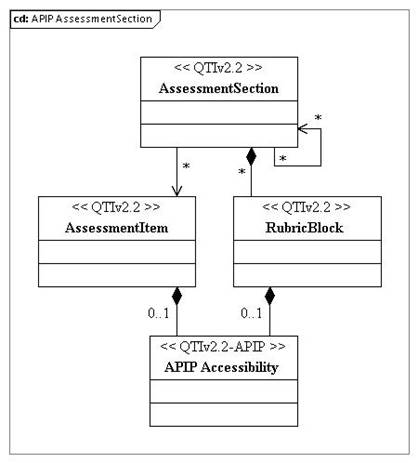
1EdTech Accessible Portable Item Protocol™ (APIP™): Technical Specification
Final Specification
Version 1.0
Date Issued: 31 March 2014
Latest version: http://www.imsglobal.org/apip/
IPR and Distribution Notices
Recipients of this document are requested to submit, with their comments, notification of any relevant patent claims or other intellectual property rights of which they may be aware that might be infringed by any implementation of the specification set forth in this document, and to provide supporting documentation.
1EdTech draws attention to the fact that it is claimed that compliance with this specification may involve the use of Measured Progress U.S. patent 8,303,309. 1EdTech takes no position concerning the evidence, validity or scope of such patent rights. Measured Progress has assured 1EdTech that it is willing to license patent rights it owns or controls which would necessarily be infringed by any implementation of this specification to those licensees (Members and non-Members alike) desiring to implement this specification. The statement of Measured Progress to such effect has been filed with 1EdTech. Information regarding a Reasonable and Non-Discriminatory - Zero cost (RAND-Z) license may be obtained from Measured Progress at http://www.measuredprogress.org/ipr-apip.
1EdTech takes no position regarding the validity or scope of any intellectual property or other rights that might be claimed to pertain to the implementation or use of the technology described in this document or the extent to which any license under such rights might or might not be available; neither does it represent that it has made any effort to identify any such rights. Information on 1EdTech's procedures with respect to rights in 1EdTech specifications can be found at the 1EdTech Intellectual Property Rights web page: http://www.imsglobal.org/ipr/imsipr_policyFinal.pdf.
Copyright © 2012-14 1EdTech Consortium. All Rights Reserved.
Use of this specification to develop products or services is governed by the license with 1EdTech found on the 1EdTech website: http://www.imsglobal.org/speclicense.html.
Permission is granted to all parties to use excerpts from this document as needed in producing requests for proposals.
The limited permissions granted above are perpetual and will not be revoked by 1EdTech or its successors or assigns.
THIS SPECIFICATION IS BEING OFFERED WITHOUT ANY WARRANTY WHATSOEVER, AND IN PARTICULAR, ANY WARRANTY OF NONINFRINGEMENT IS EXPRESSLY DISCLAIMED. ANY USE OF THIS SPECIFICATION SHALL BE MADE ENTIRELY AT THE IMPLEMENTER'S OWN RISK, AND NEITHER THE CONSORTIUM, NOR ANY OF ITS MEMBERS OR SUBMITTERS, SHALL HAVE ANY LIABILITY WHATSOEVER TO ANY IMPLEMENTER OR THIRD PARTY FOR ANY DAMAGES OF ANY NATURE WHATSOEVER, DIRECTLY OR INDIRECTLY, ARISING FROM THE USE OF THIS SPECIFICATION.
Public contributions, comments and questions can be posted here: http://www.imsglobal.org/community/forum/categories.cfm?catid=110
© 2014 1EdTech Consortium, Inc.
All Rights Reserved.
The 1EdTech Logo, Accessible Portable Item Protocol (APIP), and Question and Test Interoperability (QTI) are trademarks of the 1EdTech Consortium, Inc. in the United States and/or other countries.
Document Name: 1EdTech APIP Technical Specification Overview - Revision: 31 March 2014
Executive Summary
This document contains the technical specification of the Accessible Portable Item Protocol™ (APIP™) Standard. The APIP Standard provides assessment programs and question item developers a data model for standardizing the file format of digital test items. When applied properly, the APIP standard accomplishes two important goals. First, the APIP standard allows digital tests and items to be ported across APIP compliant test and item banks. Second, it provides a test delivery interface with all the information and resources required to make a test item accessible for students with a variety of disabilities and special needs. In this version of the APIP Standard the focus is on:
a) Enabling the exchange of accessible Tests and Items accompanied with the appropriate accessibility-focused alternative content representations and the corresponding companion tools;
b) Adopting, wherever possible, established learning technology interoperability standards and specifications, and only extending these when required;
c) Ensuring that the solution can be readily expanded, at a later date, to support test result information, etc.
d) Ensuring the solution can be combined with other 1EdTech and non-1EdTech specifications to support new functionality e.g. the reporting of assessment scores and outcomes;
e) Ensuring that further profiling can be undertaken to tailor the approach to meet the needs of specific State assessment activities without compromising the baseline interoperability requirement and capability;
f) Enabling vendors to adopt the solution without constraining their ability to create market-differentiated products and services.
The APIP standard builds on the 1EdTech Question and Test Interoperability™ (QTI™) v2.2 specification; this in turn makes use of the 1EdTech Content Packaging (CP) v1.2 specification. QTI is based on assessmentItem and assessmentTest models that allow question developers to specify a variety of information for a test (an assessmentTest consists of one or more assessmentItems). The APIP Standard expands the QTI model into a comprehensive framework that encompasses the requirements for creating accessible tests. The 1EdTech Access For All Personal Needs & Preferences (AfA PNP) v2.0 specification is also used as the basis for supplying the user preferences when using an APIP-enabled system. It is these accessibility preferences that are used by an assessment system to tailor the presentation of the question items to fit the accessibility needs of the user.
The technical specification work has involved the development of extensions to the base 1EdTech specifications and profiling of several 1EdTech and non-1EdTech specifications. Profiling is the process by which, one or more specifications, are tailored and combined to provide a best practice solution. It is this combination of specifications that makes the APIP a powerful solution.
1. Introduction
1.1. Scope and Context
The Accessible Portable Item Protocol (APIP) Standard provides assessment programs and question item developers a data model for standardizing the file format of digital test items. When applied properly, the APIP standard accomplishes two important goals. First, the APIP standard allows digital test items to be ported across APIP compliant test and item banks. Second, it provides a test delivery interface with all the information and resources required to make a test item accessible for students with a variety of disabilities and special needs.
The APIP standard builds on the 1EdTech Question and Test Interoperability (QTI) v2.2 specification [QTI, 12a]; this in turn makes use of the 1EdTech Content Packaging (CP) v1.2 specification [CP, 07a]. QTI is based on AssessmentItem and AssessmentTest models that allow question developers to specify a variety of information for a test (an AssessmentTest consists of one or more AssessmentItems). The APIP Standard expands the QTI model into a comprehensive framework that encompasses the requirements for creating accessible tests. The 1EdTech Access For All Personal Needs & Preferences (AfA PNP) v2.0 specification is also used as the basis for supplying the user preferences when using an APIP-enabled system.
This document contains the description of the profiles of the source specifications upon which APIP is based. This document should be used in conjunction with the APIP Technical Specification Overview [APIP, 14a], the set of APIP Terms & Definitions [APIP, 14b], the set of APIP Use Cases [APIP, 14c] the specification of the new features defined in APIP [APIP, 14d], [APIP, 14e], the best practice and implementation guide [APIP, 14f] and the conformance and compliance specification [APIP, 14g].
1.2. Structure of this Document
The structure of the rest of this document is:
|
2. Architecture and Approach |
The architectural approach in terms of its functional and data models; |
|
3. Profile Instance Binding Model |
Overview of the detailed profile of the set of 1EdTech base specifications and new information models. The binding details are described in Appendices A, B and C; |
|
4. Profile System Behavioral Model |
The description of how the end systems are to process the APIP data formats to which they have access; |
|
5. Issues of Compatibility |
A brief discussion of compatibility between the APIP and other profiles of the 1EdTech QTI and related specifications; |
|
Appendix A The Profile Binding Instance Descriptions |
The profiling of the set of 1EdTech base specifications, and the usage of the new data model specifications, to meet the APIP interoperability requirements; |
|
Appendix B Profile Platform Specific Models |
The set of platform specific models that have been used to generate the set of XSDs; |
|
Appendix C XSD Binding for the Profile |
The details for the set of XSDs themselves. |
1.3. Related Documents
[AfADRD, 09] Access For All Digital Resource Description Information Model v2.0, R.Schwerdtfeger, M.Rothberg and C.Smythe, Final Release, 1EdTech, October 2009.
[AfAPNP, 09] Access For All Personal Needs & Preferences Information Model v2.0, R.Schwerdtfeger, M.Rothberg and C.Smythe, Final Release, 1EdTech, April 2010.
[APIP, 14a] Accessible Portable Item Protocol (APIP) v1.0: Technical Specification Overview v1.0, Final Specification, G.Driscoll, T.Hoffmann, W.Ostler, M.Russell, M.McKell and C.Smythe, 1EdTech, March 2014.
[APIP, 14b] Accessible Portable Item Protocol (APIP) v1.0: Terms & Definitions v1.0, Final Specification, G.Driscoll, T.Hoffmann, W.Ostler, M.Russell, M.McKell and C.Smythe, 1EdTech, March 2014.
[APIP, 14c] Accessible Portable Item Protocol (APIP) v1.0: Use Cases v1.0, Final Specification, G.Driscoll, T.Hoffmann, W.Ostler, M.Russell, M.McKell and C.Smythe, 1EdTech, March 2014.
[APIP, 14d] Accessible Portable Item Protocol (APIP): Technical Specification of QTIv2.1 New Features v1.0, Final Specification, G.Driscoll, T.Hoffmann, W.Ostler, M.Russell, M.McKell and C.Smythe, 1EdTech, March 2014.
[APIP, 14e] Accessible Portable Item Protocol (APIP): Technical Specification of AfA PNPv2.0 New Features v1.0, Final Specification, G.Driscoll, T.Hoffmann, W.Ostler, M.Russell, M.McKell and C.Smythe, 1EdTech, March 2014.
[APIP, 14f] Accessible Portable Item Protocol (APIP): Best Practice & Implementation Guide, Final Specification, G.Driscoll, T.Hoffmann, W.Ostler, M.Russell and C.Smythe, 1EdTech, March 2014.
[APIP, 14g] Accessible Portable Item Protocol (APIP): Conformance & Compliance, Final Specification, G.Driscoll, T.Hoffmann, W.Ostler, M.Russell, M.McKell and C.Smythe, 1EdTech, March 2014.
[CC, 11] Common Cartridge v1.2, Ed. J.Kahn, Final Release, 1EdTech, October 2011.
[CP, 07a] Content Packaging Information Model v1.2, W.Kraan, J.Posten-Day, N.Ward, N.Boyd and C.Smythe, CM/DN Revision 2, 1EdTech, March 2007.
[CP, 07b] Content Packaging Best Practice & Implementation Guide v1.2, W.Kraan, J.Posten-Day, N.Ward, B.Nielsen and C.Smythe, CM/DN Revision 2, 1EdTech, March 2007.
[CP, 07c] Content Packaging XML Binding v1.2, W.Kraan, J.Posten-Day, N.Ward, N.Boyd and C.Smythe, CM/DN Revision 2, 1EdTech, March 2007.
[CP, 07d] Content Packaging Primer v1.2, W.Kraan, J.Posten-Day, N.Ward, N.Boyd and C.Smythe, CM/DN Revision 2, 1EdTech, March 2007.
[LOM, 02] IEEE 1484.12.1-2002 Standard for Learning Object Metadata, The Institute of Electrical and Electronics Engineers Inc., 2002. ISBN:0-7381-3297-7.
[LOM, 05] IEEE 1484.12.3-2005: LOM Schema Binding,The Institute of Electrical and Electronics Engineers Inc., 2005.
[LTI, 12] Learning Tools Interoperability Implementation Guidelines v1.1 Ed. C.Severance, Final Specification, 1EdTech, March 2012.
[QTI, 12a] Question & Test Interoperability Assessment Test, Section and Item Information Model v2.1, S.Lay, P.Gorissen and W.Kraan, Final Release, 1EdTech, August 2012.
[QTI, 12b] Question & Test Interoperability XML Binding v2.1, S.Lay, P.Gorissen and W.Kraan, Final Release, 1EdTech, August 2012.
[QTI, 12c] Question & Test Interoperability Implementation Guide v2.1, S.Lay, P.Gorissen and W.Kraan, Final Release, 1EdTech, August 2012.
[QTI, 12d] Question & Test Interoperability Conformance Guide v2.1, S.Lay, P.Gorissen and W.Kraan, Final Release, 1EdTech, August 2012.
[QTI, 12e] Question & Test Interoperability Metadata and Usage Data v2.1, S.Lay, P.Gorissen and W.Kraan, Final Release, 1EdTech, August 2012.
[QTI, 12f] Question & Test Interoperability Migration Guide v2.1, S.Lay, P.Gorissen and W.Kraan, Final Release, 1EdTech, August 2012.
[QTI, 12g] Question & Test Interoperability Overview v2.1, S.Lay, P.Gorissen and W.Kraan, Final Release, 1EdTech, August 2012.
[QTI, 12h] Question & Test Interoperability Results Reporting v2.1, S.Lay, P.Gorissen and W.Kraan, Final Release, 1EdTech, August 2012.
1.4. Acronyms
ACCLIP Access For All Learner Information Package
AfA DRD Access for All Digital Resource Description
AfA PNP Access for All Personal Needs & Preferences
APIP Accessible Portable Item Protocol
CC Common Cartridge
CSS Cascading Style Sheets
CP Content Packaging
CSM Curriculum Standards Metadata
DRD Digital Resource Description
IEEE Institution of Electronic & Electrical Engineers
ISO/IEC International Standards Organization/International Electro-technical Commission
LOM Learning Object Metadata
LMS Learning Management System
LTI Learning Tools Interoperability
PLS Pronunciation Lexicon Standard
PNP Personal Needs & Preferences
PSM Platform Specific Model
QTI Question & Test Interoperability
SSML Speech Synthesis Mark-up Language
UML Unified Modeling Language
VDEX Vocabulary Definition Exchange
XML Exchange Mark-up Language
XSD XML Schema Definition
2. Architecture and Approach
2.1. Functional Model
The architectural framework for the use of the APIP is shown in Figure 2.1.
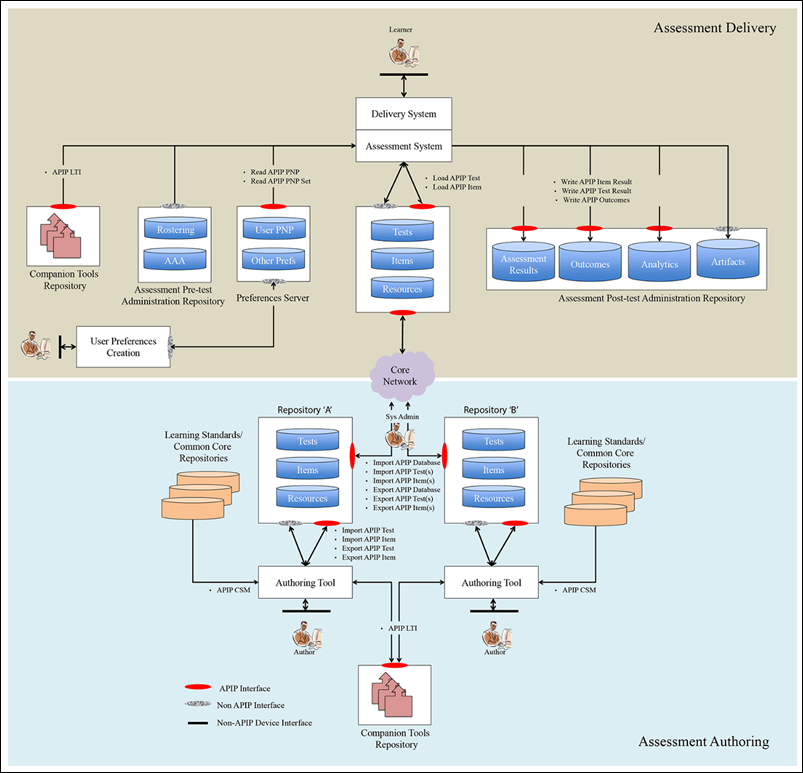
Figure 2.1 The APIP functional architecture.
It is important to stress that the APIP is about data interchange. It is not a requirement for a system, application and tool that uses APIP compliant artifacts to employ the APIP structures as the local storage format. For example, it would be unusual for a database to store APIP Test and Items using the XML formats described in this document. An APIP compliant system, application and tool use the APIP formats to exchange the tests and items with other APIP compliant systems. Furthermore, APIP does NOT address the format in which the Items and Tests are presented/rendered on a user device. The QTI XML is used as the syntax and semantics for content interoperability and is not intended to imply/require that the end user device can process such information natively. The APIP is used to support three types of data interchange:
• Repository to repository exchange - interactions between digital repositories that are configured to make APIP compliant data available;
• Repository to content/assessment tool exchange - interactions between digital repositories and the tools that make the APIP data available to users such as content authors, learners, etc.
• Preferences server to content/assessment tool exchange - interactions between content tools, such as an assessment system, and a preferences server that makes personal profile information available to other systems.
It should be noted that at present APIP does not address delivery of a rendered APIP Item or Test to a user device itself. Instead, it is expected that the Delivery System will take responsibility for delivery on a device using whatever technology is appropriate.
In Figure 2.1, external reference to Learning Standards is possible through the use of the 1EdTech Curriculum Standards metadata v1.0 specification [CC, 11]. The companion tools can be launched using the 1EdTech Learning Tools Interoperability v1.1 specification [LTI, 12]. The APIP Package can contain the corresponding launch information for the tool. The QTIv2.1 specification also provides the mechanism for the reporting of Item and Test Results and/or Outcomes. However, this functionality is not provided in APIP v1.0.
2.1.1. Repository-to-Repository Interactions
Repository-to-repository interactions are used in situations such as:
• The APIP database must be archived and stored in some external archive system;
• A central authority wishes to distribute either the entire APIP database or various subsets to other synchronized repositories.
Therefore, there are three sets of data that could be exchanged (import or export) between repositories: the full APIP Database, one or more APIP Tests (including their associated items and sections) and one or more APIP Items.
2.1.2. Repository to Content Tool Interactions
Repository to content tool interactions occur when some other system, tool or application is required to make use of the APIP Tests and APIP Items stored in a repository. The two key scenarios are:
• An authoring tool that is being used to create and/or edit APIP Test and APIP Items - in this case an authoring tool would normally have its own representations for a Test and Item. APIP Tests/Items may be imported for editing and aggregation to create new Tests/Items. Once an Item or Test has been finished, it could then be exported using the equivalent APIP formats and stored in an APIP database;
• An assessment/delivery system that is presenting an assessment to a learner - here the assessment system uses an on-demand approach to load the APIP Tests and Items as required. This allows a Test to make use of real-time adaptive sequencing of Items without the Assessment system having to store the entire Item bank (this could consist of many thousands of Items suited for use in any one test).
These two scenarios show that there is the traditional import/export of an APIP Test and APIP Item requirement plus a load APIP Test and Item need.
2.1.3. Personal Preferences Server to Content Tool Interactions
The key use case for an assessment system that uses the APIP Test and Item formats is to be able to tailor the assessment being undertaken by a learner to meet the accessibility preferences and needs of the learner. Therefore, the Assessment System must retrieve the learner's accessibility preferences and needs from a Preferences Server[1]. The attributes of this accessibility profile are then used to configure the assessment experience for the learner. The preferences are used to define:
• How the Test and its Items must be rendered for the learner by using the accessibility features designed into the APIP Tests and Items;
• How the learner will interact with the assessment system and hence the Tests and Items to answer the rendered questions.
Therefore, the Assessment system must be able to read the APIP Personal Needs & Preferences (PNP) data from the Preferences Server.
2.2. Item Data Model
2.2.1. Underlying Accessibility Content Model
The APIP standards build on the 1EdTech QTI specifications. The APIP extensively profiles the QTI item model into a comprehensive framework. As depicted in Figure 2.2, the APIP framework is comprised of two information models that provide information that allow test items to be ported across item banks and which allow test delivery engines to tailor the presentation of items to meet the access needs of each individual test taker.
The first information model focuses on Test taker PNP Information. During test delivery, the Test taker PNP Information model performs two functions. First, the Test taker PNP Information model provides information that allows a test delivery engine to activate specific tools that tailor the presentation of item content to the test taker. These embedded access features may include magnification, alternate contrast, increased white space, and answer masking. Second, the Test taker PNP Information provides information that specifies which accessibility information embedded within the item model is pertinent to the test taker. As described in greater detail below, a variety of types of access information can be placed within an item, including specifications for how an item is to be presented in auditory, Braille, sign, or tactile forms. In addition, the item information model allows an item developer to point to alternate versions of the item that are presented in an alternate language (e.g. Spanish) or in simplified English (e.g. with negatives removed). As depicted in Figure 2.2, the APIP Item model has five components:
• Item Information;
• Content Information;
• Companion Material;
• Accessibility Information;
• Inclusion Order.

Figure 2.2 The APIP content model.
KEY:
A) Content Information: reduced answer options, item anchors, etc.
B) Accessibility Information: read aloud audio, Braille, Sign Language, etc.
C) Inclusion Order Information: tab order, reading order and inclusion;
D) Alternate Content: different languages, simplified language, etc.
E) Interface: magnification, calming, answer masking, line spacing, etc.
An important concept that informed the development of the APIP Item Model is the distinction between default content and alternate content. Default content is Item information intended to be presented to a test taker with no defined access needs. Traditionally, this default content defines the original form of the item developed for the general population of test takers. Typically, the default content includes text, graphics, and/or tables that form the item that would be presented to a student who does not have any defined access needs. However, default content might also include other media elements such as sound files or movies intended to be presented as part of the item for the general population of test takers.
Alternate content presents a different version of the item to students with specific access needs. In essence, some or all of the original default content is replaced by alternate content. When this occurs, the alternate content that replaces default content is intended to be presented to a test taker with a specific access need in replace of the default content. As an example, a translated version of an item, replacing text or formulas with symbolic representations, or simplifying the language contained in an item are all examples of replacements that result in alternate content.
In contrast, for many access needs, improved access does not require content to be replaced, but instead requires the presentation of information that supplements default content. As an example, text displayed as part of default content might be presented in audio, Braille, or signed form. When doing so, the default content will remain displayed to the test taker and the additional content (audio, Braille or sign) will be presented as supplementary information. Similarly, changes intended to assist the test taker in identifying important aspects of default content present the default content along with supplementary information (e.g. highlighting key words, translation or definitions for key words, flags that point the student to key information, etc.).
When supplementary information is provided to meet a specific access need, this information must be placed in the Accessibility Information component for that item. In contrast, when alternate content is provided to meet a specific access need, this information must be placed in a separate item that provides an alternate representation of the item as a whole. In addition, a pointer to that alternate item must be included in the Item Information component for the default item and a pointer to the default item must be included in the Item Information component for the alternate item. Finally, to make the alternate content accessible for specific access needs, supplementary access information must be specified in the Accessibility Information component of the alternate item.
Item Information
The Item Information component provides meta-information about an item. Examples of meta-information include the domain, sub-domain, intended construct, intended grade/age level, item difficulty, item discrimination, item exposure rate, intended purpose, etc. In addition, the Item Information component contains information about alternate versions of the item for which item content has been substituted to make the item accessible in a different language or as a simplified version of the item in a native language e.g. simplified English. This meta-information may be used in many different ways, including populating fields in an item bank, selection of an appropriate item by a test engine, tracking the development of item by a content creation system, or pointing a test delivery engine to a translated version of an item.
Content Information
The second component, Content Information, provides information about the contents of the item that are to be presented to a test taker assuming no access needs have been defined for that test taker. This information includes the item type, the prompt, media associated with the item (e.g. figures, tables, graphs), response options, correct response, scoring rule, etc. The content information component specifies the information that forms the item and additional information used by a test engine to score an item. The APIP Content Information is based on the 1EdTech QTI specification.
Companion Material Information
The Companion Material Information provides information about materials and tools that the test taker is expected to use while performing the item. These materials and tools may include a reading passage, a primary document, a periodic table, ruler, protractor, calculator, etc. The Companion Material Information also identifies any lookup dictionaries associated with the item to provide definitions or translations of specific words within an item. The Companion Material Information is intended to be used by a test delivery interface to make the requisite material available when the item is presented or to identify the appropriate definition or translation of item content when the test taker requests such information.
Accessibility Information
The Accessibility Information performs two functions. First, it defines elements contained in the item content. Elements can include individual words, blocks of text, graphics, labels associated with a graphic, tables, table titles, table rows, table cells or any other content defined as part of the item in the Default Item Content component. Second, this component provides information about alternate representations of each item element. The types of alternate representations specified in the Accessibility Information component include audio, signed, or tactile presentation of item content. The Accessibility Information component may also include specifications for scaffold supports or key word translations. As described in detail below, information contained in the Accessibility Information component is intended to improve accessibility by alternate representations or additional information that is intended to supplement the contents presented by default to a test taker.
Inclusion Order
The fifth and final component, Inclusion Order, specifies the order in which accessibility elements are to be presented to a test taker with a given category of access needs. The five categories of access needs for which an inclusion order is specified include:
• Text-based Audio presentation;
• Text and Graphics Audio presentation;
• Non-visual presentation;
• American Sign Language presentation;
• Other signed presentation.
For each category of access needs, the inclusion order also specifies whether the accessible content element is to be presented in-the-flow or on-demand when accessibility elements are presented automatically to a student upon entering a test item.
For several access needs, careful decisions must be made about what accessibility elements are to be made available to a test taker, whether the element is to be presented by default to the test taker or only on demand, and in what order the elements are to be presented. The APIP Inclusion Order component requires an item writer to provide these three contexts. An Inclusion Order must be specific to a category of access need.
Text-based audio access is specific to test takers who are able to view contents displayed on a screen, but may need assistance accessing those contents. Often, test takers requiring text-based audio access read below grade level, have reading related disabilities, or the language in which item content is displayed is not their primary language. Text-based audio access provides an audio representation of alphanumeric content.
Text-based and graphic audio access is specific to test takers with difficulty viewing contents displayed on a screen and need assistance accessing both alphanumeric content and graphical elements. Often, test takers requiring text-based and graphic audio access have partial vision that makes it difficult to decode text or to perceive large graphics. Text-based and graphic audio access provides an audio representation of alphanumeric content and audio descriptions of information displayed in graphical and tabular form.
For both text-based and text-based/graphic audio access, a test taker may opt to have item elements presented in audio form as core content (it is essential and not distracting to the intended user) when an item is presented on the screen or on-demand (available to select when needed). When audio forms are presented as core content, the item developer must specify the order in which content is presented. In addition, the item writer must consider whether all item elements are presented as core content in audio form. As an example, an item writer may opt not to present labels associated with a graphical element as part of the core content, or may opt not to read the contents of a table when the item is read from beginning to end. In these cases, item content that is not presented as core content may be accessed by the test taker on-demand.
Non-visual access is specific to test takers who are legally blind and who require an audio presentation and/or text for Braille display of item content. Non-visual access requires audio and/or Braille Text representations of alphanumeric, graphical, and tabular content. Non-visual access also typically presents item elements automatically to the test taker, but is selective about which item elements are presented. When selecting item elements that are represented to a test taker requiring Non-visual access, the item writer must decide whether an item element can be presented in a manner that assists the test taker in accessing the item. As an example, an item writer may decide not to present isolated labels associated with a graphic or information contained within the cell of a table. Instead, the item writer may provide a description of the entire graphic or a description of the entire contents of a table row in which the cell appears.
American Sign Language access is specific to test takers to benefit from video presentation of the item content using American Sign Language. Other Sign Language access is specific to students who communicate in sign, but ASL is not their primary method of signed communication. For both access need categories, the order in which signed versions of item content are presented to the test taker must be specified. On-demand content may also be specified for these access need categories.
A sixth access need category may also be met, but does not require a separate Inclusion Order. This sixth access need provides audio descriptions of item content presented in graphic form. Graphic audio access is specific to test takers who are able to access alphanumeric content, but who have difficulty processing information presented in graphical or tabular form. Students requiring graphic audio access may have challenges processing information or with spatial relations. Graphic audio access is provided on-demand and is accomplished by referencing only the graphic elements specified in the Text-based and Graphic Audio Access Inclusion Order.
2.2.2. APIP Items and APIP Packages
The APIP Items are to be encoded in the 1EdTech QTI format: this uses the Extensible Mark-up Language (XML) and is commonly termed QTI-XML. In fact, the encoding also makes use of the 1EdTech Content Packaging format. A schematic representation of the APIP content assessment model is shown in Figure 2.3. An APIP Item consists of a set of related QTI 'assessmentItems' that reflect the alternative versions of the default instance. Each of these 'assessmentItems' is contained within its own QTI-XML instance file. In fact, the QTI-XML instances also contain the Companion Materials, Inclusion Order and Accessibility Information i.e. these are placed within the original 1EdTech QTI-XML structure but having a separate XML namespace. An APIP Item also consists of the set of asset files (an asset is a file that contains a digital resource to be used in rendering the APIP Item e.g. an image file, an audio recording, web pages, etc.) and the metadata that is used to describe the APIP Item and to help in searching for, and identifying, APIP Items that conform to specific properties. The package itself consist of[2]:
• The 'imsmanifest.xml' that contains the description of how the set of APIP Items are composed within the associated zip file (all content packages must contain a manifest file);
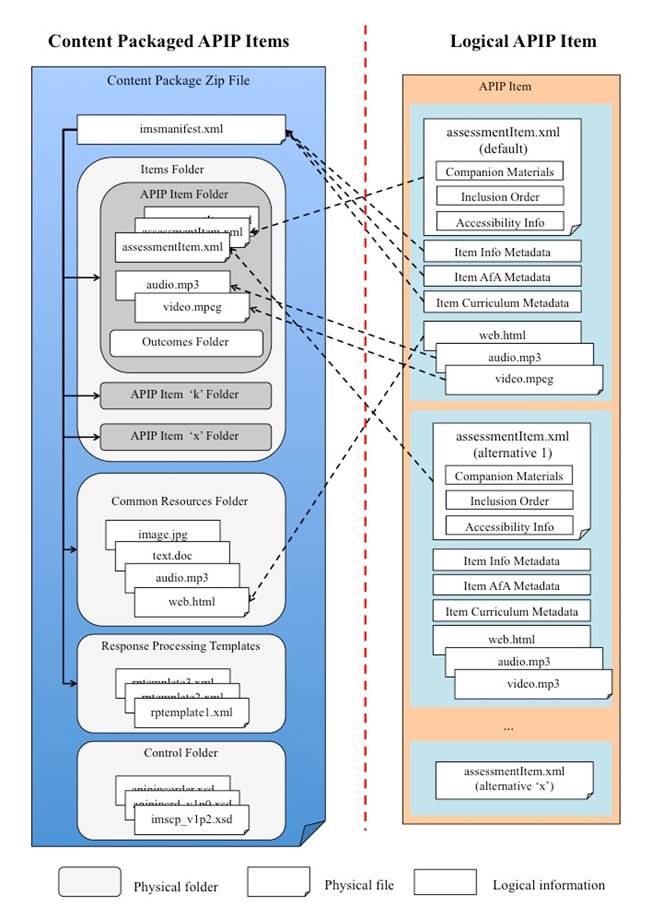
Figure 2.3 The APIP relationship between the logical and packaged Item data model.
• A directory that is used to contain the set of APIP Items. Each APIP Item has its own folder within the parent directory. All of the files specific to an APIP Item are contained in the folder. If separate outcome declarations instances are included then these should be contained in a child folder within the Item folder;
• A directory that is used to contain assets that are used by more than one APIP Item. This ensures that physical file duplication is avoided (the relationship between the APIP Item constructs and the physical files is described in the 'imsmanifest.xml' file);
• A directory that is used to contain any response processing templates that are used by any of Items;
• A directory that is used to contain any control files that can be used to validate the contents e.g. the XSDs for use with offline validation.
2.3. Assessment Data Model
2.3.1. Underlying Assessment Content Model
The APIP assessment content model adopts the 1EdTech QTI v2.1 specification. A schematic representation of the composition of a QTI-based Test is shown in Figure 2.4.
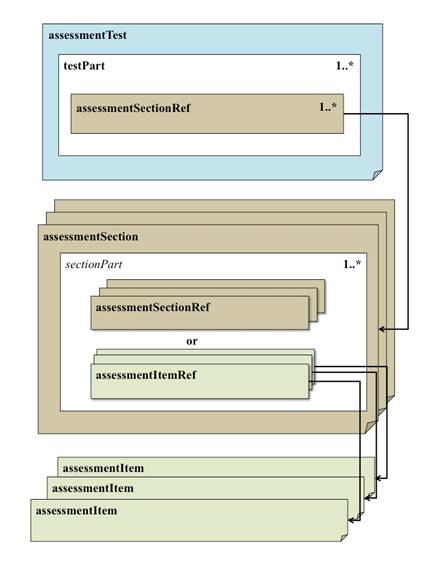
Figure 2.4 The APIP assessment content model.
The key features in Figure 2.4 are:
• AssessmentTest, assessmentSection and assessmentItem objects are contained in their own XML instance files;
• AssessmentSections are permitted to contain assessmentSections i.e. these are the recursive objects used to build complex assessmentTests;
• The links to assessmentSections in assessmentTests and assessmentSections is provided using the assessmentSectionRef feature;
• AssessmentItems are linked to the assessmentTest using the assessmentItemRef object within the corresponding assessmentSection(s);
For APIPv1.0, assessmentItem, assessmentSection, assessmentTest, outcomeDeclaration, responseProcessing and assessmentStimulus instances are the only first class objects that are supported.
2.3.2. APIP Tests
An APIP Test consists of one or more APIP Sections and one or more APIP Items. In fact, an APIP Test consists of all of the APIP Items that are, or may be used by the APIP Test. APIP Tests and Sections are also exchanged using the 1EdTech Content Packaging construct. Figure 2.5 shows the relationship between the logical data model for an APIP test and the construction of the APIP Package. The new Test and Section features in the APIP Package are:
• A directory that is used to contain the set of APIP Sections. Each APIP Section has its own folder within the parent directory. All of the files specific to an APIP Section are contained in the folder;
• A directory that is used to contain the set of APIP Tests. Each APIP Test has its own folder within the parent directory. All of the support files specific to an APIP Test are contained in the folder. If separate outcome declarations instances are included for a Test then these should be contained in a child folder within the Test folder.
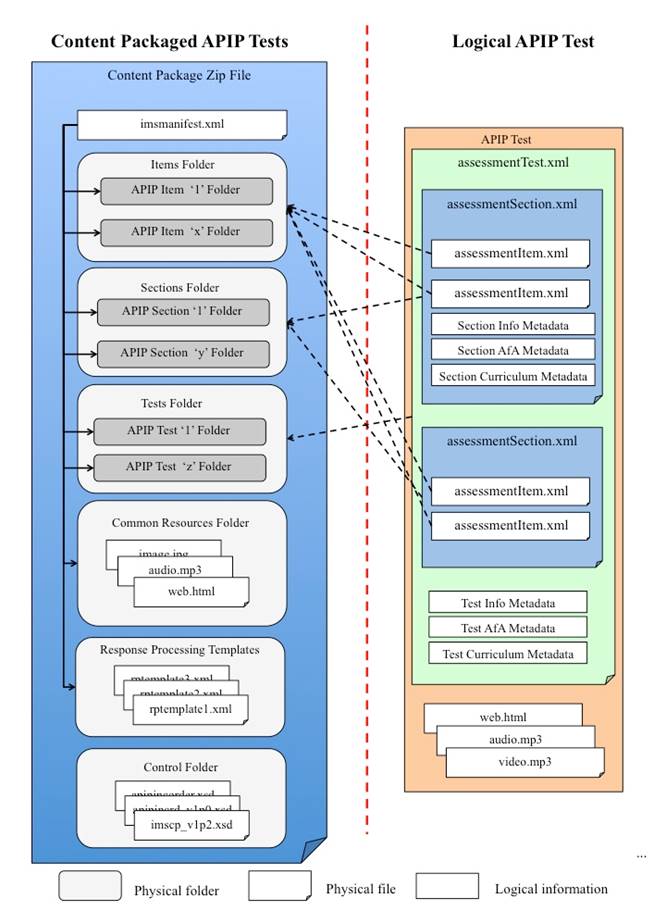
Figure 2.5 The APIP relationship between the logical and packaged Test data model.
3. Profile Instance Binding Model
3.1. The Profiles
The profiling of the various base specifications is detailed in Appendix A.
3.1.1. APIP Items
The APIP Item has four binding components:
• A profile of the original QTI v2.2 XSD - this removes all of the features that are not required/used for an 'assessmentItem' (see Appendix A2);
• A profile of the original QTI v2.2 XSD - this removes all of the features that are not required/used for a separate 'outcomeDeclaration' (see Appendix A5);
• A profile of the original QTI v2.2 XSD - this removes all of the features that are not required/used for a separate 'responseProcessing' template (see Appendix A6);
• The new extension features defined for QTI by APIP (see Appendix A8) - these features are inserted into the profiled Item version of the QTI XSD.
The combined XSDs are used to validate APIP Item, APIP Outcome Declaration and APIP Response Processing XML instances only; each APIP Item must be contained in its own XML instance file.
3.1.2. APIP Sections
The APIP Section has two binding components:
• A profile of the original QTI v2.2 XSD - this removes all of the features that are not required/used for an 'assessmentSection' (see Appendix A3). If separate Test-level outcome declarations are required then these use the same XSD as per Item-level outcome declaration validation;
• The new extension features defined for QTI by APIP (see Appendix A8) - these features are inserted into the profiled Section version of the QTI XSD.
The combined XSDs are used to validate APIP Section XML instances only; each APIP Section must be contained in its own XML instance file.
3.1.3. APIP Tests
The APIP Test has two binding components:
• A profile of the original QTI v2.2 XSD - this removes all of the features that are not required/used for an 'assessmentTest' (see Appendix A4);
• The new extension features defined for QTI by APIP (see Appendix A8) - these features are inserted into the profiled Test version of the QTI XSD.
The combined XSDs are used to validate APIP Test XML instances only; each APIP Test must be contained in its own XML instance file.
3.1.4. APIP Assessment Stimulus
The APIP Assessment Stimulus has two binding components:
• A profile of the original QTI v2.2 XSD - this removes all of the features that are not required/used for an 'assessmentStimulus' (see Appendix A7);
• The new extension features defined for QTI by APIP (see Appendix A8) - these features are inserted into the profiled Assessment Stimulus version of the QTI XSD.
The combined XSDs are used to validate APIP Assessment Stimulus XML instances only; each APIP Assessment Stimulus must be contained in its own XML instance file.
3.1.5. APIP Content Packages
An APIP Package consists of the XML instance files plus the associated asset files that are used to create the full question e.g. images, audio, video etc. Furthermore, APIP must support the exchange of more than one APIP object. The assets for each Item, Section, Test and Shared Stimulus are associated to the QTI instance files by using approach defined in the 1EdTech Content Packaging specification.
The APIP Package contains the manifest file (named 'imsmanifest.xml') that describes the various relationships between all of the files (an APIP Package is a profiled form of an 1EdTech Content Package as defined in the corresponding 1EdTech CP v1.2 specification). More importantly, the manifest contains all of the metadata that is used to describe the composition of the set of APIP Items. The components of the profile used to describe the use of a content package are:
• A profile of the original CP v1.2 XSDs (it has two linked XSDs) - this extends the original QTI v2.2 recommendations for CP to cover the broader set of APIP needs (see Appendix A9);
• Two profiles of the IEEE LOM to provide the metadata that describes the content package as a whole and for each of the resources described in the manifest (see Appendix A10);
• A further profile of the QTI v2.2 metadata describes the relationships between the original QTI Item description and the alternative renderings forms (see Appendix A10);
• The variant content forms can be described using the approach defined in the 1EdTech Access for All (AfA) Digital Resource Description (DRD) v2.0 specification (the profile for the use of AfA DRD is given in Appendix A10);
• The APIP Items, Sections, Tests and Outcome Declarations can have Curriculum Standards Metadata (CSM) annotations using the approach defined in the 1EdTech Common Cartridge (CC) v1.2 specification (see Appendix A10);
• External tools that are to be used in conjunction with an assessment, including but not limited to Companion Tools, can be described within an APIP Package and launched by the Assessment System using the approach defined in the 1EdTech Learning Tools Interoperability (LTI) v1.1 specification (see Appendix A11);
Later versions of APIP will clarify the extent to which the various metadata entries are mandatory or otherwise.
3.1.6. APIP PNP Descriptions
The user preferences parts of the APIP also has three binding components:
• A profile of the original AfA PNP v2.0 XSD - this removes all of the features that are not required/used for rendering an 'assessmentItem' appropriately (see Appendix A12);
• The new extension features defined for AfA PNP by APIP (see Appendix A13) - these features are inserted into the profiled version of the AfA PNP XSD at permitted extension points (the extension point are replaced i.e. no further extensions are permitted at this point for APIP);
• The exchange of a collection of APIP AfA PNP instances - this is the collection of many individual APIP AfA PNP records into a single instance with the learner associated with each record identified (See Appendix A14).
The combined XSDs are used to validate APIP AfA PNP XML instances only. The manner in which these instances are supplied is outside the scope of APIP v1.0.
3.2. APIP Class Model
3.2.1. APIP Packaging
The set of APIP Package classes from the associated set of 1EdTech specifications and adopted specifications are shown in Figures 3.1, 3.2, 3.3, 3.4 and 3.5. The corresponding description for the set of classes is given in Table 3.1.

Figure 3.1 APIP Package classes.
|
|
|
|
|
Figure 3.2 1EdTech Assessment Test class composition. |
Figure 3.3 1EdTech Assessment Section class composition. |
|
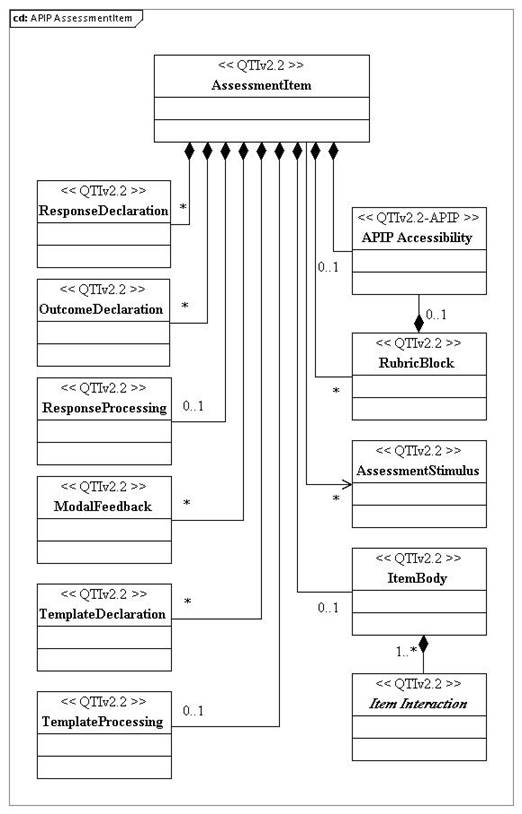
Figure 3.4 1EdTech Assessment Item class composition.

Figure 3.5 1EdTech Assessment Stimulus class composition.
Table 3.1 APIP Packaging class descriptions.
|
Entity |
Description |
|---|---|
|
APIP Test Bank Package |
An APIP Package, which is a type of 1EdTech Content Package, that contains all of the digital files and assets required for the exchange of a Test Bank (including the Sections and Items). |
|
APIP Test Package |
An APIP Package, which is a type of 1EdTech Content Package, that contains all of the digital files and assets required for the exchange of only one assessment (including the Sections and Items). |
|
APIP Section Package |
An APIP Package, which is a type of 1EdTech Content Package, that contains all of the digital files and assets required for the exchange of only one section (including the Items). |
|
APIP Item Bank Package |
An APIP Package, which is a type of 1EdTech Content Package, that contains all of the digital files and assets required for the exchange of an Item Bank. |
|
APIP Item Package |
An APIP Package, which is a type of 1EdTech Content Package, that contains all of the digital files and assets required for the exchange of only one item. |
|
Content Package |
An 1EdTech Content Package as defined by the 1EdTech Content Package v1.2 specification. |
|
Manifest |
An APIP profile of the Manifest class from the 1EdTech Content Package v1.2 specification. |
|
Manifest Metadata |
An APIP profile of the 'ManifestMetadata' class from the 1EdTech Content Package v1.2 specification. |
|
LOM Manifest |
An APIP profile of the LOM class from the IEEE LOMv1.0 specification for the metadata associated with the package as a whole. |
|
LOM |
The LOM class from the IEEE LOMv1.0 specification (this is based upon the strict binding of LOM). |
|
CSM |
The 'CurriculumStandardsMetadataSet' class from the Curriculum Standards Metadata v1.0 specification that was defined as part of the 1EdTech Common Cartridge v1.2 specification |
|
Resources |
An APIP profile of the Resources class from the 1EdTech Content Package v1.2 specification. |
|
Resource |
An APIP profile of the Resource class from the 1EdTech Content Package v1.2 specification. |
|
Resource Metadata |
An APIP profile of the 'ResourceMetadata' class from the 1EdTech Content Package v1.2 specification. |
|
LOM Resource |
An APIP profile of the LOM class from the IEEE LOMv1.0 specification for the metadata associated with a resource in a manifest. |
|
QTImetadata |
An APIP profile of the 'QTImetadata' class from the 1EdTech QTI v2.2 specification. |
|
Variant |
An APIP profile of the Variant class from the 1EdTech Content Package v1.2 specification. |
|
Variant Metadata |
An APIP profile of the Variant Metadata class from the 1EdTech Content Package v1.2 specification. |
|
AccessForAllResource |
The 'AccessForAllResource' class from the Access for All Digital Resource Description v2.0 specification. |
|
Test Resource |
An abstract class that represents the definition of a resource for an Assessment Test structure. This includes all of the dependencies on other resources. |
|
Section Resource |
An abstract class that represents the definition of a resource for an Assessment Section structure. This includes all of the dependencies on other resources. |
|
Item Resource |
An abstract class that represents the definition of a resource for an Assessment Item structure. This includes all of the dependencies on other resources. |
|
LTI Resource |
An abstract class that represents the definition of a resource launched using the LTIv1.1 approach. This includes all of the dependencies on other resources. |
|
Outcome Resource |
An abstract class that represents the definition of a resource for an Outcome Declaration structure. |
|
Processing Resource |
An abstract class that represents the definition of a resource for a Response Processing template structure. |
|
Metadata Resource |
An abstract class that represents the definition of a resource for a Assessment Stimulus structure. |
|
Asset Resource |
An abstract class that represents the definition of a resource for any asset used within the package i.e. a resource for an image, mp3, mpeg, etc. |
|
AssessmentTest |
An APIP profile of the 'AssessmentTest' class from the 1EdTech QTI v2.2 specification (this structure is implemented as its own XML instance file). |
|
OutcomeDeclaration |
An APIP profile of the 'OutcomeDeclaration' class from the 1EdTech QTI v2.2 specification. |
|
OutcomeProcessing |
An APIP profile of the 'OutcomeProcessing' class from the 1EdTech QTI v2.2 specification. |
|
TestFeedback |
An APIP profile of the 'TestFeedback' class from the 1EdTech QTI v2.2 specification. |
|
Test Part |
An APIP profile of the 'TestPart' class from the 1EdTech QTI v2.2 specification. This is contained within the associated 'assessmentTest.xml' file. |
|
AssessmentSection |
An APIP profile of the 'AssessmentSection' class from the 1EdTech QTI v2.2 specification (this structure is implemented as its own XML instance file). |
|
RubricBlock |
An APIP profile of the 'RubricBlock' class from the 1EdTech QTI v2.2 specification. |
|
AssessmentItem |
An APIP profile of the 'AssessmentItem' class from the 1EdTech QTI v2.2 specification (this structure is implemented as its own XML instance file). |
|
ResponseDeclaration |
An APIP profile of the 'ResponseDeclaration' class from the 1EdTech QTI v2.2 specification. |
|
OutcomeDeclaration |
An APIP profile of the 'OutcomeDeclaration' class from the 1EdTech QTI v2.2 specification. A different profile is used when this is made available as a separate resource. |
|
ResponseProcessing |
An APIP profile of the 'ResponseProcessing' class from the 1EdTech QTI v2.2 specification. A different profile is used when this is made available as a separate resource. |
|
ModalFeedback |
An APIP profile of the 'ModalFeedback' class from the 1EdTech QTI v2.12 specification. |
|
TemplateDeclaration |
An APIP profile of the 'TemplateDeclaration' class from the 1EdTech QTI v2.2 specification. |
|
TemplateProcessing |
An APIP profile of the 'TemplateProcessing' class from the 1EdTech QTI v2.2 specification. |
|
RubricBlock |
An APIP profile of the 'RubricBlock' class from the 1EdTech QTI v2.2 specification. |
|
ItemBody |
An APIP profile of the 'ItemBody' class from the 1EdTech QTI v2.2 specification. |
|
Item Interaction |
An abstract entity that is used to represent any of the entities that are used to define an interaction within the 1EdTech QTI v2.2 specification e.g. 'choiceInteraction', 'hotspotInteraction', etc. |
|
AssessmentStimulus |
An APIP profile of the 'AssessmentStimulus' class from the 1EdTech QTI v2.2 specification (this structure is implemented as its own XML instance file). |
|
StimulusBody |
An APIP profile of the 'StimulusBody' class from the 1EdTech QTI v2.2 specification. |
|
APIP Accessibility |
The APIPv1.0 class that is used to contain all of the alternative accessibility-based content for the associated APIP Assessment Test, Section and/or Item. |
|
CartridgeBasicLTILink |
The LTIv1.1 class that is used to define how the associated tool can be launched by an LTI-compliant system. |
Note that only the key classes are shown. Each of the relevant specification consists of many other associated classes.
3.2.2. APIP PNP Classes
The set of APIP PNP classes are shown in Figures 3.6. The associated class descriptions are given in Table 3.2.
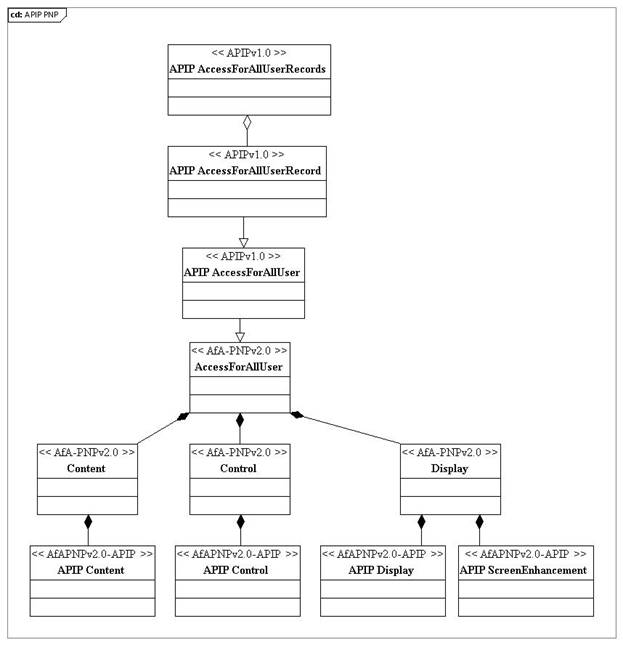
Figure 3.6 APIP PNP entities.
Table 3.2 APIP PNP entity descriptions.
|
Entity |
Description |
|
APIP AccessForAllUserRecords |
The collection of a set of APIP AfA PNP User Records. |
|
APIP AccessForAllUserRecord |
An APIP AfA PNP User Record i.e. the original APIP AfA PNP instance plus learner and assignment identifiers. |
|
APIP AccessForAllUser |
The APIP profile of the AfA PNPv2.0 with the addition of the APIP specific extensions. |
|
AccessForAllUser |
The APIP profile of the AccessForAll class in the AfA PNPv2.0 specification. |
|
Content |
The APIP profile of the Content class in the AfA PNPv2.0 specification (this includes support for the APIP extensions). |
|
APIP Content |
The APIP extensions to the AfA PNPv2.0 Content class. These are name-spaced into the original AfA PNPv2.0 definition. |
|
Control |
The APIP profile of the Control class in the AfA PNPv2.0 specification (this includes support for the APIP extensions). |
|
APIP Control |
The APIP extensions to the AfA PNPv2.0 class. These are name-spaced into the original AfA PNPv2.0 definition. |
|
Display |
The APIP profile of the Display class in the AfA PNPv2.0 specification (this includes support for the APIP extensions). |
|
APIP Display |
The APIP extensions to the AfA PNPv2.0 Display class. These are name-spaced into the original AfA PNPv2.0 definition. |
|
APIP ScreenEnhancement |
The APIP extensions to the AfA PNPv2.0 ScreenEnhancement class. These are name-spaced into the original AfA PNPv2.0 definition. |
3.3. XSD Binding Model
A schematic representation of the XSD binding structure for APIP is shown in Figure 3.7. The physical interoperability is realized as a set of data models expressed as XSDs. The set of XSDs used in the APIP are:
• 'apipv1p0_afapnp_v2p0_v1p0.xsd' - the XSD binding of the 1EdTech AfA PNP v2.0 specification to support the exchange of the user preferences user and the 'Assessment System'. This original XSD has been profiled for the APIP;
• 'apipv1p0_afapnpextv1p0_v1p0.xsd' - this is a new XSD that has been created to extend the capabilities of the AfA PNP XSD ('apipv1p0_afapnpv2p0_v1p0.xsd') as required by the APIPv1p0;
• apipv1p0_afapnpv2p0records_v1p0 - the XSD binding for the exchange of a collection of APIP AfA PNP instances. This is a new XSD created as part of the APIP specification;
• 'apipv1p0_imscpv1p2_v1p0.xsd' - the XSD binding of the core functions in the 1EdTech CP v1.2 specification used to represent the APIP Items. The original XSD has been profiled for the APIP and using the recommendations of the 1EdTech QTI v2.1 specification;
• 'apipv1p0_cpextv1p2_v1p0.xsd' - the XSD binding of the extension functions in the 1EdTech CP v1.2 specification used to represent the resource variants (this is used to extend the core CP profile in the file 'apipv1p0_imscpv1p2_v1p0.xsd');
• 'apipv1p0_qtiitemv2p2_v1p0.xsd' - the XSD binding of the 1EdTech QTI v2.2 specification used to represent the APIP Items;
• 'apipv1p0_qtisectionv2p2_v1p0.xsd' - the XSD binding of the 1EdTech QTI v2.2 specification used to represent the APIP Sections;
• 'apipv1p0_qtitestv2p2_v1p0.xsd' - the XSD binding of the 1EdTech QTI v2.2 specification used to represent the APIP Tests;
• 'apipv1p0_qtioutcomesv2p2_v1p0.xsd' - the XSD binding of the 1EdTech QTI v2.2 specification used to represent the APIP Outcome Declarations;
• 'apipv1p0_qtiresprocessingv2p2_v1p0.xsd' - the XSD binding of the 1EdTech QTI v2.2 specification used to represent the APIP Response Processing Templates;
• 'apipv1p0_qtistimulusv2p2_v1p0.xsd' - the XSD binding of the 1EdTech QTI v2.2 specification used to represent the APIP Response Processing Templates;
• 'apipv1p0_qtiextv2p2 _v1p0.xsd' - this is the accessibility XSD that has been created to extend the capabilities of the QTIv2.2 XSD ('apipv1p0_qtiitemv2p2_v1p0.xsd') as required by the APIPv1p0;
• 'apipv1p0_lommanifestv1p0_v1p0.xsd' - a profiled version of the XSD binding for the 1EdTech Metadata v1.3.2 specification binding (this is fully compliant with the IEEE LOM v1.0 standard). This binding is used to define the CP manifest metadata;
• 'apipv1p0_lomresourcev1p0_v1p0.xsd' - a profiled version of the XSD binding for the 1EdTech Metadata v1.3.2 specification binding (this is fully compliant with the IEEE LOM v1.0 standard). This binding is used to define the CP resource metadata;
• 'apipv1p0_imscsmdv1p0_v1p0.xsd' - the XSD binding for the Curriculum Standards Metadata from the 1EdTech Common Cartridge v1.2 specification binding;
• 'apipv1p0_qtimetadatav2p1_v1p0.xsd' - the XSD binding for the 1EdTech QTI v2.2 specification binding for QTI metadata (this is used to extend the resource metadata binding in the file 'apipv1p0_lomresourcev1p0_v1p0.xsd').
A summary of the roles, namespace definition and filename for these XSDs is given in Appendix C.
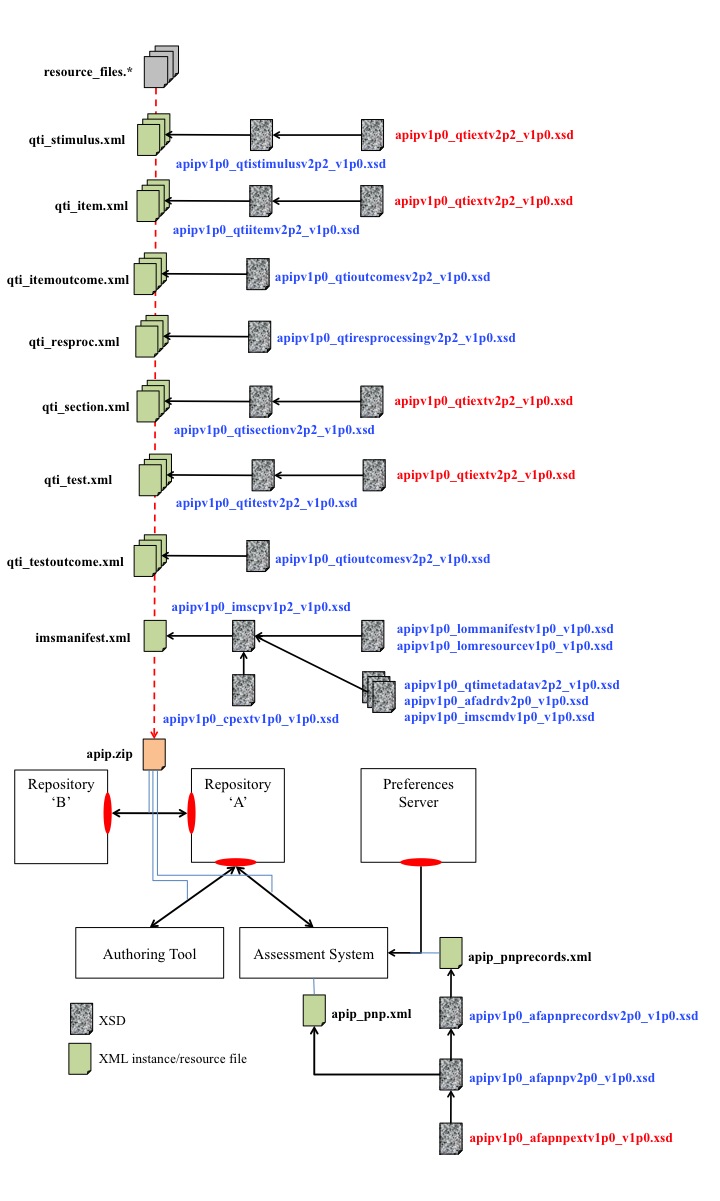
Figure 3.7 The APIP XSD binding relationships.
4. Profile System Behavior Model
4.1. APIP Items & Packages
4.1.1. APIP QTI Item Features
An APIP Item is based upon a heavily profiled version of the QTIv2.2 specification. The aim has been to reduce the implementation effort required when adopting APIP and to be as minimally invasive as possible on the original QTI v2.2 specification. The QTIv2.2 specification defines the behavioral expectations for the various QTI features. All of the QTI interactions are permitted within an APIP package. However, for an authoring or delivery system only the following are required to be supported (all are required for APIP Core and the first three for APIP Entry):
• Choice Interaction - the choice interaction presents a set of choices to the candidate. The candidate's task is to select one or more of the choices, up to a maximum of maxChoices. There is no corresponding minimum number of choices. The interaction is always initialized with no choices selected. APIP does not support the shuffling of selections. APIP does support multiple response selection (this is used for True/False, Multiple Choice/Single Response and Multiple Choice/Multiple Response questions);
• Text Entry Interaction - a text entry interaction is an inline interaction that obtains a simple piece of text from the candidate. The delivery engine must allow the candidate to review their choice within the context of the surrounding text. This interaction is typically used for fill-in blank questions;
• Extended Text Interaction - an extended text interaction is a block interaction that allows the candidate to enter an extended amount of text e.g. for an essay style answer;
• Hotspot Interaction - a hotspot interaction is a graphical interaction with a corresponding set of choices that are defined as areas of the graphic image. The candidate's task is to select one or more of the areas (hotspots). The hotspot interaction should only be used when the spatial relationship of the choices with respect to each other (as represented by the graphic image) is important to the needs of the item. Otherwise, choiceInteraction should be used instead with separate material for each option;
• Match Interaction - a match interaction is a block interaction that presents candidates with two sets of choices and allows them to create associates between pairs of choices in the two sets, but not between pairs of choices in the same set. Further restrictions can still be placed on the allowable associations using the matchMax and matchGroup attributes of the choices.
Other QTI assessmentItem features supported by APIPv1.0 are:
• 'id' attribute - this is an optional attribute on all of the HTML features in QTI v2.2. The APIP alternative content is linked to its source QTI XML using this attribute. All APIP compliant systems/tools/applications must support all the possible uses of the 'id' attribute;
• Composite Items - these are items that contain more than one point of interaction. Composite items may contain multiple instances of the same type of interaction or have a mixture of interaction types. When it is not 'composite', an item is considered 'simple';
• Shared Material Objects - it is often desirable to ask a number of questions all related to some common stimulus material such as a graphic or a passage of text. These should be structured using the assessmentStimulus and assessmentStimulusRef structures;
• Use of CSS 2.1 tags for layout and formatting - QTI 2.2 allows for the inclusion of a CSS file reference within the item. APIP will enforce the specific use of CSS as the layout specification, and will seek to limit the use of CSS tags to the following list. The full CSS 2.1 specification can be found at http://www.w3.org/TR/CSS2/.[3] Note that support for CSS3 is as part of the assessment accessibility annotation capability;
The QTI assessmentItem features that need NOT be supported by an APIPv1.0 compliant system are:
• Templates - Item templates are templates that can be used for producing large numbers of similar items. Such items are often called cloned items. Item templates can be used to produce items by special purpose cloning engines or, where delivery engines support them, be used directly to produce a dynamically chosen clone at the start of an item session;
• Adaptive Items - adaptive items are a new feature of version 2 that allows an item to be scored adaptively over a sequence of attempts. This allows the candidate to alter their answer following feedback or to be posed additional questions based on their current answer;
• Feedback - feedback consists of material presented to the candidate conditionally based on the result of responseProcessing. In other words, feedback is controlled by the values of outcome variables. There are two types of feedback material, modal and integrated. Modal feedback is shown to the candidate after response processing has taken place and before any subsequent attempt or review of the item. Integrated feedback is embedded into the itemBody and is only shown during subsequent attempts or review.
4.1.2. Response Processing Templates
At present there are no APIP-specific response processing templates. New response processing templates will be created and disseminated once consensus is reached. When such templates are used these should be included in the APIP Package as a separate resource. The key open issue for each template is the set of response processing variables that should be defined for each type of interaction.
4.1.3. Outcomes Declarations
APIP requires that the outcomes defined for an Item can be associated with the learning standards to which they apply. This is achieved using the CSM annotation for a resource in an APIP Package (in the manifest). For each outcome defined in an assessmentItem, a separate Outcomes Declaration XML instance file is created. These outcomes declaration instance files are now defined as manifest resources and the appropriate CSM annotations are included. Finally, the dependency between the Outcome Declaration resource and the parent assessmentItem resource is identified using the resource dependency feature in the manifest.
4.1.4. Shared Assessment Stimulus
One of the new features added as part of the Final Release is support for the explicit exchange of shared stimulus content. This is used when more than one assessmentItem wishes to refer to/use common content e.g. a passage of text about which several questions are asked. The passage would be defined as assessment stimulus material and stored in its own XML instance. Each assessmentItem using this content would refer to it using the appropriate assessmentStimulusRef object (assessmentItem can refer to an unlimited set of shared stimulus content). The manner in which the common content is rendered with each Item is controlled using the appropriate CSS layout and/or content authoring/delivery guidelines.
4.1.5. APIP Item Packages
Within an APIP package, the set of XML instances and asset files should be collected in directories based upon the corresponding APIP Item. A separate directory may be used to store assets that are used by more than one APIP Item. The directory composition in a content package is used to ease the packaging of the information. It is not required for end systems to sustain this set of relationships however it must be possible for the end system to obtain all of the files identified by an XML instance. All associated assessmentStimulus material should be contained in its own directory.
The appropriate 'imsmanifest.xml' file must be included in the APIP Item Package. The APIP zip file must comply with the 1EdTech Content Packaging requirements and the corresponding profile instructions contained within this document.
4.2. APIP Sections & Packages
4.2.1. APIP QTI Section Features
Sections are used to collect together a set of items. Nesting of assessmentSections is permitted in APIP but this is achieved by reference. One common use of a Section is to collect together a set of Items that have shared stimulus material e.g. a reading passage that is used by a set of questions. APIP has profiled the QTI specification by defining a permitted set of values for the use attribute of the Section-level rubricBlock.
The selection and ordering elements are not permitted for APIP Entry level compliance. Support for these elements in the APIP Core level compliance is optional.
4.2.2. APIP Section Packages
Within an APIP Section Package, the set of XML instances and asset files should be collected in directories based upon the corresponding APIP Section. In general, all of the referenced assessmentItem XML instance files will be include in the APIP Section Package. It is recommended that the set of files for each APIP Section and Item should be collected in its own directory. Each assessmentSection must be contained within its own XML instance file i.e. nesting of XML assessmentSections is not permitted in the actual XML.
The appropriate 'imsmanifest.xml' file must be included in the APIP Section Package. The APIP zip file must comply with the 1EdTech Content Packaging requirements and the corresponding profile instructions contained within this document.
4.3. APIP Tests & Packages
4.3.1. APIP QTI Test Features
The APIP Test is used to define the accessible assessment to be provided. Each assessmentTest must contain one or more testParts and each testPart must contain one or more assessmentSections. Each testPart definition is contained within the assessmentTest XML instance. An APIP compliant system must be able to process at least one testPart but is not required to process more than one. Each assessmentSection in a testPart is defined by reference i.e. it is contained in a separate XML instance file.
The preCondition and branchRule elements are not permitted for APIP compliance.
4.3.2. APIP Test Packages
Within an APIP Test Package, the set of XML instances and asset files should be collected in directories based upon the corresponding APIP Test. In general, all of the referenced assessmentSection XML instance files will be include in the APIP Test Package (along with the assessmentItem files). It is recommended that the set of files for each APIP Test, Section and Item should be collected in its own directory. The associated assessmentSection must be contained within its own XML instance file i.e. nesting of XML assessmentSection is not permitted in the assessmentTest XML.
The appropriate 'imsmanifest.xml' file must be included in the APIP Test Package. The APIP zip file must comply with the 1EdTech Content Packaging requirements and the corresponding profile instructions contained within this document.
4.3.3. Outcomes Declarations
APIP requires that the outcomes defined for a Test can be associated with the learning standards to which they apply. This is achieved using the CSM annotation for a resource in an APIP Package (in the manifest). For each outcome defined in an assessmentTest, a separate Outcomes Declaration XML instance file is created. These outcomes declaration instance files are now defined as manifest resources and the appropriate CSM annotations are included. Finally, the dependency between the Outcome Declaration resource and the parent assessmentTest resource is identified using the resource dependency feature in the manifest.
4.4. Metadata
4.4.1. Manifest Metadata
In this version of the APIP metadata fields are not mandated for a manifest (see Table A10.1). The recommended manifest metadata is:
• GUID assigned to the content page;
• Title for the package;
• Human readable description of the package;
• Version of the package;
• Status of the package;
• Date of authoring/contribution of the package;
• Author for the package;
• The type of learning resource (set to APIP Package);
• The copyright and other restrictions to be applied to the package.
The above metadata is encoded using LOM (all other LOM parts are available for use as required). The combination of the GUID and version number in the manifest metadata should be able to uniquely identify the APIP package as a whole i.e. more than one package can have the same GUID but these will be interpreted as different versions (hence the version number must be different) of the same package.
An importing system is expected to make this metadata available for observation to appropriately authorized user roles. An exporting system must ensure that this information can be accurately supplied. APIP supports all of the LOM fields in the manifest metadata but there is no guarantee that an importing system will be able to store or handle any of the optional information.
4.4.2. Resource Metadata
In this version of the APIP there is no mandated metadata for a resource (see Table A10.2). The recommended resource metadata is:
• GUID assigned to the APIP Item/resource;
• Title for the APIP Item/resource;
• Human readable description of the APIP Item/resource;
• Version of the APIP Item/resource;
• Status of the APIP Item/resource;
• Date of authoring/contribution of the APIP Item/resource;
• Author for the APIP Item/resource;
• The type of learning resource (set to APIP Item).
The above metadata is encoded using LOM (all other LOM parts are available for use as required). The combination of the GUID and version number should be able to uniquely identify the resource/APIP Item as a whole i.e. more than one APIP Item can have the same GUID but these will be interpreted as different versions (hence the version number must be different) of the same Item.
An importing system is expected to make this metadata available for observation to appropriately authorized user roles. An exporting system must ensure that this information can be accurately supplied. APIP supports all of the LOM fields in the resource metadata but there is no guarantee that an importing system will be able to store or handle any of the optional information
4.4.3. QTI Metadata
In this version of the Profile there is no mandated QTI metadata (see Table A10.3). The recommended metadata is:
• Describes if the Item is a composite or not i.e. uses more than one interaction form;
• Identification of the type of interaction used.
Other QTI metadata is available to describe the scoring mode for the response processing and the tool that was responsible for the creation of the APIP Item i.e. tool name, tool version and tool vendor. The metadata is encoded using a profile of the QTI metadata and this is supplied within the LOM descriptions for the associated resource.
An importing system is expected to make this metadata available for observation to appropriately authorized user roles. An exporting system must ensure that this information can be accurately supplied.
4.4.4. Curriculum Standards Metadata
Curriculum standards metadata is supported at the package and resource levels. The design of this support allows for at least the following:
• Any curriculum standard, learning standards or learning map definition can be used, as long as it supports unique identifiers. The provider of a specific standard is designated by the string-valued 'provider' element. Note that the provider can be accompanied by region and version string-valued attributes. These are intended to be for descriptive value only;
• Any cartridge and resource (hence Item, Section, Test and Outcome Declaration) can be associated with zero or more curriculum standards from one or more providers;
• The provider value and GUID should be sufficient to unambiguously identify a standard;
• An optional GUID label is supported to make standards more readily apparent when examining the cartridge.
Further information on the use of CSM is available in [CC, 11].
4.4.5. File Metadata
There is no predefined format for metadata that is associated with the file. Instead this remains as an XML name-space extension point. It is recommended that any metadata should take the form of an appropriate profile of the IEEE LOM cf. the approach undertaken for the manifest and resource metadata definitions earlier in this document.
4.4.6. Access For All Digital Resource Description (AfA DRD) Metadata
AfA DRDv2.0 metadata can be used to described variant QTI Item structures e.g. when an alternative QTI Item based on simplified language is also available. In this version of APIP there is no particular recommendation for how to use AfA DRD to support variant resources.
4.5. LTI-Based Resources
A Basic LTI link is a simplified and self-contained LTI link. The approach for defining an LTI link in APIP, using a resource type, is identical to that recommended for Common Cartridge (see Section 4.8 in [CC, 11]). The LTI specification [LTI, 12] is used to allow remote tools and content to be integrated into the launching system e.g. an LMS, Assessment Delivery System, etc. In the case of APIP, LTI can be used to:
• Launch digital companion materials e.g. a rule, protractor, etc.
• Launch a custom interaction - this is the recommended way to start a custom interaction thereby realizing a some form of interoperability;
• Access content that is available as a form of 'app' or which requires a proprietary player.
The advantage of using this approach lies in the fact that any tool supporting LTI can be launched by any system supporting LTI. Furthermore, LTIv1.1 allows the tool to report a score back to the system that launched the tool.
4.6. APIP Accessibility Features
The APIP accessibility features are available for the following QTI features:
• Assessment Item (Item Body) - the principle manner for the description of the alternative accessible forms of the content for the question;
• Assessment Item (Rubric Block) - Item-level content that is presented as rubric information (the APIP specification is silent on best practices for how a system should present this information);
• Assessment Item (Modal Feedback) - Item-level feedback (the APIP specification is silent on best practices for how a system should present this information);
• Assessment Section (Rubric Block) - Section-level content that is presented as rubric information including use as a common stimulus for several Items (the APIP specification is silent on best practices for how a system should present this information);
• Assessment Test (Test Feedback) - Test-level feedback (the APIP specification is silent on best practices for how a system should present this information).
Support for the use of Speech Synthesis Mark-up Language (SSML) and the Pronunciation Lexicon Standard (PLS) is also available for text-based annotations. The use of CSS3 is also available but withn APIP this is still experimental.
The APIP Best Practices document should be used for guidance on how to use the various APIP accessibility features [APIP, 14f].
4.7. Personal Needs & Preferences
The permitted content of the APIP PNP instances is defined in Tables A12.1, A13.1 and A14.1. It is expected that this will not be the only PNP information that is available for a user. However, only the data in Tables A12.1, A13.1 and A14.1 is required by APIP compliant systems.
If no PNP information is supplied, an APIP system that processes APIP Items cannot tailor the rendering of the Item to meet a user's needs and preferences. Therefore, an alternative approach would require the system to request the required information directly from the user before the assessment can be presented.
At present, values for the APIP PNP features are not mandated i.e. in general each APIP PNP instance file will have varying amounts of information. The use of non-user-specific externally sourced default values is NOT recommended. If a preference value is NOT supplied then the default value defined in the appropriate APIP specification MUST be used.
A key addition in the Final Release is support for the exchange of more than one APIP AfA PNP record in the same XML instance. This includes the information that links each of the AfA PNP records to the corresponding learner.
4.8. Repository-to-Repository Interactions
Repository-to-repository interaction is based upon the exchange of one or more APIP zip files. In general such APIP zip files will contain a collection of APIP objects e.g. a Test Bank and an Item Bank. In the case of repository-to-repository exchange the APIP metadata is essential so that the various versions of an APIP object can be distinguished from each other.
Import/export round tripping for an APIP zip file is not required to create a byte identical file. However, if a file undergoes such a round-trip a system it must NOT lose semantic information i.e. a repository is expected to be able to store ALL of the features that can be defined in an APIP zip file.
The APIP specification does not address how the APIP zip file is moved between repositories. For large APIP repositories, it may be impracticable to store all of the information in a single APIP zip file. In such circumstances the manner in which several related APIP zip files are constructed is outside the scope of the APIP specification. Accurate and consistent metadata labeling, file and directory naming conventions of XML instances and assets (such as jpeg, mpeg files, etc.) should avoid duplication whilst ensuring that each APIP zip file is self-sufficient i.e. the specification requires each APIP zip file to contain all of the files/assets it uses.
4.9. Repository to Application/System/Tool Interactions
4.9.1. Import/Export Interactions
An APIP compliant application/system/tool may:
• Import, only, an APIP zip file;
• Export, only, an APIP zip file;
• Import and export an APIP zip file - round tripping of an APIP zip file is not required to create a byte identical file.
The APIP specification does not address how the APIP zip file is actually transferred as part of the import/export process. An APIP compliant application/system/tool must not export an invalid APIP zip file (this does not prevent export to other formats). 1EdTech provide an APIP zip file validation tool and this is used to support determination of instance compliance.
For import, an APIP compliant application/system/tool may attempt to import invalid APIP zip files. In such circumstances, an appropriate warning should be displayed and logged as part of the import process. When imported, the APIP packaging structure need not be sustained as part of the internal representation. This means that all file and directory paths can be replaced by locally relevant equivalents (this is another reason why import/export round tripping may not produce syntactically identical zip files).
4.9.2. Assessment Run-time Interactions
For APIPv1.0 the run-time interactions are based on loading an APIP object as required by the delivery system. This is equivalent to importing an APIP zip file that contains a single APIP object (this may require further object loads e.g. when a section is loaded all of the associated items need to be retrieved). The criteria under which the APIP object is selected is not defined in the APIP specification however there are several features within APIP that could be used e.g. metadata. These run-time interactions are for loading the required data on the delivery system and not for presentation of the content to the learner.
It is NOT a requirement for the content model, XHTML, used in the QTI parts of APIP to be the form in which the content is rendered on the learner's access device. It will not be unusual for the APIP content to be transformed to the appropriate presentation format e.g. HTML5, Flash, etc. Such transformations have implications on the nature of the run-time interface and performance considerations may make it impracticable to access the native APIP formats.
4.10. Preferences Server to Application/System/Tool Interactions
APIP does NOT address how the APIP PNP XML instance file or records set instance file is moved from the preferences server to the APIP compliant application/system/tool. Therefore, the processing of invalid instances is not addressed i.e. a system may attempt to process an invalid APIP PNP instance.
The information supplied in an APIP PNP instance is used to decide what parts of a QTI Item/Section/Test are rendered using the available alternative APIP content features. The relationship between the APIP content and the corresponding PNP user preferences is described in the APIP Best Practices document [APIP, 14f].
The PNP information can be used in several different ways to decide what forms of content are to be presented. Each approach depends on the overall architectural approach used to implement the APIP tool/system/application. For example, if the end user device can natively process XHTML then the APIP tool/system/application could undertake the process mapping in real-time. However, if the end user device cannot process the APIP XHTML then some intermediate processing and storage is required once the APIP data has been imported into the associated assessment repository (indeed, the mapping may be performed in an off-line manner i.e. part of the pre-registration of a user so that there are no real-time delivery performance issues). Therefore, the manner in which the content and user preference mapping is realized is implementation dependent.
5. Issues of Compatibility
The APIP is based upon several 1EdTech specifications. APIP XML instances may not be, in the strictest sense, valid instances of the base specifications: APIP QTI XML files (for Item, Section, Test, Stimulus, Outcomes Declaration, Response Processing and Metadata objects) are not a valid instance of the general QTI XML v2p1. This is because the APIP QTI and general QTI XML instances must have different namespaces. If the namespace of the APIP QTI XML instance is changed and the corresponding 'schemaLocation' changed to that of the general QTI-XML then the APIP QTI instance becomes a valid instance of the QTI-XML. This is because the APIP QTI aspects are a full part of the QTIv2.1 specification.
Similar changes have to be made if the APIP Content Package and APIP AfA PNP instances are to become valid instances of their base specifications. All of the new features for APIP have been included in the permitted extension points of their base specifications. However, in the case of content packaging, the APIP Content Package has also changed the permitted values for the 'type' attribute of the 'resource' element. The set of permitted types of resources in an APIP Content Package is not a subset/superset of those defined in the base content package v1.2 specification.
This is the first version of the APIP and so there are no backwards compatibility issues with previous versions. Note that all of the APIP XSDs have namespaces that are dependent on the version of APIP i.e. they all currently have the root value of http://www.imsglobal.org/profile/apip/apipv1.0/. The naming convention for the namespace is such that:
• Bug fixes and corrections will not cause a change to the namespace;
• The addition of new functionality will result in a change in version from 'apipv1.0' to 'apipv1.1' to 'apipv1.2' etc.
The filename for each APIP XSD starts with the string 'apipv1p0_' and ends with the string '_v1p0.xsd'. The naming convention for the XSD filename is such that:
• Bug fixes and corrections will cause a change to the filename i.e. '_v1p0.xsd' to '_v1p0p1.xsd', etc.
• The addition of new functionality will result in a change in version from i.e. 'apipv1.0' to 'apipv1.1' etc. and '_v1p0.xsd' to '_v1p1.xsd', etc.
This means that a simple visual inspection can be used to indicate which version of the APIP an XSD supports.
Appendix A Profile Binding Instance Descriptions
A1 The Profiling Tables
The key for the color coding in the following tables is:
• White - the original feature of the specification is adopted and unchanged;
• Red - a feature, but not an extension point, in the base specification is now prohibited i.e. an instance must NOT use it;
• Orange - an extension point has been used, at points where such an extension is allowed, to introduce new features into the base specification;
• Green - a feature in the base specification has been further constrained;
• Blue - a feature in the base specification has been changed such that a change is also required in the base specification;
• Yellow - a feature that would not be expected in an instance. This must be included as an 'elective' capability i.e. more than required by the conformance requirements.
The tables use a set of namespace prefixes. These prefixes are used to denote the namespace to be applied to the annotated XML elements and attributes. The set of prefixes is described in Table A1.1.
Table A1.1 Set of namespace prefixes for the APIP and their usage.
|
Prefix |
Description |
|---|---|
|
xml |
Denotes the XML structures that have been added as features by W3C. |
|
lomm |
Denotes the LOM entries that have been added to support the metadata descriptions for the manifest. |
|
lomr |
Denotes the LOM entries that have been added to support the metadata descriptions for a resource. |
|
qtim |
Denotes the QTI metadata entries that have been added to support the metadata descriptions for a resource. |
|
csm |
Denotes the Curriculum Standards Metadata that have been added to support the metadata descriptions for the manifest and a resource. |
|
cpx |
Denotes the Variant extension from the Content Packaging Extensions specification to identify a variant for a resource. |
|
apipq |
Denotes the APIP QTI Item extensions that have been defined for use in QTI. |
|
apipn |
Denotes the APIP AfA PNP extensions that have been defined for use in QTI. |
|
apnp |
Denotes the inclusion of the APIP AfA PNP instance for the exchange of a set of APIP AfA PNP record. |
|
afad |
Denotes the inclusion of the 1EdTech AfA Digital Resource Description metadata in the APIP package. |
|
blti |
Denotes the Basic LTIv1.1 namespace used within an LTI resource instance. |
In the following tables a number of documentation constants have been used to identify where entry values must be the same. These constants are defined in Table A1.2.
Table A1.2 Set of documentation constants.
|
$CONST_PROFNAME |
The formal name of the profile. |
|
$CONST_SCHMVERS |
The version of the schema. |
|
$CONST_SOURCE |
The value for vocabulary sources. |
The set of annotation notes in the following tables for this profile are:
a) Following the recommendations of the 1EdTech Common Cartridge v1.2/v1.3;
b) There is an associated metadata profile description;
c) Following recommendations of the 1EdTech Question & Test Interoperability v2.2 specification;
d) New functionality added in the 1EdTech Content Packaging v1.2 specification using a new namespace.
The associated Platform Specific Models are shown in Appendix B. It is these models that are used to create the corresponding XML Schema Definition (XSD) files using the 1EdTech Binding Auto-generation Toolkit (I-BAT).
A2 QTI 2.2 Profile for an APIP Assessment Item Instance
A2.1 Structure of a QTI Assessment Item Instance
The profile of the 1EdTech QTI v2.2 specification for APIP QTI instances is defined in Table A2.1.
Table A2.1 Profile for an APIP QTI assessment item instance.
|
Identifier |
Element/Attribute Name |
Spec Multiplicity |
Profile Multiplicity |
Profile Commentary |
Note |
|
Root |
|
|
|
|
|
|
1 |
assessmentTest |
0..1 |
Prohibited |
Not permitted in an APIP Assessment Item instance. |
|
|
2 |
assessmentSection |
0..1 |
Prohibited |
Not permitted in an APIP Assessment Item instance. |
|
|
3 |
assessmentItem |
0..1 |
1 |
See Table A2.2. |
|
|
4 |
outcomeDeclaration |
0..1 |
Prohibited |
Not permitted in an APIP Assessment Item instance. |
|
|
5 |
responseProcessing |
0..1 |
Prohibited |
Not permitted in an APIP Assessment Item instance. |
|
|
6 |
assessmentStimulus |
0..1 |
Prohibited |
Not permitted in an APIP Assessment Item instance. |
|
A2.2 Structure of an APIP QTI Assessment Item
The profile of the 1EdTech QTI v2.2 specification for APIP assessment item instances is defined in Tables A2.2, A2.3, A2.4 and A2.5. Notre that only the immediate subset of the QTI relevant to APIP assessment items is documented herein and reference must be made to the QTI specification [QTI, 12a] for the full definition to be used by APIP.
Table A2.2 Profile for an APIP assessment item instance.
|
Identifier |
Element/Attribute Name |
Spec Multiplicity |
Profile Multiplicity |
Profile Commentary |
Note |
|
|---|---|---|---|---|---|---|
|
Root |
assessmentItem |
0..1 |
1 |
Each assessment item instance file will contain one and only one assessment item. |
|
|
|
1 |
identifier |
1 |
|
|
|
|
|
2 |
title |
1 |
|
|
|
|
|
3 |
label |
0..1 |
|
|
|
|
|
4 |
xml:lang |
0..1 |
|
|
|
|
|
5 |
toolName |
0..1 |
|
|
|
|
|
6 |
toolVersion |
0..1 |
|
|
|
|
|
7 |
adaptive |
1 |
|
|
|
|
|
8 |
timeDependent |
1 |
|
|
|
|
|
9 |
responseDeclaration |
0..* |
|
|
|
|
|
9.1 |
identifier |
1 |
|
|
|
|
|
9.2 |
cardinality |
1 |
|
An enumeration. |
|
|
|
9.3 |
baseType |
0..1 |
|
An enumeration. |
|
|
|
9.4 |
defaultValue |
0..1 |
|
|
|
|
|
9.4.1 |
interpretation |
0..1 |
|
|
|
|
|
9.4.2 |
value |
1..* |
|
This is a normalized string data-type. |
|
|
|
9.4.2.1 |
fieldIdentifier |
0..1 |
|
|
|
|
|
9.4.2.2 |
baseType |
0..1 |
|
An enumeration. |
|
|
|
9.5 |
correctResponse |
0..1 |
|
|
|
|
|
9.5.1 |
interpretation |
0..1 |
|
|
|
|
|
9.5.2 |
value |
1..* |
|
This is a normalized string data-type. |
|
|
|
9.5.2.1 |
fieldIdentifier |
0..1 |
|
|
|
|
|
9.5.2.2 |
baseType |
0..1 |
|
An enumeration. |
|
|
|
9.6 |
mapping |
0..1 |
|
|
|
|
|
9.6.1 |
lowerBound |
0..1 |
|
|
|
|
|
9.6.2 |
upperBound |
0..1 |
|
|
|
|
|
9.6.3 |
defaultValue |
1 |
|
|
|
|
|
9.6.4 |
mapEntry |
1..* |
|
This is an empty data-type. |
|
|
|
9.6.4.1 |
mapKey |
1 |
|
|
|
|
|
9.6.4.2 |
mappedValue |
1 |
|
|
|
|
|
9.6.4.3 |
caseSensitive |
0..1 |
|
|
|
|
|
9.7 |
areaMapping |
0..1 |
|
|
|
|
|
9.7.1 |
lowerBound |
0..1 |
|
|
|
|
|
9.7.2 |
upperBound |
0..1 |
|
|
|
|
|
9.7.3 |
defaultValue |
0..1 |
|
|
|
|
|
9.7.4 |
areaMapEntry |
1..* |
|
This is an empty data-type. |
|
|
|
9.7.4.1 |
shape |
1 |
|
|
|
|
|
9.7.4.2 |
coords |
1 |
|
|
|
|
|
9.7.4.3 |
mappedValue |
1 |
|
|
|
|
|
10 |
outcomeDeclaration |
0..* |
|
|
|
|
|
10.1 |
identifier |
1 |
|
|
|
|
|
10.2 |
cardinality |
1 |
|
An enumeration. |
|
|
|
10.3 |
baseType |
0..1 |
|
An enumeration. |
|
|
|
10.4 |
view |
0..1 |
|
An enumeration. |
|
|
|
10.5 |
interpretation |
0..1 |
|
|
|
|
|
10.6 |
longInterpretation |
0..1 |
|
|
|
|
|
10.7 |
normalMaximum |
0..1 |
|
|
|
|
|
10.8 |
normalMinimum |
0..1 |
|
|
|
|
|
10.9 |
masteryValue |
0..1 |
|
|
|
|
|
10.10 |
externalScored |
0..1 |
|
An enumeration. |
|
|
|
10.11 |
variableIdentifierRef |
0..1 |
|
|
|
|
|
10.12 |
defaultValue |
0..1 |
|
|
|
|
|
10.12.1 |
interpretation |
0..1 |
|
|
|
|
|
10.12.2 |
value |
1..* |
|
This is a normalized string data-type. |
|
|
|
10.12.2.1 |
fieldIdentifier |
0..1 |
|
|
|
|
|
10.12.2.2 |
baseType |
0..1 |
|
An enumeration. |
|
|
|
10.12.3 |
matchTable |
0..1 |
|
|
XOR(a) |
|
|
10.12.3.1 |
defaultValue |
0..1 |
|
|
|
|
|
10.12.3.2 |
matchTableEntry |
1..* |
|
This is an empty data-type. |
|
|
|
10.12.3.2.1 |
sourceValue |
1 |
|
|
|
|
|
10.12.3.2.1 |
targetType |
1 |
|
|
|
|
|
10.12.4 |
interpolationTable |
0..1 |
|
|
XOR(a) |
|
|
10.12.4.1 |
defaultValue |
0..1 |
|
|
|
|
|
10.12.4.2 |
interpolationTableEntry |
1..* |
|
This is an empty data-type. |
|
|
|
10.12.4.2.1 |
sourceValue |
1 |
|
|
|
|
|
10.12.4.2.2 |
includeBoundary |
0..1 |
|
|
|
|
|
10.12.4.2.3 |
targetValue |
1 |
|
|
|
|
|
11 |
templateDeclaration |
0..* |
|
|
|
|
|
11.1 |
identifier |
1 |
|
|
|
|
|
11.2 |
cardinality |
1 |
|
An enumeration. |
|
|
|
11.3 |
baseType |
0..1 |
|
An enumeration. |
|
|
|
11.4 |
paramVariable |
0..1 |
|
|
|
|
|
11.5 |
mathVariable |
0..1 |
|
|
|
|
|
11.6 |
defaultValue |
0..1 |
|
|
|
|
|
12 |
templateProcessing |
0..1 |
|
This is a selection of template processing constructs. See Table A2.4. |
|
|
|
13 |
assessmentStimulusRef |
0..* |
|
This is an empty data-type. |
|
|
|
13.1 |
identifier |
1 |
|
|
|
|
|
13.2 |
href |
1 |
|
|
|
|
|
14 |
stylesheet |
0..* |
|
|
|
|
|
14.1 |
href |
1 |
|
|
|
|
|
14.2 |
type |
1 |
|
An enumeration. |
|
|
|
14.3 |
media |
0..1 |
|
|
|
|
|
14.4 |
title |
0..1 |
|
|
|
|
|
15 |
itemBody |
0..1 |
|
|
|
|
|
15.1 |
id |
0..1 |
|
|
|
|
|
15.2 |
class |
0..1 |
|
|
|
|
|
15.3 |
xmllang |
0..1 |
|
|
|
|
|
15.4 |
label |
0..1 |
|
|
|
|
|
15.5 |
rubricBlock |
0..* |
|
|
|
|
|
15.5.1 |
id |
0..1 |
|
|
|
|
|
15.5.2 |
class |
0..1 |
|
|
|
|
|
15.5.3 |
use |
0..1 |
|
|
|
|
|
15.5.4 |
xml:lang |
0..1 |
|
|
|
|
|
15.5.5 |
label |
0..1 |
|
|
|
|
|
15.5.6 |
xml:base |
0..1 |
|
|
|
|
|
15.5.7 |
view |
1 |
|
|
|
|
|
15.5.8 |
math |
OR [0..*] |
|
|
|
|
|
15.5.9 |
include |
OR [0..*] |
|
|
|
|
|
15.5.10 |
templateBlock |
OR [0..*] |
|
|
|
|
|
15.5.11 |
templateInline |
OR [0..*] |
|
|
|
|
|
15.5.12 |
printedVariable |
OR [0..*] |
|
|
|
|
|
15.5.13 |
Content Model |
OR [0..*] |
|
This is an abstract selection of content constructs. See [QTI, 12a] for more details. |
|
|
|
15.5.14 |
stylesheet |
0..* |
|
|
|
|
|
15.5.15 |
apipAccessibility |
0..1 |
|
|
|
|
|
15.6 |
BlockGroup |
0..* |
|
This is a selection of block constructs. See Table A2.3. |
|
|
|
16 |
responseProcessing |
0..1 |
|
This is a response processing. See Table A2.5 |
|
|
|
17 |
modalFeedback |
0..* |
|
|
|
|
|
17.1 |
outcomeIdentifier |
1 |
|
|
|
|
|
17.2 |
showHide |
1 |
|
An enumeration. |
|
|
|
17.3 |
identifier |
1 |
|
|
|
|
|
17.4 |
title |
0..1 |
|
|
|
|
|
17.5 |
Feedback Flow Static Group |
0..* |
|
|
|
|
|
17.6 |
stylesheet |
0..* |
|
|
|
|
|
17.7 |
apipq:apipAccessibility |
0..1 |
|
The APIP QTI extension point. See Table A8.1 |
|
|
|
18 |
apipq:apipAccessibility |
0..1 |
|
The APIP QTI extension point. See Table A8.1 |
|
|
Table A2.3 Profile for the abstract type BlockGroup.
|
Identifier |
Element/Attribute Name |
Spec Multiplicity |
Profile Multiplicity |
Profile Commentary |
Note |
|---|---|---|---|---|---|
|
Root |
BlockGroup |
- |
|
This is an abstract selection structure i.e. only one component can be selected. |
|
|
1 |
positionObjectStage |
XOR |
|
|
|
|
2 |
customInteraction |
XOR |
|
|
|
|
3 |
drawingInteraction |
XOR |
|
|
|
|
4 |
gapMatchInteraction |
XOR |
|
|
|
|
5 |
matchInteraction |
XOR |
|
|
|
|
6 |
graphicGapMatchInteraction |
XOR |
|
|
|
|
7 |
hotspotInteraction |
XOR |
|
|
|
|
8 |
graphicOrderInteraction |
XOR |
|
|
|
|
9 |
selectPointInteraction |
XOR |
|
|
|
|
10 |
graphicAssociateInteraction |
XOR |
|
|
|
|
11 |
sliderInteraction |
XOR |
|
|
|
|
12 |
choiceInteraction |
XOR |
|
|
|
|
13 |
mediaInteraction |
XOR |
|
|
|
|
14 |
hottextInteraction |
XOR |
|
|
|
|
15 |
orderInteraction |
XOR |
|
|
|
|
16 |
extendedTextInteraction |
XOR |
|
|
|
|
17 |
uploadInteraction |
XOR |
|
|
|
|
18 |
associateInteraction |
XOR |
|
|
|
|
19 |
pre |
XOR |
|
|
|
|
20 |
h1 |
XOR |
|
|
|
|
21 |
h2 |
XOR |
|
|
|
|
22 |
h3 |
XOR |
|
|
|
|
23 |
h4 |
XOR |
|
|
|
|
24 |
h5 |
XOR |
|
|
|
|
25 |
h6 |
XOR |
|
|
|
|
26 |
p |
XOR |
|
|
|
|
27 |
address |
XOR |
|
|
|
|
28 |
dl |
XOR |
|
|
|
|
29 |
ol |
XOR |
|
|
|
|
30 |
hr |
XOR |
|
|
|
|
31 |
ul |
XOR |
|
|
|
|
33 |
blockQuote |
XOR |
|
|
|
|
36 |
table |
XOR |
|
|
|
|
37 |
div |
XOR |
|
|
|
|
34 |
feedbackBlock |
XOR |
|
|
|
|
35 |
templateBlock |
XOR |
|
|
|
|
38 |
infoControl |
XOR |
|
Fully supported. |
|
|
39 |
math |
XOR |
|
|
|
|
40 |
include |
XOR |
|
|
|
Table A2.4 Profile for the template processing.
|
Identifier |
Element/Attribute Name |
Spec Multiplicity |
Profile Multiplicity |
Profile Commentary |
Note |
|---|---|---|---|---|---|
|
1 |
TemplateProcessing |
- |
|
|
|
|
1.1 |
setTemplateValue |
XOR |
|
This is an empty data-type. |
|
|
1.2 |
exitTemplate |
XOR |
|
This is an empty data-type. |
|
|
1.3 |
templateCondition |
XOR |
|
See [QTI, 12a] for the full specification details. |
|
|
1.4 |
setDefaultValue |
XOR |
|
See [QTI, 12a] for the full specification details. |
|
|
1.5 |
setCorrectResponse |
XOR |
|
See [QTI, 12a] for the full specification details. |
|
|
1.6 |
templateConstraint |
XOR |
|
See [QTI, 12a] for the full specification details. |
|
Table A2.5 Profile for the response processing.
|
Identifier |
Element/Attribute Name |
Spec Multiplicity |
Profile Multiplicity |
Profile Commentary |
Note |
|---|---|---|---|---|---|
|
Root |
ResponseProcessing |
- |
|
This is an abstract selection structure i.e. only one component can be selected. |
|
|
1 |
template |
0..1 |
|
Should be used if template-based response processing is used. |
|
|
2 |
templateLocation |
0..1 |
|
Should be used if template-based response processing is used. |
|
|
3 |
include |
XOR |
|
|
|
|
4 |
responseCondition |
XOR |
|
This is fully supported. |
|
|
5 |
responseProcessingFragment |
XOR |
|
This is fully supported. |
|
|
6 |
setOutcomeValue |
XOR |
|
This is fully supported. |
|
|
7 |
exitResponse |
XOR |
|
This is an empty data-type. |
|
|
8 |
lookupOutcomeValue |
XOR |
|
This is fully supported. |
|
A3 QTI 2.2 Profile for an APIP Assessment Section Instance
A3.1 Structure of a QTI Section Instance
The profile of the 1EdTech QTI v2.2 specification for APIP QTI Section instances is defined in Table A3.1.
Table A3.1 Profile for an APIP QTI section instance.
|
Identifier |
Element/Attribute Name |
Spec Multiplicity |
Profile Multiplicity |
Profile Commentary |
Note |
|
Root |
|
|
|
|
|
|
1 |
assessmentTest |
0..1 |
Prohibited |
Not permitted in an APIP Assessment Section instance. |
|
|
2 |
assessmentSection |
0..1 |
1 |
See Table A3.2. |
|
|
3 |
assessmentItem |
0..1 |
Prohibited |
|
|
|
4 |
outcomeDeclaration |
0..1 |
Prohibited |
Not permitted in an APIP Assessment Section instance. |
|
|
5 |
responseProcessing |
0..1 |
Prohibited |
Not permitted in an APIP Assessment Section instance. |
|
|
6 |
assessmentStimulus |
0..1 |
Prohibited |
Not permitted in an APIP Assessment Section instance. |
|
A3.2 Structure of an APIP Assessment Section Instance
The profile of the 1EdTech QTI v2.2 specification for APIP Assessment Section instance is defined in Table A3.2.
Table A3.2 Profile for an APIP assessment section instance.
|
Identifier |
Element/Attribute Name |
Spec Multiplicity |
Profile Multiplicity |
Profile Commentary |
Note |
|---|---|---|---|---|---|
|
Root |
assessmentSection |
0..1 |
1 |
Each Assessment Section is contained in its own XML instance file. |
|
|
1 |
identifier |
1 |
|
|
|
|
2 |
required |
0..1 |
|
|
|
|
3 |
fixed |
0..1 |
|
|
|
|
4 |
title |
1 |
|
|
|
|
5 |
visible |
1 |
|
|
|
|
6 |
keepTogether |
0..1 |
|
|
|
|
7 |
preCondition |
0..* |
|
|
|
|
8 |
branchRule |
0..* |
|
|
|
|
9 |
itemSessionControl |
0..1 |
|
|
|
|
10 |
timeLimits |
0..1 |
|
|
|
|
11 |
selection |
0..1 |
|
|
|
|
12 |
ordering |
0..1 |
|
|
|
|
13 |
rubricBlock |
0..* |
|
|
|
|
13.1 |
id |
0..1 |
|
|
|
|
13.2 |
class |
0..1 |
|
|
|
|
13.3 |
use |
0..1 |
|
This is changed to an enumeration that defines the way in which this material is to be used (inc. as common content for a set of Items). |
|
|
13.4 |
xml:lang |
0..1 |
|
|
|
|
13.5 |
label |
0..1 |
|
|
|
|
13.6 |
xml:base |
0..1 |
|
|
|
|
13.7 |
view |
1 |
|
A list of terms from an enumeration. |
|
|
13.8 |
math |
OR [0..*] |
|
|
|
|
13.9 |
include |
OR [0..*] |
|
|
|
|
13.10 |
templateBlock |
OR [0..*] |
|
|
|
|
13.11 |
templateInline |
OR [0..*] |
|
|
|
|
13.12 |
printedVariable |
OR [0..*] |
|
|
|
|
13.13 |
Content Model |
OR [0..*] |
|
This is an abstract selection of content constructs. See [QTI, 12a] for more details. |
|
|
13.14 |
stylesheet |
0..* |
|
|
|
|
13.15 |
apipq:apipAccessibility |
0..1 |
|
The APIP QTI extension point. See Table A8.1 |
|
|
14 |
include |
OR [0..*] |
|
|
|
|
15 |
assessmentItemRef |
OR [0..*] |
|
|
|
|
15.1 |
identifier |
1 |
|
This is the value of the identifier assigned to the Assessment Item in the corresponding XML instance file. |
|
|
15.2 |
required |
0..1 |
|
|
|
|
15.3 |
fixed |
0..1 |
|
|
|
|
15.4 |
href |
1 |
|
Must be the relative URI for the corresponding XML instance file for the Assessment Item in the APIP Package. |
|
|
15.5 |
category |
0..1 |
|
|
|
|
15.6 |
preCondition |
0..* |
|
|
|
|
15.7 |
branchRule |
0..* |
|
|
|
|
15.8 |
itemSessionControl |
0..1 |
|
|
|
|
15.9 |
timeLimits |
0..1 |
|
|
|
|
15.10 |
variableMapping |
0..* |
|
|
|
|
15.11 |
weight |
0..* |
|
|
|
|
15.12 |
templateDefault |
0..* |
|
|
|
|
16 |
assessmentSection |
OR [0..*] |
Prohibited |
Must be contained in its own APIP Assessment Section instance. |
|
|
17 |
assessmentSectionRef |
OR [0..*] |
|
|
|
|
17.1 |
identifier |
1 |
|
This is the value of the identifier assigned to the Assessment Section in the corresponding XML instance file. |
|
|
17.2 |
href |
1 |
|
Must be the relative URI for the corresponding XML instance file for the Assessment Section in the APIP Package. |
|
A4 QTI 2.2 Profile for an APIP Assessment Test Instance
A4.1 Structure of a QTI Test Instance
The profile of the 1EdTech QTI v2.2 specification for APIP QTI Test instances is defined in Table A4.1.
Table A4.1 Profile for an APIP QTI test instance.
|
Identifier |
Element/Attribute Name |
Spec Multiplicity |
Profile Multiplicity |
Profile Commentary |
Note |
|
Root |
|
|
|
|
|
|
1 |
assessmentTest |
0..1 |
1 |
See Table A4.2. |
|
|
2 |
assessmentSection |
0..1 |
Prohibited |
Not permitted in an APIP Assessment Test instance. |
|
|
3 |
assessmentItem |
0..1 |
Prohibited |
Not permitted in an APIP Assessment Test instance. |
|
|
4 |
outcomeDeclaration |
0..1 |
Prohibited |
Not permitted in an APIP Assessment Test instance. |
|
|
5 |
responseProcessing |
0..1 |
Prohibited |
Not permitted in an APIP Assessment Test instance. |
|
|
6 |
assessmentStimulus |
0..1 |
Prohibited |
Not permitted in an APIP Assessment Test instance. |
|
A4.2 Structure of an APIP Assessment Test Instance
The profile of the 1EdTech QTI v2.2 specification for APIP Assessment Test instance is defined in Table A4.2.
Table A4.2 Profile for an APIP assessment test instance.
|
Identifier |
Element/Attribute Name |
Spec Multiplicity |
Profile Multiplicity |
Profile Commentary |
Note |
|---|---|---|---|---|---|
|
Root |
assessmentTest |
0..1 |
1 |
Each Assessment Test is contained in its own XML instance file. |
|
|
1 |
identifier |
1 |
|
|
|
|
2 |
title |
1 |
|
|
|
|
3 |
toolName |
0..1 |
|
|
|
|
4 |
toolVersion |
0..1 |
|
|
|
|
5 |
outcomeDeclaration |
0..* |
|
See Table A2.2. |
|
|
6 |
timeLimits |
0..1 |
|
|
|
|
7 |
stylesheet |
0..* |
|
|
|
|
8 |
testPart |
1..* |
|
|
|
|
8.1 |
identifier |
1 |
|
|
|
|
8.2 |
navigationMode |
1 |
|
|
|
|
8.3 |
submissionMode |
1 |
|
|
|
|
8.4 |
preCondition |
0..* |
|
|
|
|
8.5 |
branchRule |
0..* |
|
|
|
|
8.6 |
itemSessionControl |
0..1 |
|
|
|
|
8.7 |
timeLimits |
0..1 |
|
|
|
|
8.8 |
assessmentSection |
OR [0..*] |
Prohibited |
Must be contained in its own APIP Assessment Section instance. |
|
|
8.9 |
assessmentSectionRef |
OR [0..*] |
|
|
|
|
8.9.1 |
identifier |
1 |
|
This is the value of the identifier assigned to the Assessment Section in the corresponding XML instance file. |
|
|
8.9.2 |
href |
1 |
|
Must be the relative URI for the corresponding XML instance file for the Assessment Section in the APIP Package. |
|
|
9 |
outcomeProcesing |
|
|
See Table A2.2 |
|
|
10 |
testFeedback |
|
|
|
|
A5 QTI 2.2 Profile for an APIP Outcomes Declaration Instance
A5.1 Structure of a QTI Outcomes Declaration Instance
The profile of the 1EdTech QTI v2.2 specification for APIP QTI Outcomes Declaration instances is defined in Table A5.1.
Table A5.1 Profile for an APIP QTI outcomes declaration instance.
|
Identifier |
Element/Attribute Name |
Spec Multiplicity |
Profile Multiplicity |
Profile Commentary |
Note |
|
Root |
|
|
|
|
|
|
1 |
assessmentTest |
0..1 |
Prohibited |
Not permitted in an APIP Outcomes Declaration instance. |
|
|
2 |
assessmentSection |
0..1 |
Prohibited |
Not permitted in an APIP Outcomes Declaration instance. |
|
|
3 |
assessmentItem |
0..1 |
Prohibited |
Not permitted in an APIP Outcomes Declaration instance. |
|
|
4 |
outcomeDeclaration |
0..1 |
1 |
See Table A5.2. |
|
|
5 |
responseProcessing |
0..1 |
Prohibited |
Not permitted in an APIP Outcomes Declaration instance. |
|
|
6 |
assessmentStimulus |
0..1 |
Prohibited |
Not permitted in an APIP Assessment Outcomes Declaration instance. |
|
A5.2 Structure of an APIP Outcomes Declaration Instance
The profile of the 1EdTech QTI v2.2 specification for APIP Outcome Declaration instance is defined in Table A5.2.
Table A5.2 Profile for an APIP outcome declaration instance.
|
Identifier |
Element/Attribute Name |
Spec Multiplicity |
Profile Multiplicity |
Profile Commentary |
Note |
|---|---|---|---|---|---|
|
Root |
outcomeDeclaration |
0..* |
1 |
Each assessment item instance file will contain one and only one assessment item. |
|
|
1 |
identifier |
1 |
|
|
|
|
2 |
cardinality |
1 |
|
An enumeration. |
|
|
3 |
baseType |
0..1 |
|
An enumeration. |
|
|
4 |
view |
0..1 |
|
An enumeration. |
|
|
5 |
interpretation |
0..1 |
|
|
|
|
6 |
longInterpretation |
0..1 |
|
|
|
|
7 |
normalMaximum |
0..1 |
|
|
|
|
8 |
normalMinimum |
0..1 |
|
|
|
|
9 |
masteryValue |
0..1 |
|
|
|
|
10 |
externalScored |
0..1 |
|
An enumeration. |
|
|
11 |
variableIdentifierRef |
0..1 |
|
|
|
|
12 |
defaultValue |
0..1 |
Prohibited |
|
|
|
13 |
matchTable |
0..1 |
Prohibited |
|
XOR(a) |
|
14 |
interpolationTable |
0..1 |
Prohibited |
|
XOR(a) |
A6 QTI 2.2 Profile for an APIP Response Processing Instance
A6.1 Structure of a QTI Response Processing Instance
The profile of the 1EdTech QTI v2.2 specification for APIP QTI Response Processing instances is defined in Table A6.1.
Table A6.1 Profile for an APIP QTI response processing instance.
|
Identifier |
Element/Attribute Name |
Spec Multiplicity |
Profile Multiplicity |
Profile Commentary |
Note |
|
Root |
|
|
|
|
|
|
1 |
assessmentTest |
0..1 |
Prohibited |
Not permitted in an APIP Response Processing instance. |
|
|
2 |
assessmentSection |
0..1 |
Prohibited |
Not permitted in an APIP Response Processing instance. |
|
|
3 |
assessmentItem |
0..1 |
Prohibited |
Not permitted in an APIP Response Processing instance. |
|
|
4 |
outcomeDeclaration |
0..1 |
Prohibited |
Not permitted in an APIP Response Processing instance. |
|
|
5 |
responseProcessing |
0..1 |
1 |
See Table A6.2. |
|
|
6 |
assessmentStimulus |
0..1 |
Prohibited |
Not permitted in an APIP Response Processing instance. |
|
A6.2 Structure of an APIP Template-based Response Processing Instance
The profile of the 1EdTech QTI v2.2 specification for APIP Response processing instance is defined in Table A6.2.
Table A6.2 Profile for an APIP template-based response processing instance.
|
Identifier |
Element/Attribute Name |
Spec Multiplicity |
Profile Multiplicity |
Profile Commentary |
Note |
|---|---|---|---|---|---|
|
Root |
ResponseProcessing |
0..* |
1 |
This contains an abstract selection structure. |
|
|
1 |
template |
0..1 |
Prohibited |
|
|
|
2 |
templateLocation |
0..1 |
Prohibited |
|
|
|
3 |
include |
XOR |
|
|
|
|
4 |
responseCondition |
XOR |
|
This is fully supported. |
|
|
5 |
responseProcessingFragment |
XOR |
|
This is fully supported. |
|
|
6 |
setOutcomeValue |
XOR |
|
This is fully supported. |
|
|
7 |
exitResponse |
XOR |
|
This is an empty data-type. |
|
|
8 |
lookupOutcomeValue |
XOR |
|
This is fully supported. |
|
A7 QTI 2.2 Profile for an APIP Assessment Stimulus Instance
A7.1 Structure of a QTI Assessment Stimulus Instance
The profile of the 1EdTech QTI v2.2 specification for APIP QTI Assessment Stimulus instances is defined in Table A7.1.
Table A7.1 Profile for an APIP QTI assessment stimulus instance.
|
Identifier |
Element/Attribute Name |
Spec Multiplicity |
Profile Multiplicity |
Profile Commentary |
Note |
|
Root |
|
|
|
|
|
|
1 |
assessmentTest |
0..1 |
Prohibited |
Not permitted in an APIP Assessment Stimulus instance. |
|
|
2 |
assessmentSection |
0..1 |
Prohibited |
Not permitted in an APIP Response Processing instance. |
|
|
3 |
assessmentItem |
0..1 |
Prohibited |
Not permitted in an APIP Response Processing instance. |
|
|
4 |
outcomeDeclaration |
0..1 |
Prohibited |
Not permitted in an APIP Response Processing instance. |
|
|
5 |
responseProcessing |
0..1 |
Prohibited |
Not permitted in an APIP Assessment Stimulus instance. |
|
|
6 |
assessmentStimulus |
0..1 |
1 |
See Table A7.2. |
|
A7.2 Structure of an APIP Assessment Stimulus Instance
The profile of the 1EdTech QTI v2.2 specification for APIP Assessment Stimulus instance is defined in Table A7.2.
Table A7.2 Profile for an APIP assessment stimulus instance.
|
Identifier |
Element/Attribute Name |
Spec Multiplicity |
Profile Multiplicity |
Profile Commentary |
Note |
|---|---|---|---|---|---|
|
Root |
AssessmentStimulus |
0..1 |
1 |
|
|
|
1 |
identifier |
1 |
|
|
|
|
2 |
title |
1 |
|
|
|
|
3 |
label |
0..1 |
|
|
|
|
4 |
xml:lang |
0..1 |
|
|
|
|
5 |
toolName |
0..1 |
|
|
|
|
6 |
toolVersion |
0..1 |
|
|
|
|
7 |
stylesheet |
0..* |
|
|
|
|
7.1 |
href |
1 |
|
|
|
|
7.2 |
type |
1 |
|
|
|
|
7.3 |
media |
0..1 |
|
|
|
|
7.4 |
title |
0..1 |
|
|
|
|
8 |
stimulusBody |
01 |
|
|
|
|
8.1 |
id |
0..1 |
|
|
|
|
8.2 |
class |
0..1 |
|
|
|
|
8.3 |
xmllang |
0..1 |
|
|
|
|
8.4 |
label |
0..1 |
|
|
|
|
8.5 |
BlockGroup |
0..* |
|
This is a selection of block constructs. See Table A2.3. |
|
A8 APIP Accessibility Information for QTIv2.2
The profile of the 1EdTech QTI Item extensions [APIP, 14c] is defined in Table A8.1. In APIPv1.0 not all of the extension features are encouraged for use and so Table A8.1 indicates those that are of a more experimental nature.
Table A8.1 Profile for the QTI accessibility features.
|
Identifier |
Element/Attribute Name |
Spec Multiplicity |
Profile Multiplicity |
Profile Commentary |
Note |
|---|---|---|---|---|---|
|
Root |
apipAccessibility |
- |
|
|
|
|
1 |
companionMaterialsInfo |
0..1 |
|
|
|
|
1.1 |
calculator |
0..1 |
|
Support for the full enumeration is included. |
|
|
1.2 |
rule |
0..* |
|
Support for the SI and US based rules is included. |
|
|
1.3 |
protractor |
0..* |
|
Support for the SI and US based protractors is included. |
|
|
1.4 |
readingPassage |
0..* |
|
Link to external file. The file must be in the APIP Package and so the link is to this resource. |
|
|
1.5 |
digitalMaterial |
0..* |
|
Link to external file. The file must be in the APIP Package and so the link is to this resource. |
|
|
1.6 |
physicalMaterial |
0..* |
|
A human readable string that describes the material that should be made available at the time of delivery. |
|
|
1.7 |
extensions |
0..* |
|
|
|
|
2 |
externalSupplementalAccessibility |
0..1 |
|
|
|
|
2.1 |
textToSpeechLexicon |
0..* |
|
|
|
|
2.2 |
textToSpeechStylesheet |
0..* |
|
|
|
|
2.3 |
extensions |
0..* |
|
|
|
|
3 |
inclusionOrder |
0..1 |
|
|
|
|
3.1 |
brailleDefaultOrder |
0..1 |
|
|
|
|
3.2 |
textOnlyDefaultOrder |
0..1 |
|
|
|
|
3.3 |
textOnlyOnDemandOrder |
0..1 |
|
|
|
|
3.4 |
textGraphicsDefaultOrder |
0..1 |
|
|
|
|
3.5 |
textGraphicsOnDemandOrder |
0..1 |
|
|
|
|
3.6 |
graphicsOnlyOnDemandOrder |
0..1 |
|
|
|
|
3.7 |
nonVisualDefaultOrder |
0..1 |
|
|
|
|
3.8 |
aslDefaultOrder |
0..1 |
|
|
|
|
3.9 |
aslOnDemandOrder |
0..1 |
|
|
|
|
3.10 |
signedEnglishDefaultOrder |
0..1 |
|
|
|
|
3.11 |
signEnglishOnDemandOrder |
0..1 |
|
|
|
|
3.12 |
extensions |
0..* |
|
|
|
|
4 |
accessibilityInfo |
0..1 |
|
|
|
|
4.1 |
accessElement |
1..* |
|
|
|
|
4.1.1 |
identifier |
1 |
|
|
|
|
4.1.2 |
contentLinkInfo |
1..* |
|
|
|
|
4.1.2.1 |
apipLinkIdentifierRef |
0..1 |
|
|
|
|
4.1.2.2 |
qtiLinkIdentifierRef |
0..1 |
|
|
|
|
4.1.2.3 |
textLink |
0..1 |
|
Support for full string, word link, character link and character string link is supported. |
|
|
4.1.2.4 |
objectLink |
0..1 |
|
|
|
|
4.1.3 |
relatedElementInfo |
1 |
|
|
|
|
4.1.3.1 |
spoken |
0..1 |
|
This includes support for SSML annotations. |
|
|
4.1.3.2 |
brailleText |
0..1 |
|
|
|
|
4.1.3.3 |
tactileFile |
0..1 |
|
|
|
|
4.1.3.4 |
signing |
0..1 |
|
The 'boneAnimationVideoFile' option is experimental |
|
|
4.1.3.5 |
keyWordTranslation |
0..1 |
|
|
|
|
4.1.3.6 |
revealAlternativeRepresentation |
0..1 |
|
Only 'textString' is expected. The namespace extension is available. |
|
|
4.1.3.7 |
guidance |
0..1 |
|
|
|
|
4.1.3.8 |
structuredMask |
0..1 |
|
|
|
|
4.1.3.9 |
scaffold |
0..1 |
|
|
|
|
4.1.3.10 |
chunk |
0..1 |
|
|
|
|
4.1.2.11 |
answerReduction |
0..1 |
|
|
|
|
4.1.2.12 |
keyWordEmphasis |
0..1 |
|
|
|
|
4.1.2.13 |
extensions |
0..1 |
|
|
|
|
5 |
extensions |
0..* |
|
|
|
A9 CP 1.2 Profile for APIP Packages
The description for each content package uses the information in Tables A9.1, A9.2 and A9.3. The binding information in these tables is taken from the 1EdTech CPv1.2 specification.
NOTE: All, but one, of the extensions in the CP has been removed. However, later versions of this profile may make use of those extension points. It is recommended that an implementation claiming conformance to this Profile support all of the original CP extension points but to ensure that only those defined are permitted in an instance of a particular version of the Profile.
A9.1 Structure of a Manifest
The profile of the 1EdTech CP v1.2 specification [CP, 2007a] for a manifest is defined in Table A9.1.
Table A9.1 Profile for the top-level features of content packaging.
|
Identifier |
Element/Attribute Name |
Spec Multiplicity |
Profile Multiplicity |
Profile Commentary |
Note |
|---|---|---|---|---|---|
|
Root |
manifest |
1 |
|
|
|
|
1 |
@identifier |
1 |
|
A globally unique identifier for the manifest. |
|
|
2 |
@version |
0..1 |
Prohibited |
Adopting the recommendations by the 1EdTech Common Cartridge. A 'version' attribute holds a value that signifies a distinctive version of a Manifest object. This is removed to avoid confusion with the version of the Package number, which, by implication, uniquely identifies the version of Content Packaging adopted. |
a |
|
3 |
@xml:base |
0..1 |
|
|
|
|
4 |
metadata |
0..1 |
1 |
This is required to provide the information that identifies the type and version of the Profile itself. |
|
|
4.1 |
schema |
0..1 |
1 |
This has an APIP specific vocabulary consisting of: • APIP Package; • APIP Test Bank; • APIP Item Bank; • APIP Object Bank; • APIP Test; • APIP Section • APIP Item. |
|
|
4.2 |
schemaversion |
0..1 |
1 |
Set as $CONST_SCHMVER (see Table A1.2). |
|
|
4.3 |
lomm:lom |
- |
0..1 |
Contains the manifest metadata. See Table A10.1. |
b |
|
4.4 |
csm: curriculumStandards |
- |
1 |
Contains the curriculum standards metadata. See Table A10.4. |
|
|
5 |
organizations |
1 |
|
|
|
|
5.1 |
@default |
0..1 |
Prohibited |
Organization structures are not permitted. |
c |
|
5.2 |
organization |
0..* |
Prohibited |
Organization structures are not permitted. Therefore, the Item structure is not permitted. |
c |
|
6 |
resources |
1 |
|
|
|
|
6.1 |
@xml:base |
0..1 |
|
|
|
|
6.2 |
resource |
0..* |
1..* |
See Table A9.2. |
|
|
7 |
manifest |
0..* |
Prohibited |
Child manifests are not permitted in this profile. |
a |
A9.2 Structure of a Resource
The profile of the 1EdTech CP v1.2 specification [CP, 2007a] for a resource is defined in Table A9.2.
Table A9.2 Profile for the 'resource' structure in content packaging.
|
Identifier |
Element/Attribute Name |
Spec Multiplicity |
Profile Multiplicity |
Profile Commentary |
Note |
|
6.2 |
resource |
0..* |
1..* |
|
|
|
6.2.1 |
@identifier |
1 |
|
|
|
|
6.2.2 |
@type |
1 |
|
This has an APIP specific vocabulary consisting of: • imsqti_apipitem_xmlv2p2; • imsqti_apipsection_xmlv2p2; • imsqti_apiptest_xmlv2p2; • imsqti_apipresprocessing_xmlv2p2; • imsqti_apipoutcomes_xmlv2p2; • imsqti_apipstimulus_xmlv2p2; • resourcemetadata/apipv1p0; • resourceextmetadata/apipv1p0; • pls/apipv1p0; • css2/apipv1p0; • css3/apipv1p0; • imslti_xmlv1p1; • extension/apipv1p0; • controlfile/apip_xmlv1p0; • associatedcontent/apip_xmlv1p0/learning-application-resource. |
|
|
6.2.3 |
@xml:base |
0..1 |
|
|
|
|
6.2.4 |
@href |
0..1 |
|
|
|
|
6.2.7 |
metadata |
0..1 |
1 |
|
|
|
6.2.7.1 |
schema |
0..1 |
Prohibited |
Not permitted within an APIP Resource description. |
|
|
6.2.7.2 |
schemaversion |
0..1 |
Prohibited |
Not permitted within an APIP Resource description. |
|
|
6.2.7.3 |
lomr:lom |
- |
1 |
Contains the manifest metadata. See Table A10.2. |
b |
|
6.2.7.4 |
csm: curriculumStandards |
- |
1 |
Contains the curriculum standards metadata. See Table A10.4. |
|
|
6.2.8 |
file |
0..* |
1 |
There is NO data value for this element. |
|
|
6.2.8.1 |
@href |
1 |
1 |
This is the 'href for' the actual file. |
|
|
6.2.8.2 |
metadata |
0..1 |
|
Metadata of the file. |
|
|
6.2.8.2.1 |
extensions |
0..* |
|
In later versions of APIP a profile of LOMv1.0 may be introduced for the metadata associated with a file. For APIPv1.0 the namespace extension point remains available. |
|
|
6.2.9 |
dependency |
0..* |
|
|
|
|
6.2.9.1 |
@identifierref |
1 |
|
|
|
|
6.2.9 |
cpx:variant |
- |
0..* |
The extension point to handle the alternative Item representations. See Table A9.3. |
|
A9.3 Structure of a Variant
The profile of the 1EdTech CPv1.2 extension [CP, 2007a] is defined in Table A9.3.
Table A9.3 Profile for the content packaging extensions.
|
Identifier |
Element/Attribute Name |
Spec Multiplicity |
Profile Multiplicity |
Profile Commentary |
Note |
|
1 |
iPointer |
- |
Prohibited. |
|
|
|
2 |
lingualTitle |
- |
Prohibited. |
|
|
|
3 |
variant |
- |
0..* |
Used to link the alternative QTI representations to the APIP root item. |
|
|
3.1 |
@identifier |
1 |
|
|
|
|
3.2 |
@identifierref |
1 |
|
|
|
|
3.3 |
metadata |
1 |
|
|
|
|
3.3.1 |
extension |
..* |
Prohibited. |
|
|
|
3.3.2 |
afad:accessForAllResource |
|
0..1 |
The extension point to handle the access for all digital resource description metadata. See Table A10.5. |
|
A10 CP Metadata Profiles
A10.1 LOM 1.0 Manifest Metadata
The profile of the IEEE LOM standard for CP manifest metadata is defined in Table A10.1.
Table A10.1 Profile for LOM manifest metadata.
|
Identifier |
Element/Attribute Name |
Spec Multiplicity |
Profile Multiplicity |
Profile Commentary |
Note |
|---|---|---|---|---|---|
|
Root |
lom |
0..1 |
1 |
To define the metadata for a Manifest. |
|
|
1 |
general |
0..1 |
|
|
|
|
1.1 |
identifier |
0..* |
|
The GUID assigned to the content pack. |
|
|
1.2 |
title |
0..1 |
|
The title for the package as a whole. |
|
|
1.3 |
description |
0..1 |
|
|
|
|
1.4 |
language |
0..1 |
|
|
|
|
1.5 |
keyword |
0..* |
|
|
|
|
1.6 |
coverage |
0..* |
|
|
|
|
1.7 |
structure |
0..1 |
|
|
|
|
1.8 |
aggregationLevel |
0..1 |
|
|
|
|
2 |
lifeCycle |
0..1 |
|
|
|
|
2.1 |
version |
0..1 |
|
Defines the version of the package as a whole. Together with the LOM.identifier value this uniquely identifies the instance of the package. |
|
|
2.2 |
status |
0..1 |
|
The status of the package as a whole. The default LOMv1.0 vocabularies are to be used. |
|
|
2.3 |
contribute |
0..* |
|
The original 'author' information should always be included. |
|
|
2.3.1 |
role |
0..1 |
|
The role of the contributor. Usually supplied are: 'author' and 'publisher'. The default LOMv1.0 vocabularies are to be used. |
|
|
2.3.2 |
entity |
0..* |
|
The value held by the 'entity' element shall be a character string literal that is the canonical lexical representation of a valid vCard as defined in IETF RFC 2426:1998. |
|
|
2.3.3 |
date |
0..1 |
|
The date that the contribution is being recorded in the format: |
|
|
3 |
metaMetadata |
0..1 |
|
|
|
|
4 |
technical |
0..1 |
|
|
|
|
5 |
educational |
0..* |
|
The 'learningResourceType' attribute value must be set to 'APIP Package' from the vocabulary source value of $CONST_SOURCE. |
|
|
5.1 |
interactivityType |
0..1 |
|
|
|
|
5.2 |
learningResourceType |
0..* |
|
|
|
|
5.3 |
interactivityLevel |
0..1 |
|
|
|
|
5.4 |
semanticDensity |
0..1 |
|
|
|
|
5.5 |
intendedEndUserRole |
0..* |
|
|
|
|
5.6 |
context |
0..* |
|
|
|
|
5.7 |
typicalAgeRange |
0..* |
|
|
|
|
5.8 |
difficulty |
0..1 |
|
|
|
|
5.9 |
typicalLearningTime |
0..1 |
|
|
|
|
5.10 |
description |
0..1 |
|
|
|
|
5.11 |
language |
0..* |
|
|
|
|
6 |
rights |
0..1 |
|
Structure containing optional 'cost', 'copyrightAndOtherRestrictions' and 'description'. The default LOMv1.0 vocabularies are to be used. Defines the rights to the package as a whole. |
|
|
6.1 |
cost |
0..1 |
|
|
|
|
6.2 |
copyrightAndOtherRestrictions |
0..1 |
|
|
|
|
6.3 |
description |
0..1 |
|
|
|
|
7 |
relation |
0..* |
|
|
|
|
8 |
annotation |
0..* |
|
|
|
|
9 |
classification |
0..* |
|
|
|
A10.2 LOM 1.0 Resource Metadata
The profile of the IEEE LOM standard for CP resource metadata is defined in Table A10.2.
Table A10.2 Profile for LOM resource metadata.
|
Identifier |
Element/Attribute Name |
Spec Multiplicity |
Profile Multiplicity |
Profile Commentary |
Note |
|---|---|---|---|---|---|
|
Root |
lom |
0..1 |
1 |
To define the metadata for a Resource. |
|
|
1 |
general |
0..1 |
|
|
|
|
1.1 |
identifier |
0..* |
|
The GUID assigned to the APIP resource. |
|
|
1.2 |
title |
0..1 |
|
The title for the APIP resource. |
|
|
1.3 |
description |
0..1 |
|
|
|
|
1.4 |
language |
0..1 |
|
The default language for the APIP Item. Language identifier (as defined in ISO 639-1, ISO 639-2, and ISO 3166-1) or the token none. |
|
|
1.5 |
keyword |
0..* |
|
|
|
|
1.6 |
coverage |
0..* |
|
|
|
|
1.7 |
structure |
0..1 |
|
|
|
|
1.8 |
aggregationLevel |
0..1 |
|
|
|
|
2 |
lifeCycle |
0..1 |
|
|
|
|
2.1 |
version |
0..1 |
|
Defines the version of the APIP resource. Together with the identifier value this uniquely identifies the instance of the Item. |
|
|
2.2 |
status |
0..1 |
|
The status of the APIP Item. The default LOMv1.0 vocabularies are to be used. |
|
|
2.3 |
contribute |
0..* |
|
The original 'author' information should always be included. |
|
|
2.3.1 |
role |
0..1 |
|
The role of the contributor. Usually supplied are: 'author' and 'publisher'. The default LOMv1.0 vocabularies are to be used. |
|
|
2.3.2 |
entity |
0..* |
|
The value held by the 'entity' element shall be a character string literal that is the canonical lexical representation of a valid vCard as defined in IETF RFC 2426:1998. |
|
|
2.3.3 |
date |
0..1 |
|
The date that the contribution is being recorded in the format: |
|
|
3 |
metaMetadata |
0..1 |
|
|
|
|
4 |
technical |
0..1 |
|
|
|
|
5 |
educational |
0..* |
|
The 'learningResourceType' attribute value must be set to the source value of $CONST_SOURCE. |
|
|
5.1 |
interactivityType |
0..1 |
|
|
|
|
5.2 |
learningResourceType |
0..* |
|
|
|
|
5.3 |
interactivityLevel |
0..1 |
|
|
|
|
5.4 |
semanticDensity |
0..1 |
|
|
|
|
5.5 |
intendedEndUserRole |
0..* |
|
|
|
|
5.6 |
context |
0..* |
|
|
|
|
5.7 |
typicalAgeRange |
0..* |
|
|
|
|
5.8 |
difficulty |
0..1 |
|
|
|
|
5.9 |
typicalLearningTime |
0..1 |
|
|
|
|
5.10 |
description |
0..1 |
|
|
|
|
5.11 |
language |
0..* |
|
|
|
|
6 |
rights |
0..1 |
|
|
|
|
7 |
relation |
0..* |
|
|
|
|
8 |
annotation |
0..* |
|
|
|
|
9 |
classification |
0..* |
|
|
|
|
10 |
qtim:qtiMetadata |
- |
1 |
Contains the required QTI metadata for a resource. See Table A10.3. |
b |
A10.3 QTI Resource Metadata
The profile of the 1EdTech QTI v2.2 for CP resource metadata is defined in Table A10.3.
Table A10.3 Profile for QTI resource metadata.
|
Identifier |
Element/Attribute Name |
Spec Multiplicity |
Profile Multiplicity |
Profile Commentary |
Note |
|
Root |
qtiMetadata |
0..1 |
|
|
|
|
1 |
itemTemplate |
0..1 |
|
|
|
|
2 |
timeDependent |
0..1 |
|
|
|
|
3 |
composite |
0..1 |
|
This should only be used if the associated resource is an Item. |
|
|
4 |
interactionType |
0..* |
|
An enumeration. Identifies the interaction types used in the associated resource. This should reflect the interaction types used within the Item, Section and/or Test. |
|
|
5 |
feedbackType |
0..1 |
|
An enumeration. |
|
|
6 |
solutionAvailable |
0..1 |
|
|
|
|
7 |
scoringMode |
0..* |
|
An enumeration. |
|
|
8 |
toolName |
0..1 |
|
|
|
|
9 |
toolVersion |
0..1 |
|
|
|
|
10 |
toolVendor |
0..1 |
|
|
|
A10.4 Curriculum Standards Metadata
The profile of the 1EdTech Curriculum Standards Metadata v1.0 [CC, 11] is defined in Table A10.4.
Table A10.4 Profile for the content packaging extensions.
|
Identifier |
Element/Attribute Name |
Spec Multiplicity |
Profile Multiplicity |
Profile Commentary |
Note |
|
Root |
curriculumStandardsMetadataSet |
- |
|
|
|
|
1 |
resourceLabel |
0..1 |
|
|
|
|
2 |
resourcePartId |
0..1 |
|
|
|
|
3 |
curriculumStandardsMetadata |
1..* |
|
|
|
|
3.1 |
providerId |
0..1 |
|
|
|
|
3.2 |
setOfGUIDs |
1..* |
|
|
|
|
3.2.1 |
region |
0..1 |
|
|
|
|
3.2.2 |
version |
0..1 |
|
|
|
|
3.2.3 |
labelledGUID |
1..* |
|
|
|
|
3.2.3.1 |
label |
0..1 |
|
|
|
|
3.2.3.2 |
GUID |
1 |
|
|
|
A10.5 File Metadata
There is no predefined format for metadata that is associated with the file. Instead this remains as an XML name-space extension point. It is recommended that any metadata should take the form of an appropriate profile of the IEEE LOM cf. the approach undertaken for the manifest and resource metadata definitions earlier in this document.
A10.6 Access for All Digital Resource Description Metadata
The profile of the 1EdTech AfA DRD v2.0 [AfADRD, 09] is defined in Table A10.5.
Table A10.5 Profile for the content packaging extensions.
|
Identifier |
Element/Attribute Name |
Spec Multiplicity |
Profile Multiplicity |
Profile Commentary |
Note |
|---|---|---|---|---|---|
|
Root |
accessForAllResource |
- |
|
|
|
|
1 |
accessModeStatement |
0..* |
|
|
|
|
1.1 |
originalAccessMode |
1 |
|
An enumeration. |
|
|
1.2 |
accessModeUsage |
1 |
|
An enumeration. |
|
|
1.3 |
extension |
0..* |
|
This is an XML namespace extension feature. |
|
|
2 |
controlFlexibility |
0..* |
|
An enumeration. |
|
|
3 |
hasControlFlexibilityStatement |
0..* |
|
|
|
|
4 |
displayTransformability |
0..* |
|
An enumeration. |
|
|
5 |
hasDisplayTransformabilityStatement |
0..* |
|
|
|
|
6 |
colourCoding |
0..1 |
|
|
|
|
7 |
hazard |
0..* |
|
An enumeration. |
|
|
8 |
hasAdaptation |
0..* |
|
|
|
|
9 |
hasPart |
0..* |
|
|
|
|
10 |
isAdaptation |
0..1 |
|
|
|
|
10.1 |
isAdaptationOf |
1 |
|
|
|
|
10.2 |
extent |
1 |
|
An enumeration. |
|
|
10.3 |
extension |
0..* |
|
This is an XML namespace extension feature. |
|
|
11 |
isDisplayTransformabilityStatementOf |
0..1 |
|
|
|
|
12 |
isConrolFlexibilityStatementOf |
0..1 |
|
|
|
|
13 |
isPartOf |
0..1 |
|
|
|
|
14 |
adaptationStatement |
0..* |
|
|
|
|
14.1 |
adaptationType |
0..1 |
|
An enumeration. |
|
|
14.2 |
originalAccessMode |
1 |
|
An enumeration. |
|
|
14.3 |
extent |
0..1 |
|
An enumeration. |
|
|
14.4 |
representationForm |
0..* |
|
An enumeration. |
|
|
14.5 |
language |
0..* |
|
|
|
|
14.6 |
readingRate |
0..1 |
|
|
|
|
14.7 |
educationalLevel |
0..* |
|
|
|
|
14.8 |
extension |
0..* |
|
This is an XML namespace extension feature. |
|
|
15 |
supportTool |
0..* |
|
An enumeration. |
|
|
16 |
extension |
0..* |
|
This is an XML namespace extension feature. |
|
A11 Learning Tools Interoperability 1.1 Profile for APIP
The profile of the 1EdTech LTI v1.1 [LTI, 12] is defined in Table A11.1.
Table A11.1 Profile for the content packaging extensions.
|
Identifier |
Element/Attribute Name |
Spec Multiplicity |
Profile Multiplicity |
Profile Commentary |
Note |
|---|---|---|---|---|---|
|
Root |
catridge_basiclti_link |
- |
|
|
|
|
1 |
blti:title |
1 |
|
Uses a feature from the Basic LTI namespace. |
|
|
2 |
blti:description |
0..1 |
|
Uses a feature from the Basic LTI namespace. |
|
|
3 |
blti:custom |
0..1 |
|
Uses a feature from the Basic LTI namespace. |
|
|
3.1 |
blti:property |
0..1 |
|
|
|
|
3.1.1 |
blti:name |
|
|
|
|
|
3.1.2 |
extension |
0..* |
|
This is an XML namespace extension feature. |
|
|
3.1.3 |
String Value |
1 |
|
The string value. |
|
|
4 |
blti:extensions |
0..* |
|
Uses a feature from the Basic LTI namespace. |
|
|
4.1 |
blti:platform |
1 |
|
|
|
|
4.2 |
extension |
0..* |
|
This is an XML namespace extension feature. |
|
|
4.3 |
blti:property |
0..1 |
|
|
|
|
5 |
blti:launch_url |
0..1 |
|
Uses a feature from the Basic LTI namespace. |
|
|
6 |
blti:secure_launch_url |
0..1 |
|
Uses a feature from the Basic LTI namespace. |
|
|
7 |
blti:icon |
0..1 |
|
Uses a feature from the Basic LTI namespace. |
|
|
7.1 |
blti:key |
0..1 |
|
|
|
|
7.2 |
blti:platform |
0..1 |
|
|
|
|
7.3 |
blti:style |
0..1 |
|
|
|
|
7.4 |
extension |
0..* |
|
This is an XML namespace extension feature. |
|
|
7.5 |
AnyURI Value |
1 |
|
The URI for the associated Icon. |
|
|
8 |
blti:secure_icon |
0..1 |
|
Uses a feature from the Basic LTI namespace. |
|
|
8.1 |
blti:key |
0..1 |
|
|
|
|
8.2 |
blti:platform |
0..1 |
|
|
|
|
8.3 |
blti:style |
0..1 |
|
|
|
|
8.4 |
extension |
0..* |
|
This is an XML namespace extension feature. |
|
|
8.5 |
AnyURI Value |
1 |
|
The URI for the associated Icon. |
|
|
9 |
blti:vendor |
1 |
|
Uses a feature from the Basic LTI namespace. |
|
|
9.1 |
blti:code |
1 |
|
|
|
|
9.2 |
blti:name |
1 |
|
|
|
|
9.3 |
blti:description |
0..1 |
|
|
|
|
9.4 |
blti:url |
0..1 |
|
|
|
|
9.5 |
blti:contact |
0..1 |
|
|
|
|
9.5.1 |
blti:email |
0..1 |
|
|
|
|
9.5.2 |
extension |
0..* |
|
This is an XML namespace extension feature. |
|
|
10 |
cartridge_bundle |
0..1 |
|
|
|
|
11 |
cartridge_icon |
0..1 |
|
|
|
|
12 |
extensions |
0..* |
|
This is an XML namespace extension feature. |
|
A12 AfA PNP 2.0 Profile for APIP
The profile of the 1EdTech AfA PNP v2.0 is defined in Table A12.1.
Table A12.1 Profile for AfA PNP instance.
|
Identifier |
Element/Attribute Name |
Spec Multiplicity |
Profile Multiplicity |
Profile Commentary |
Note |
|---|---|---|---|---|---|
|
Root |
accessForAllUser |
1 |
|
|
|
|
1 |
language |
0.1 |
|
|
|
|
2 |
display |
0..1 |
|
|
|
|
2.1 |
screenReader |
0..1 |
|
|
|
|
2.1.1 |
usage |
0..1 |
|
Support for the full vocabulary. |
|
|
2.1.2 |
linkIndication |
0..* |
|
Support for the full vocabulary. |
|
|
2.1.3 |
speechRate |
0..1 |
|
|
|
|
2.1.4 |
pitch |
0..1 |
|
|
|
|
2.1.5 |
volume |
0..1 |
|
|
|
|
2.1.6 |
application |
0..* |
Prohibited |
Therefore, the class 'Application' is deleted. |
|
|
2.1.7 |
extension |
0..* |
Prohibited |
|
|
|
2.2 |
screenEnhancement |
0..1 |
|
|
|
|
2.2.1 |
usage |
0..1 |
Prohibited |
|
|
|
2.2.2 |
fontFace |
0..1 |
Prohibited |
|
|
|
2.2.3 |
fontSize |
0..1 |
Prohibited |
|
|
|
2.2.4 |
foregroundColour |
0..1 |
|
Support for the full vocabulary. |
|
|
2.2.5 |
backgroundColour |
0..1 |
|
Support for the full vocabulary. |
|
|
2.2.6 |
highlightColour |
0..1 |
Prohibited |
|
|
|
2.2.7 |
linkColour |
0..1 |
Prohibited |
|
|
|
2.2.8 |
cursorSize |
0..1 |
Prohibited |
|
|
|
2.2.9 |
cursorColour |
0..1 |
Prohibited |
|
|
|
2.2.10 |
cursorTrails |
0..1 |
Prohibited |
|
|
|
2.2.11 |
invertColourChoice |
0..1 |
|
|
|
|
2.2.12 |
invertImages |
0..1 |
Prohibited |
|
|
|
2.2.13 |
tracking |
0..1 |
Prohibited |
|
|
|
2.2.14 |
magnification |
0..1 |
|
|
|
|
2.2.15 |
personalStylesheet |
0..1 |
Prohibited |
|
|
|
2.2.16 |
application |
0..* |
Prohibited |
Therefore, the class 'Application' is deleted. |
|
|
2.2.17 |
extension |
0..* |
Prohibited |
|
|
|
2.2.18 |
apipn:apipScreenEnhancement |
- |
0..1 |
See Table A13.2. |
|
|
2.3 |
TextReadingHighlight |
0..1 |
Prohibited |
|
|
|
2.4 |
braille |
0..1 |
|
|
|
|
2.4.1 |
usage |
0..1 |
|
Support for the full vocabulary. |
|
|
2.4.2 |
brailleGrade |
0..1 |
|
Support for the full vocabulary. |
|
|
2.4.3 |
numberOfBrailleDots |
0..1 |
|
Support for the full vocabulary. |
|
|
2.4.4 |
numberOfBrailleCells |
0..1 |
|
|
|
|
2.4.5 |
brailleMark |
0..1 |
|
Support for the full vocabulary. |
|
|
2.4.6 |
brailleDotPressure |
0..1 |
|
|
|
|
2.4.7 |
brailleStatusCell |
0..1 |
|
Support for the full vocabulary. |
|
|
2.4.8 |
application |
0..* |
Prohibited |
Therefore, the class 'Application' is deleted. |
|
|
2.4.9 |
extension |
0..* |
Prohibited |
|
|
|
2.4.10 |
assignedSupport |
- |
1 |
Uses a class defined in the APIP PNPv2.0 Extension. |
|
|
2.4.11 |
activateByDefault |
- |
1 |
Uses a class defined in the APIP PNPv2.0 Extension. |
|
|
2.5 |
tactile |
0..1 |
0..1 |
|
|
|
2.5.1 |
usage |
0..* |
Prohibited |
|
|
|
2.5.2 |
extension |
0..* |
Prohibited |
|
|
|
2.5.3 |
assignedSupport |
- |
1 |
Uses a class defined in the APIP PNPv2.0 Extension. |
|
|
2.5.4 |
activateByDefault |
- |
1 |
Uses a class defined in the APIP PNPv2.0 Extension. |
|
|
2.6 |
visualAlert |
0..1 |
Prohibited |
Therefore, the class 'VisualAlert' is deleted. |
|
|
2.7 |
structuralPresentation |
0..1 |
Prohibited |
Therefore, the class 'StructuralPresentation' is deleted. |
|
|
2.8 |
extension |
0..* |
Prohibited |
|
|
|
2.9 |
apipn:apipDisplay |
- |
0..1 |
See Table A13.1. |
|
|
3 |
control |
0..1 |
|
|
|
|
3.1 |
inputRequirements |
0..1 |
Prohibited |
Therefore, the class 'InputRequirements' is deleted. |
|
|
3.2 |
keyboardEnhancement |
0..1 |
Prohibited |
|
|
|
3.3 |
onscreenKeyboard |
0..1 |
Prohibited |
|
|
|
3.4 |
alternativeKeyboard |
0..1 |
Prohibited |
Therefore, the class 'Alternativekeyboard' is deleted. |
|
|
3.5 |
mouseEmulation |
0..1 |
Prohibited |
Therefore, the class 'MouseEmulation' is deleted. |
|
|
3.6 |
alternativePointing |
0..1 |
Prohibited |
Therefore, the class 'AlternativePointing' is deleted. |
|
|
3.7 |
voiceRecognition |
0..1 |
Prohibited |
|
|
|
3.8 |
coding |
0..1 |
Prohibited |
Therefore, the class 'Coding' is deleted. |
|
|
3.9 |
prediction |
0..1 |
Prohibited |
|
|
|
3.10 |
structuralNavigation |
0..1 |
Prohibited |
Therefore, the class 'StructuralNavigation' is deleted. |
|
|
3.11 |
extension |
0..* |
Prohibited |
|
|
|
3.12 |
apipn:apipControl |
- |
0..1 |
See Table A13.3. |
|
|
4 |
content |
0..1 |
|
|
|
|
4.1 |
adaptationPreference |
0..1 |
Prohibited |
Therefore, the class 'AdaptationPreference' is deleted. |
|
|
4.2 |
colourCodingAvoidance |
0..1 |
Prohibited |
|
|
|
4.3 |
hazard |
0..1 |
|
Support for the full vocabulary. |
|
|
4.4 |
supportTool |
0..1 |
|
Support for the full vocabulary. |
|
|
4.5 |
extension |
0..* |
Prohibited |
|
|
|
4.6 |
apipn:apipContent |
- |
0..1 |
See Table A13.4. |
|
|
5 |
extension |
0..* |
Prohibited |
|
|
A13 AfA PNPv2.0 Extension for APIP
A13.1 AfA PNP Display Extension Profile
The profile of the 1EdTech AfA PNP display extension [APIP, 14d] is defined in Table A12.1. In APIPv1.0 not all of the extension features are permitted i.e. only those features listed in Table A13.1-A13.4 must be used.
Table A13.1 Profile for the AfA PNP display extensions.
|
Identifier |
Element/Attribute Name |
Spec Multiplicity |
Profile Multiplicity |
Profile Commentary |
Note |
|
Root |
apipDisplay |
- |
|
|
|
|
1 |
auditoryBackground |
0..1 |
|
|
|
|
1.1 |
assignedSupport |
1 |
|
|
|
|
1.2 |
activateByDefault |
1 |
|
|
|
|
2 |
masking |
0..1 |
|
|
|
|
2.1 |
assignedSupport |
1 |
|
|
|
|
2.2 |
activateByDefault |
1 |
|
|
|
|
2.3 |
maskingType |
1..2 |
|
Full vocabulary is supported. |
|
|
3 |
encouragementMode |
0..1 |
|
|
|
|
3.1 |
assignedSupport |
1 |
|
|
|
|
3.2 |
activateByDefault |
1 |
|
|
|
|
3.3 |
textMessageString |
1..* |
|
|
|
|
3.4 |
soundFileHref |
1..* |
|
|
|
A13.2 AfA PNP ScreenEnhancement Extension Profile
The profile of the 1EdTech AfA PNP content extension [APIP, 14d] is defined in Table A13.2.
Table A13.2 Profile for the AfA PNP screenenhancement extensions.
|
Identifier |
Element/Attribute Name |
Spec Multiplicity |
Profile Multiplicity |
Profile Commentary |
Note |
|---|---|---|---|---|---|
|
Root |
apipScreenEnhancement |
- |
|
|
|
|
1 |
increasedWhiteSpacing |
0..1 |
|
|
|
|
1.1 |
assignedSupport |
1 |
|
|
|
|
1.2 |
activateByDefault |
1 |
|
|
|
|
1.3 |
increasedWhiteSpacingType |
0..3 |
|
|
|
|
2 |
colourOverlay |
0..1 |
|
|
|
|
2.1 |
assignedSupport |
1 |
|
|
|
|
2.2 |
activateByDefault |
1 |
|
|
|
|
2.3 |
colour |
0..1 |
|
|
|
|
3 |
foregroundColour |
0..1 |
|
|
|
|
3.1 |
assignedSupport |
1 |
|
|
|
|
3.2 |
activateByDefault |
1 |
|
|
|
|
3.3 |
colour |
0..1 |
|
|
|
|
4 |
backgroundColour |
0..1 |
|
|
|
|
4.1 |
assignedSupport |
1 |
|
|
|
|
4.2 |
activateByDefault |
1 |
|
|
|
|
4.3 |
colour |
0..1 |
|
|
|
|
5 |
invertColourChoice |
0..1 |
|
|
|
|
5.1 |
assignedSupport |
1 |
|
|
|
|
5.2 |
activateByDefault |
1 |
|
|
|
|
6 |
magnification |
0..1 |
|
|
|
|
6.1 |
assignedSupport |
1 |
|
|
|
|
6.2 |
activateByDefault |
1 |
|
|
|
A13.3 AfA PNP Control Extension Profile
The profile of the 1EdTech AfA PNP control extension [APIP, 14d] is defined in Table A13.3.
Table A13.3 Profile for the AfA PNP control extensions.
|
Identifier |
Element/Attribute Name |
Spec Multiplicity |
Profile Multiplicity |
Profile Commentary |
Note |
|
Root |
apipControl |
- |
|
|
|
|
1 |
breaks |
0..1 |
|
|
|
|
1.1 |
assignedSupport |
1 |
|
|
|
|
2 |
additionalTestingTime |
0..1 |
|
|
|
|
2.1 |
assignedSupport |
1 |
|
|
|
|
2.2 |
timeMultiplier |
1 |
|
|
|
|
3 |
lineReader |
0..1 |
|
|
|
|
3.1 |
assignedSupport |
1 |
|
|
|
|
3.2 |
activateByDefault |
1 |
|
|
|
|
3.3 |
colour |
0..1 |
|
|
|
A13.4 AfA PNP Content Extension Profile
The profile of the 1EdTech AfA PNP content extension [APIP, 14d] is defined in Table A13.4.
Table A13.4 Profile for the AfA PNP content extensions.
|
Identifier |
Element/Attribute Name |
Spec Multiplicity |
Profile Multiplicity |
Profile Commentary |
Note |
|---|---|---|---|---|---|
|
Root |
apipContent |
- |
|
|
|
|
1 |
learnerLanguage |
0..1 |
|
|
|
|
1.1 |
assignedSupport |
1 |
|
|
|
|
1.2 |
activateByDefault |
1 |
|
|
|
|
2 |
cognitveGuidance |
0..1 |
|
|
|
|
2.1 |
assignedSupport |
1 |
|
|
|
|
2.2 |
activateByDefault |
1 |
|
|
|
|
3 |
scaffolding |
0..1 |
|
|
|
|
3.1 |
assignedSupport |
1 |
|
|
|
|
3.2 |
activateByDefault |
1 |
|
|
|
|
4 |
chunking |
0..1 |
|
|
|
|
4.1 |
assignedSupport |
1 |
|
|
|
|
4.2 |
activateByDefault |
1 |
|
|
|
|
5 |
keywordEmphasis |
0..1 |
|
|
|
|
5.1 |
assignedSupport |
1 |
|
|
|
|
5.2 |
activateByDefault |
1 |
|
|
|
|
6 |
reducedAnswers |
0..1 |
|
|
|
|
6.1 |
assignedSupport |
1 |
|
|
|
|
6.2 |
activateByDefault |
1 |
|
|
|
|
7 |
negativesRemoved |
0..1 |
|
|
|
|
7.1 |
assignedSupport |
1 |
|
|
|
|
7.2 |
activateByDefault |
1 |
|
|
|
|
8 |
alternativeRepresentations |
0..1 |
|
|
|
|
8.1 |
assignedSupport |
1 |
|
|
|
|
8.2 |
activateByDefault |
1 |
|
|
|
|
8.3 |
alternativeRepresentationType |
0..* |
|
|
|
|
9 |
keywordTranslations |
0..1 |
|
|
|
|
9.1 |
language |
1 |
|
|
|
|
9.2 |
assignedSupport |
1 |
|
|
|
|
9.3 |
activateByDefault |
1 |
|
|
|
|
10 |
itemTranslationDisplay |
0..1 |
|
|
|
|
10.1 |
language |
1 |
|
|
|
|
10.2 |
assignedSupport |
1 |
|
|
|
|
10.3 |
activateByDefault |
1 |
|
|
|
|
11 |
signing |
0..1 |
|
|
|
|
11.1 |
assignedSupport |
1 |
|
|
|
|
11.2 |
activateByDefault |
1 |
|
|
|
|
11.3 |
signingType |
1 |
|
|
|
|
12 |
spoken |
0..1 |
|
|
|
|
12.1 |
assignedSupport |
1 |
|
|
|
|
12.2 |
activateByDefault |
1 |
|
|
|
|
12.3 |
spokenlSourcePreference |
1 |
|
|
|
|
12.4 |
readAtStartPreference |
1 |
|
|
|
|
12.5 |
userSpokenPreference |
0..1 |
|
|
|
|
12.6 |
directionsOnly |
0..1 |
|
|
|
|
13 |
simplifiedLanguage |
0..1 |
|
|
|
|
13.1 |
assignedSupport |
1 |
|
|
|
|
13.2 |
activateByDefault |
1 |
|
|
|
A14 APIP AfA PNPv2.0 Records
The description of the 1EdTech APIP AfA PNP Records [APIP, 14d] is defined in Table A14.1.
Table A14.1 APIP AfA PNP records.
|
Identifier |
Element/Attribute Name |
Spec Multiplicity |
Profile Multiplicity |
Profile Commentary |
Note |
|
Root |
accessForAllUserRecords |
- |
|
|
|
|
1 |
accessForAllUserRecord |
1..* |
|
|
|
|
1.1 |
personSourcedId |
1 |
|
|
|
|
1.1.1 |
sourceSystem |
1 |
|
|
|
|
1.2 |
appointmentId |
0..* |
|
|
|
|
1.3 |
apnp:accessForAllUser |
1 |
|
|
|
Appendix B Profile Platform Specific Models
This is the set of UML-based PSMs that are used by the 1EdTech Binding Auto-generation Toolkit (I-BAT) to create the corresponding XSDs.
B1 Profiled QTI v2.2 PSM
The PSMs for the QTI Assessment Root is shown in Figures B1.1.

Figure B1.1 QTI assessment root PSM.
B1.1 Assessment Test PSMs
The PSMs for the QTI Assessment Test are shown in Figures B1.2, B1.3 and B1.4.
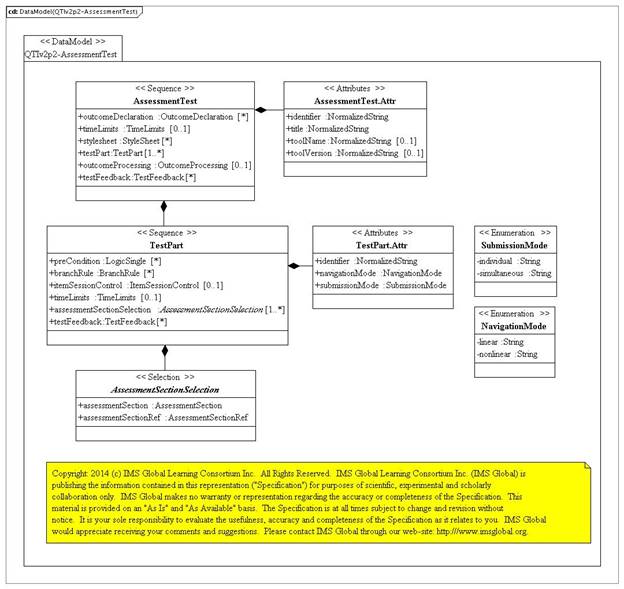
Figure B1.2 Assessment test PSM.
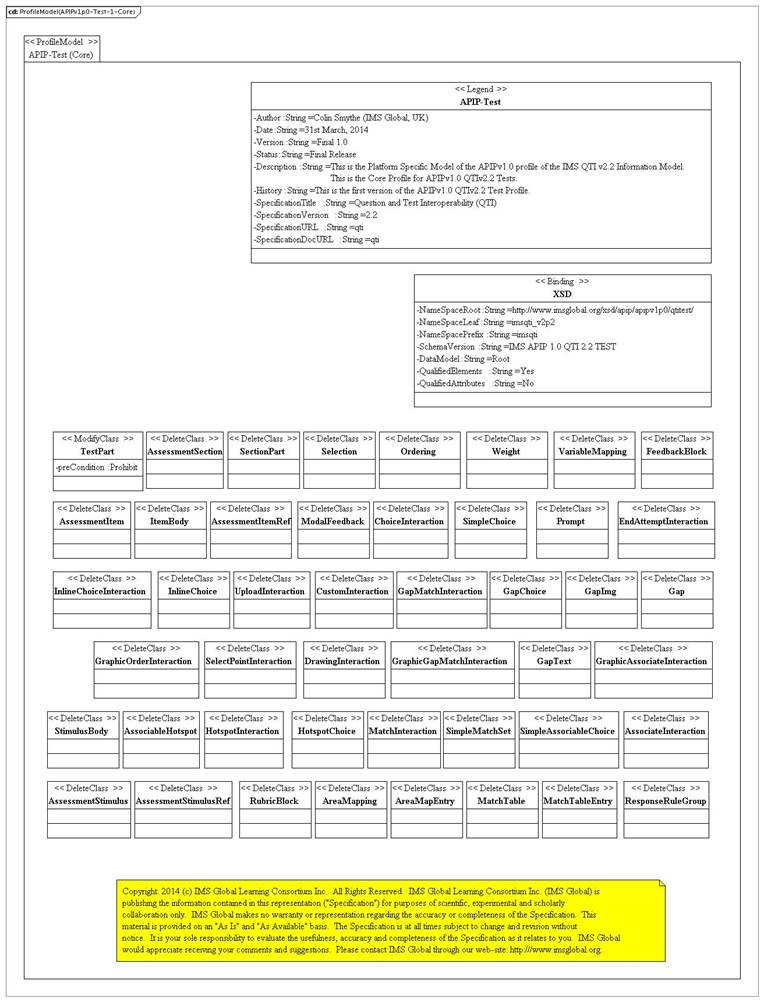
Figure B1.3a Assessment test APIP core profile PSM.
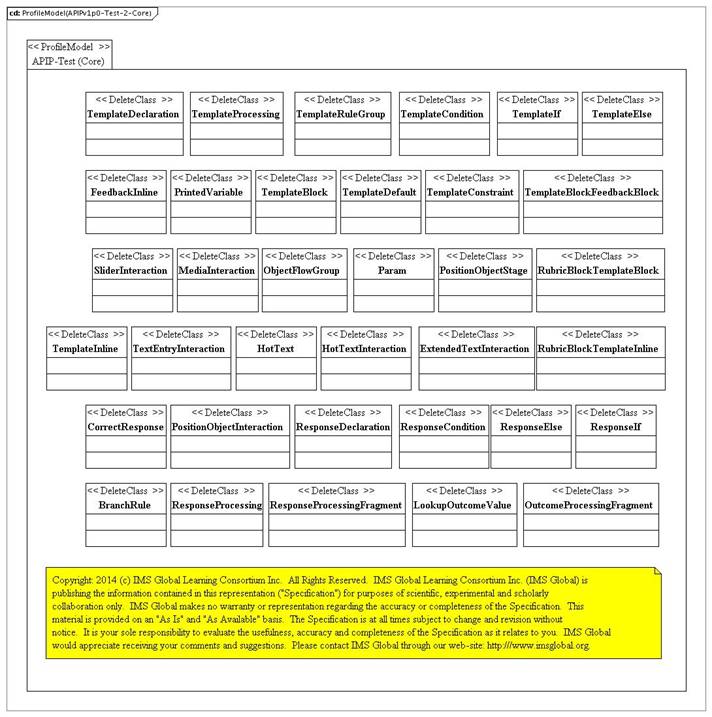
Figure B1.3b Assessment test APIP core profile PSM.
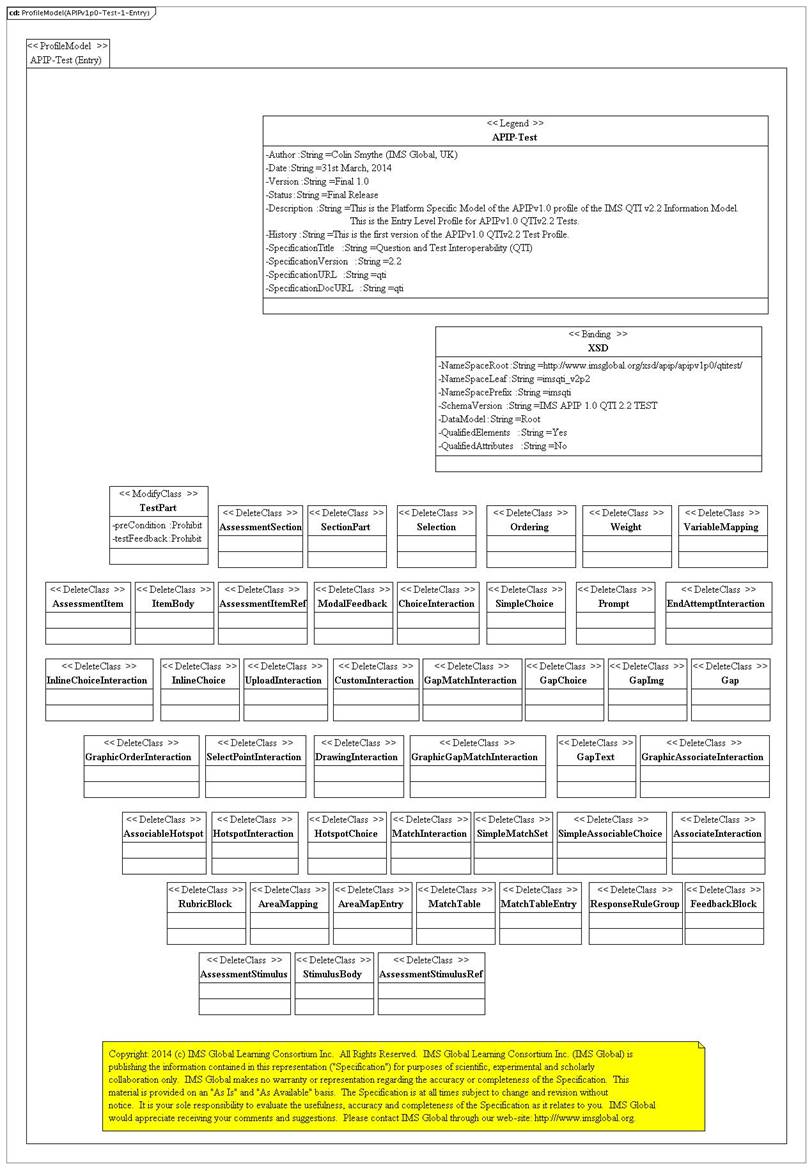
Figure B1.4a Assessment test APIP entry profile PSM.

Figure B1.4b Assessment test APIP entry profile PSM.
B1.2 Assessment Section PSMs
The PSMs for the QTI Assessment Test are shown in Figures B1.5, B1.6 and B1.7.
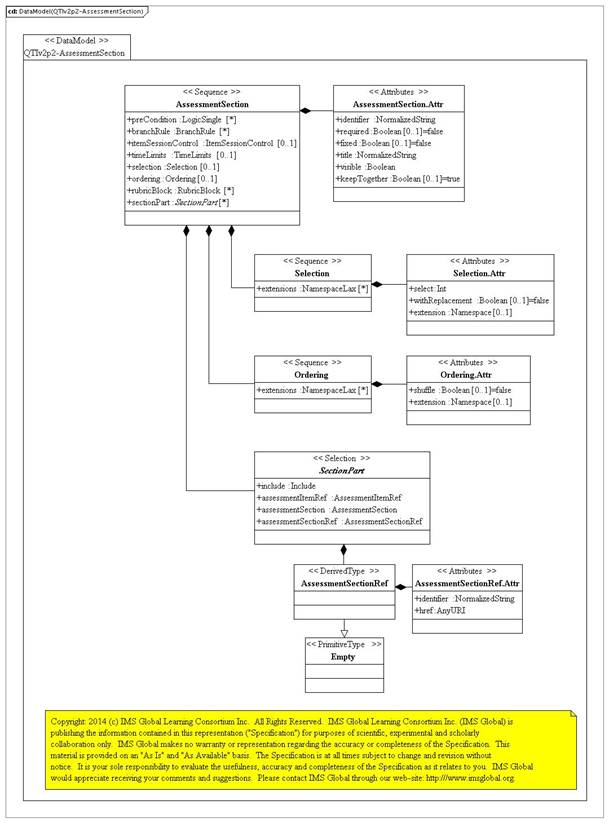
Figure B1.5 Assessment section PSM.

Figure B1.6a Assessment section APIP core profile PSM.
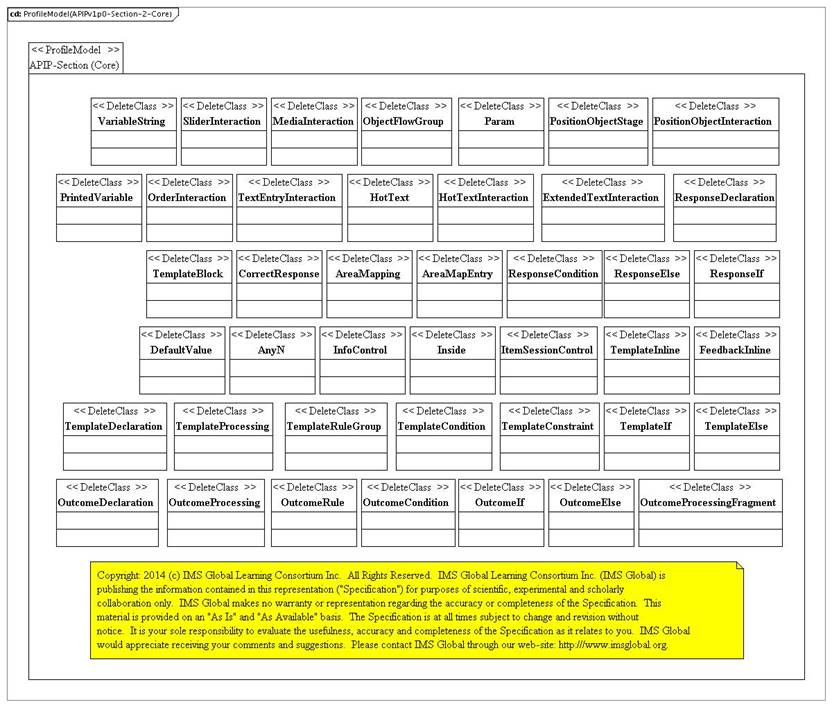
Figure B1.6b Assessment section APIP core profile PSM.
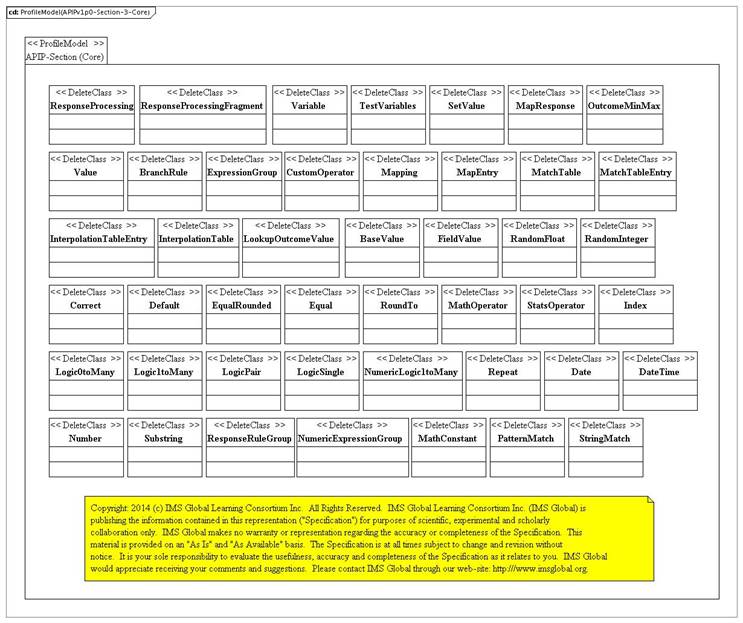
Figure B1.6c Assessment section APIP core profile PSM.
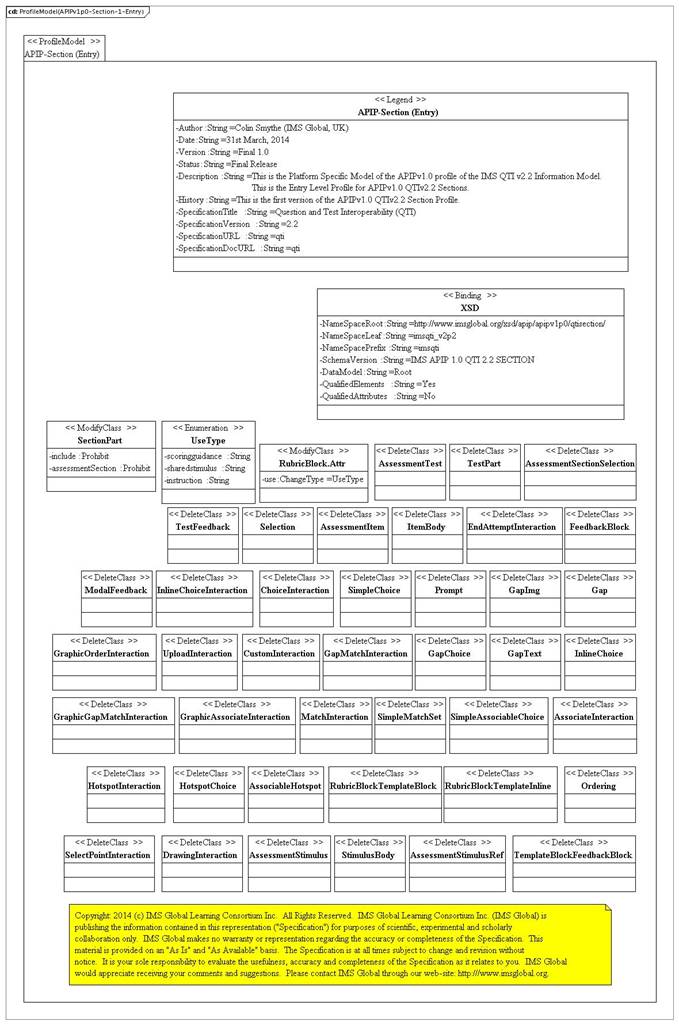
Figure B1.7a Assessment section APIP entry profile PSM.

Figure B1.7b Assessment section APIP entry profile PSM.
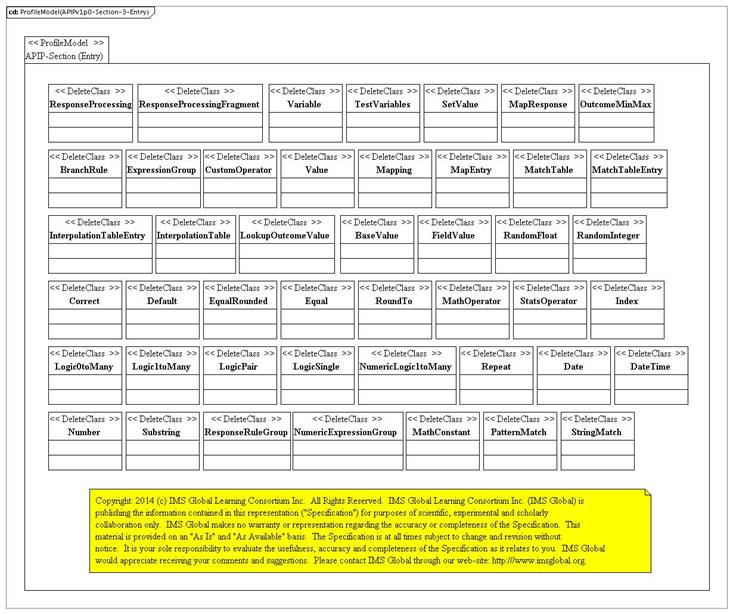
Figure B1.7c Assessment section APIP entry profile PSM.
B1.3 Assessment Item PSMs
The PSMs for the QTI Assessment Item are shown in Figures B1.8, B1.9 and B1.10.
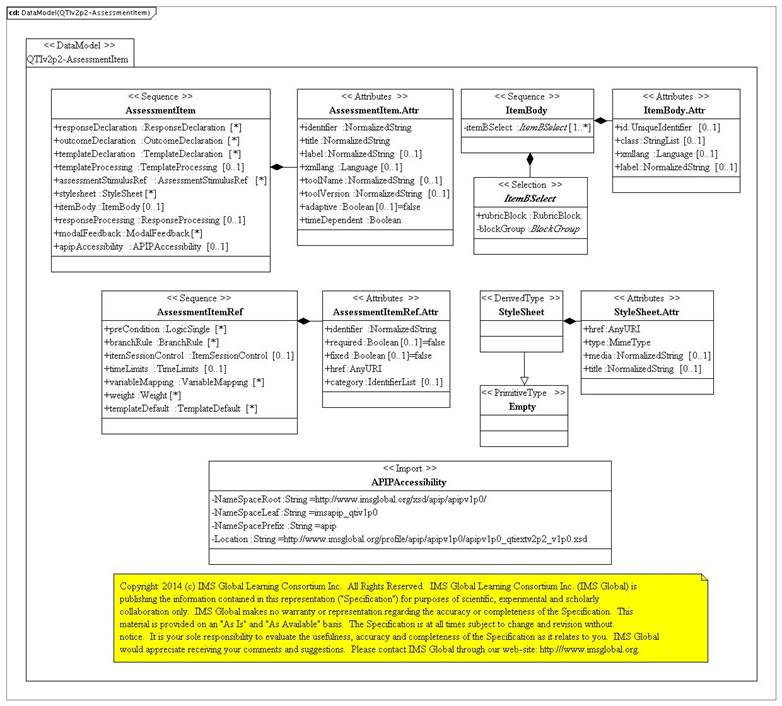
Figure B1.8 Assessment item PSM.

Figure B1.9 Assessment item APIP core profile PSM.
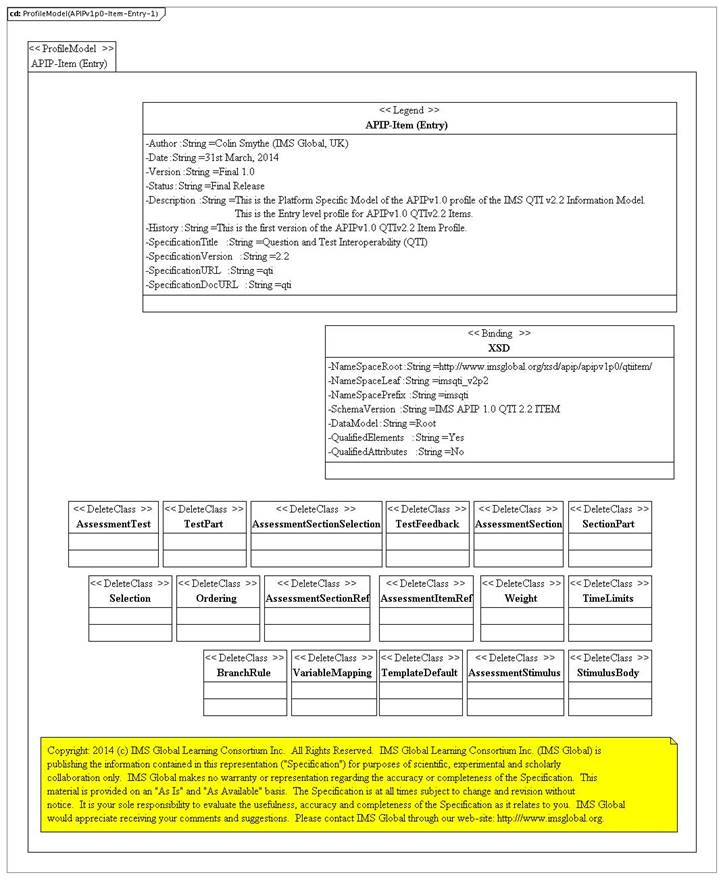
Figure B1.10 Assessment item APIP core profile PSM.
B1.5 Assessment Stimulus PSM
The PSMs for the QTI Assessment Stimulus are shown in Figures B1.11 and B1.12.
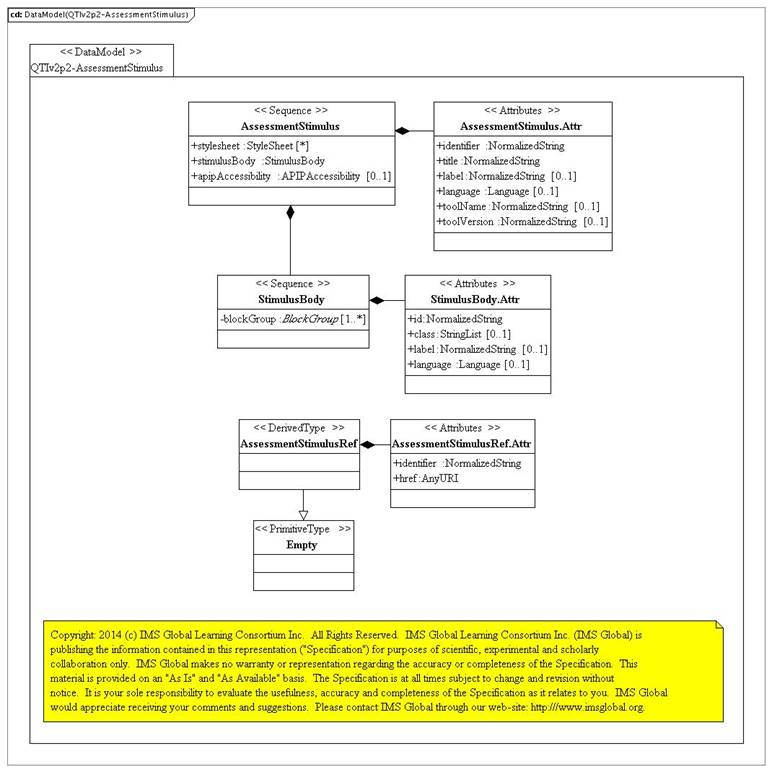
Figure B1.11 QTI assessment stimulus PSM.
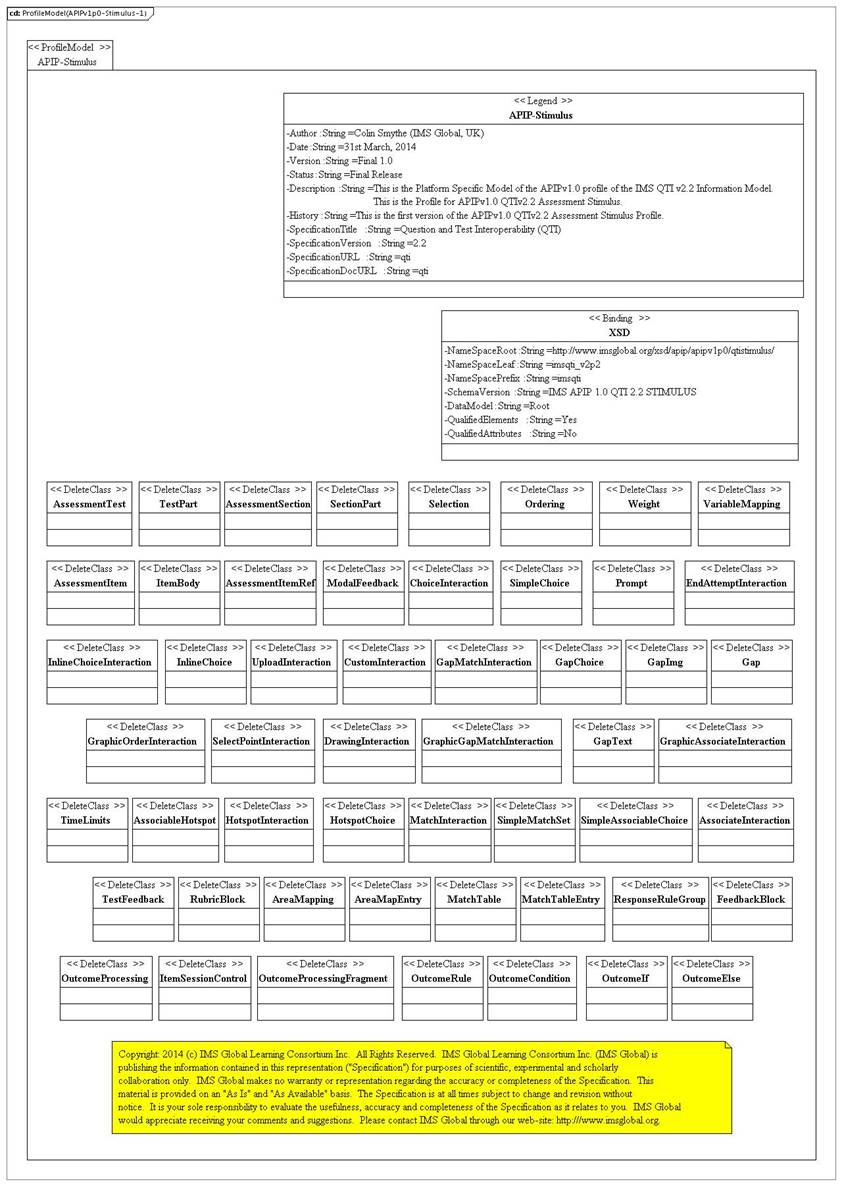
Figure B1.12a QTI assessment stimulus profile PSM.
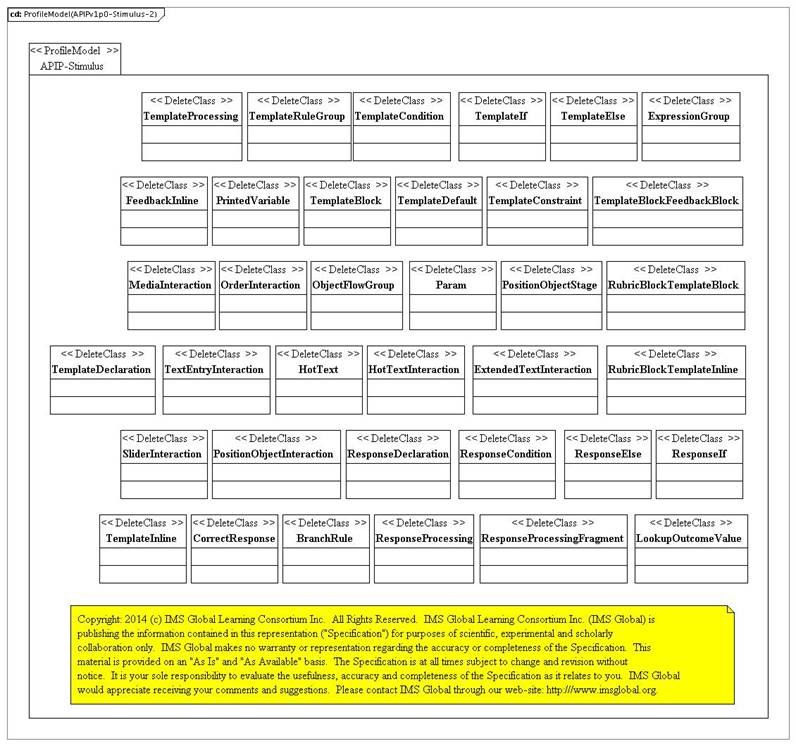
Figure B1.12b QTI assessment stimulus profile PSM.

Figure B1.12c QTI assessment stimulus profile PSM.
B1.3 General QTI PSMs
The PSMs used to support the definition of the Assessment Test, Section and Item classes are shown in Figures B1.13 to B1.29.

Figure B1.13 QTI block group PSM.
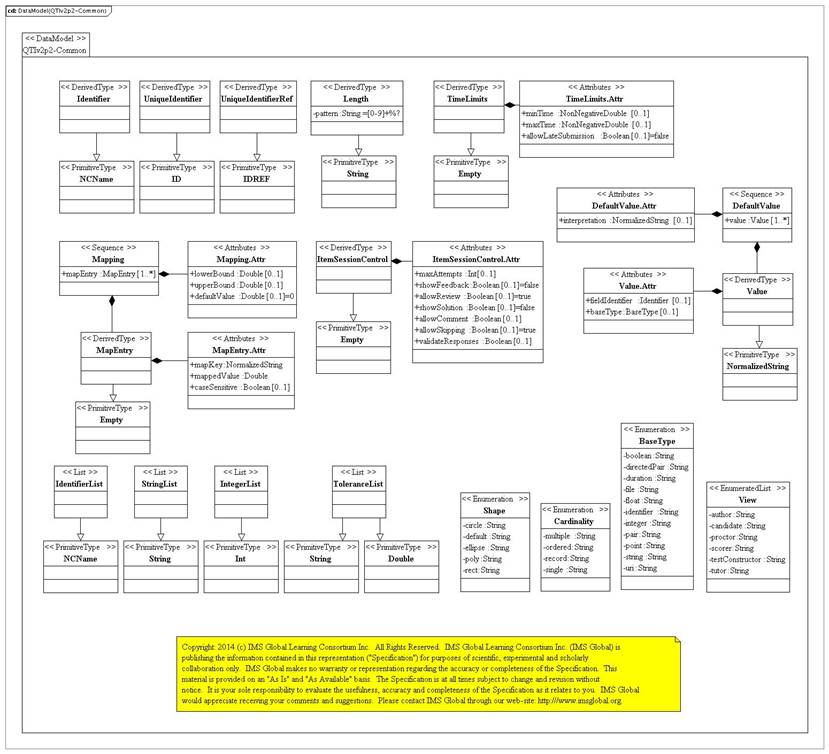
Figure B1.14 QTI common PSM.

Figure B1.15a QTI content model PSM.
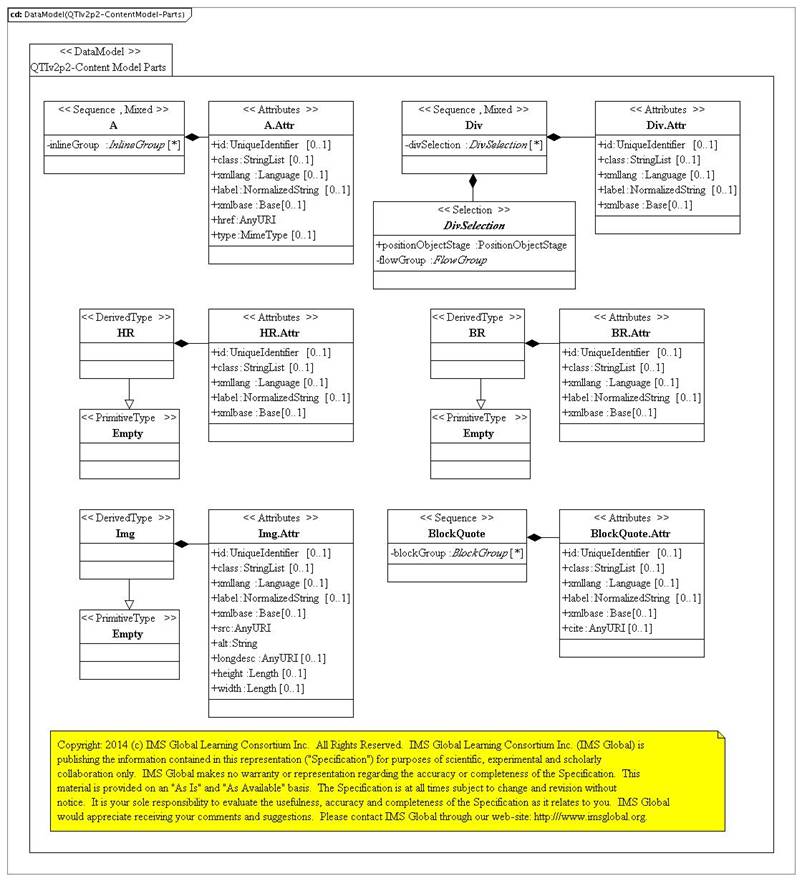
Figure B1.15b QTI content model PSM.

Figure B1.15c QTI content model PSM.

Figure B1.15d QTI content model PSM.
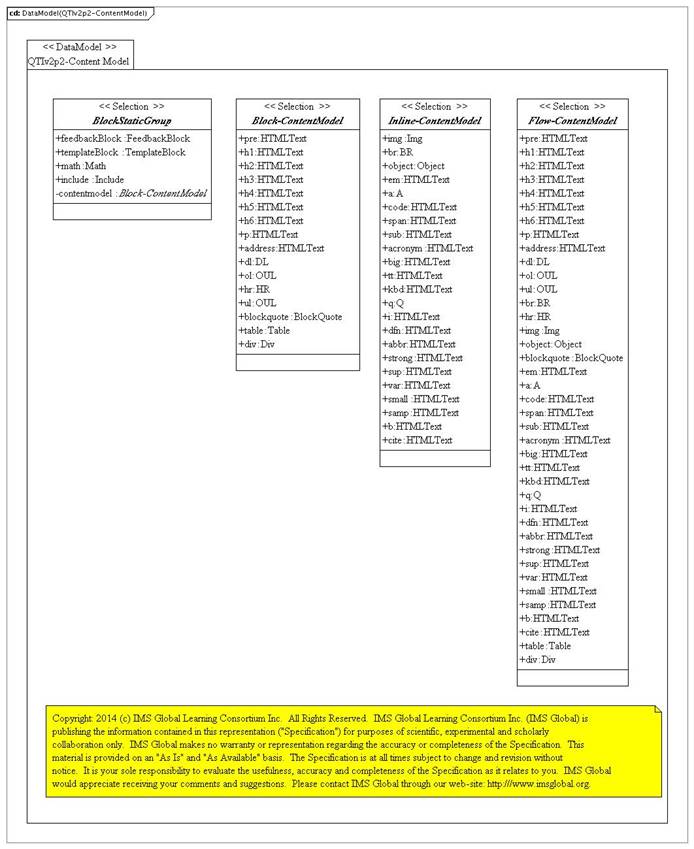
Figure B1.15e QTI content model PSM.
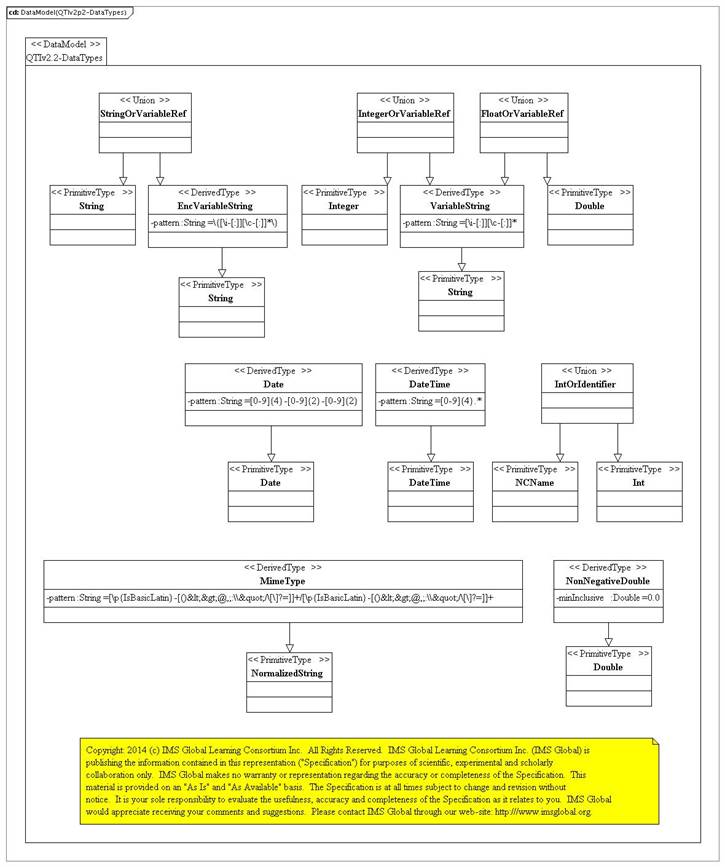
Figure B1.16 QTI data types PSM.
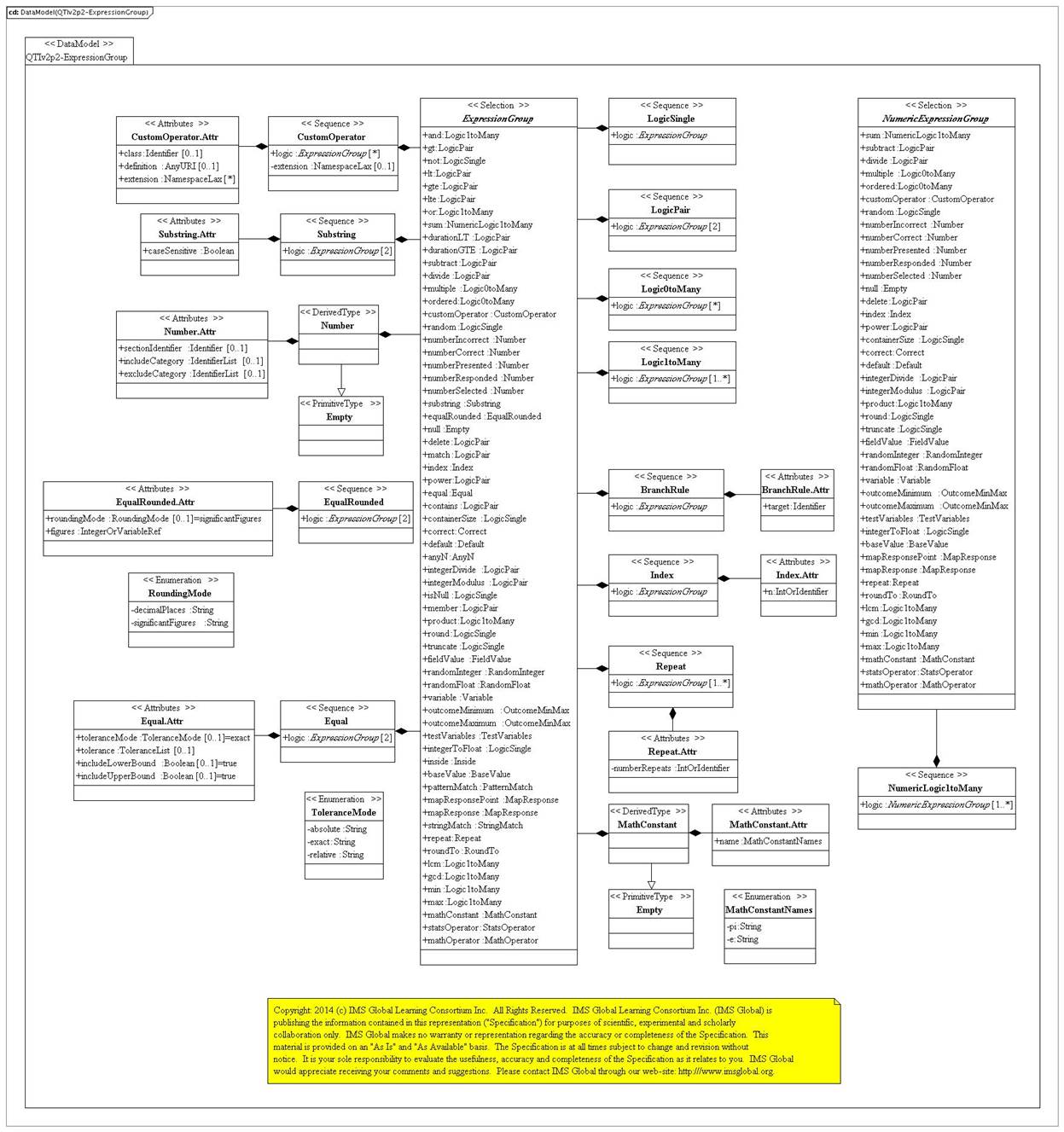
Figure B1.17a QTI expression group PSM.
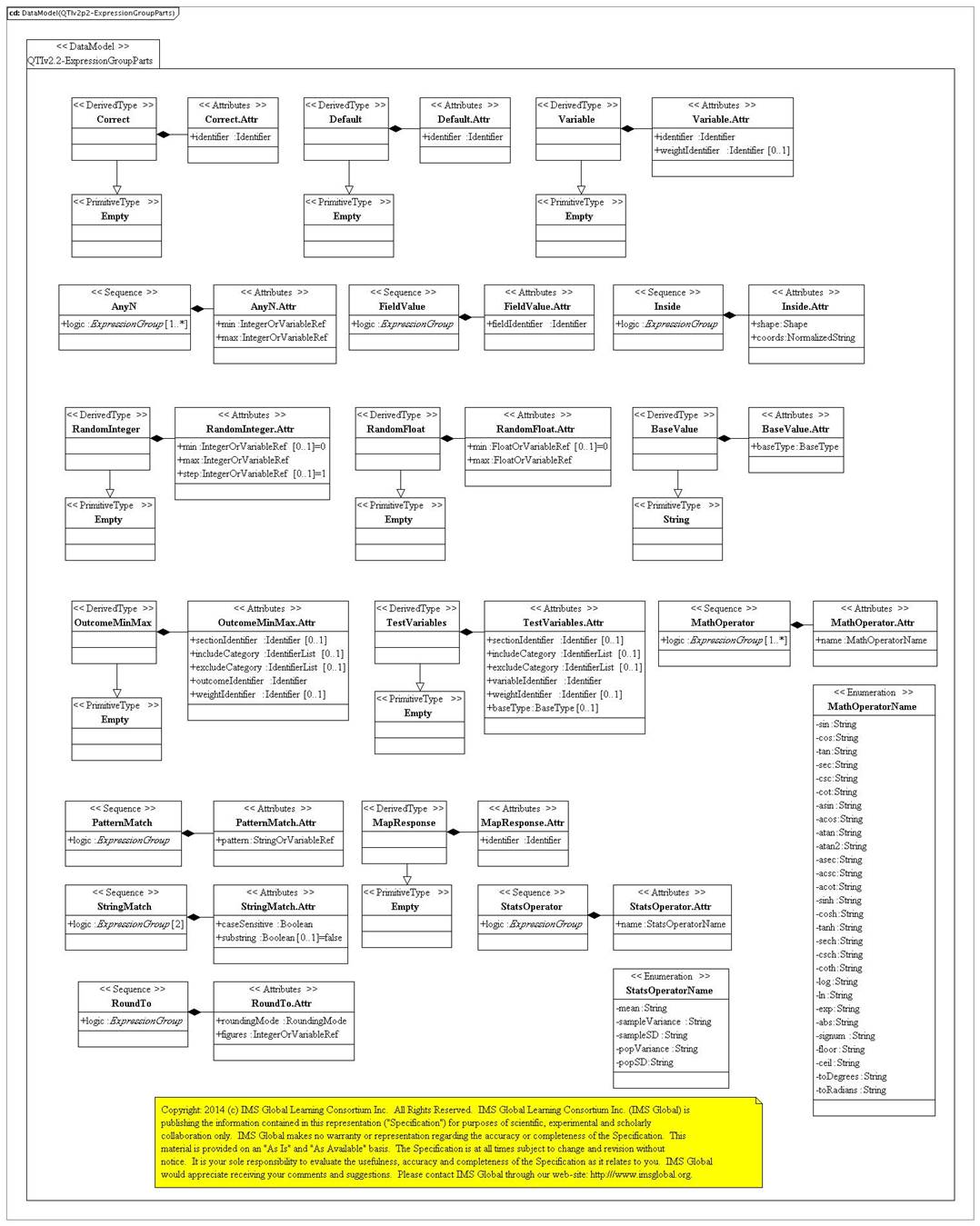
Figure B1.17b QTI expression group PSM.

Figure B1.18 QTI feedback PSM.
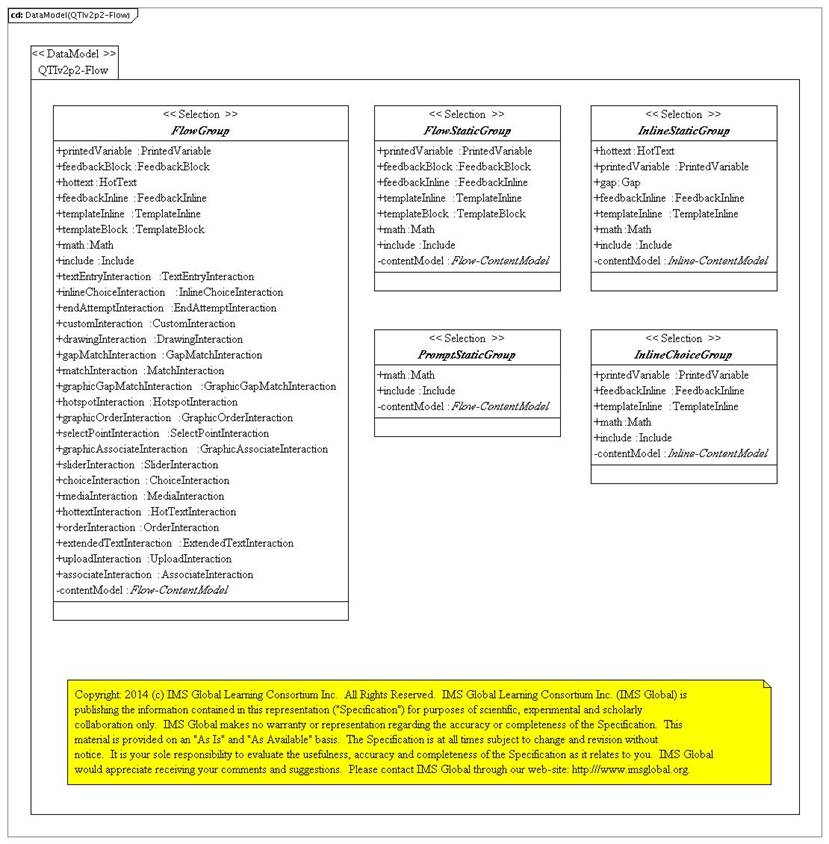
Figure B1.19 QTI flow PSM.
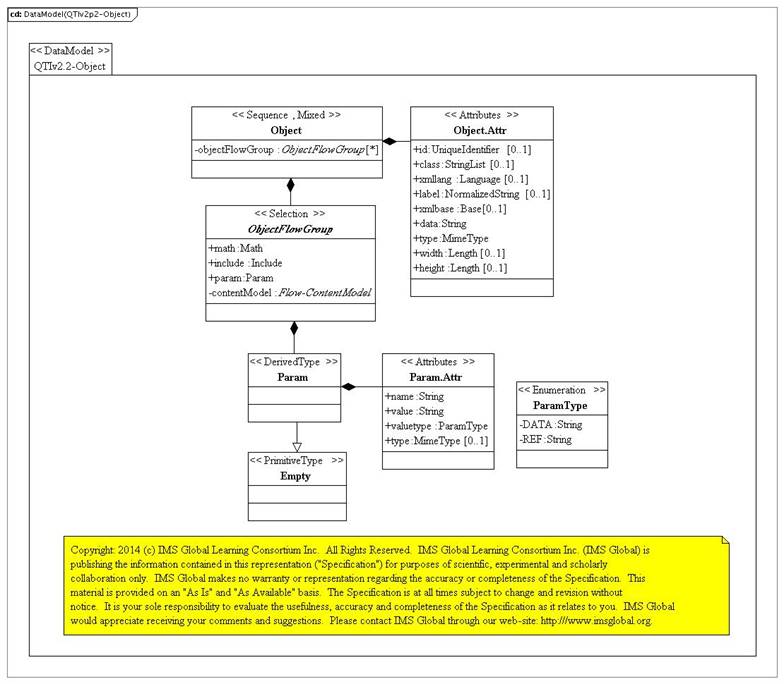
Figure B1.20 QTI object PSM.

Figure B1.21 QTI outcome declaration PSM.
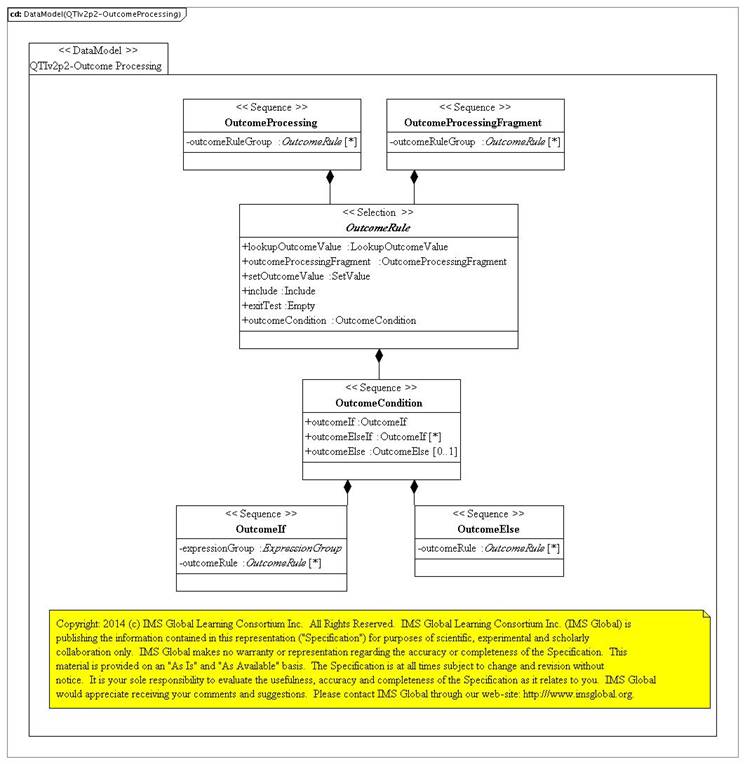
Figure B1.22 QTI outcome processing PSM.

Figure B1.23 QTI response declaration PSM.
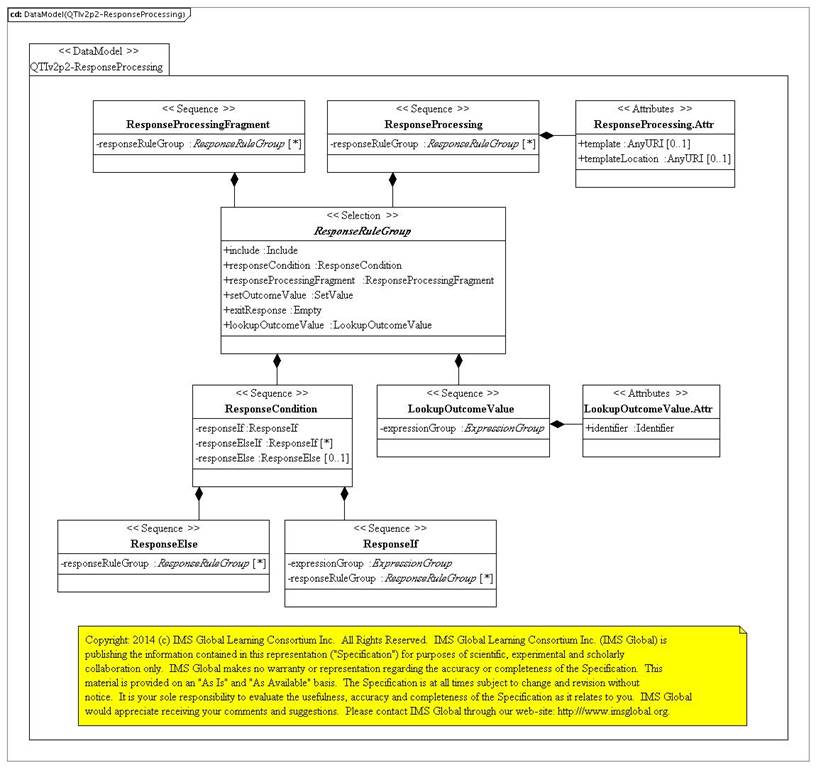
Figure B1.24 QTI response processing PSM.
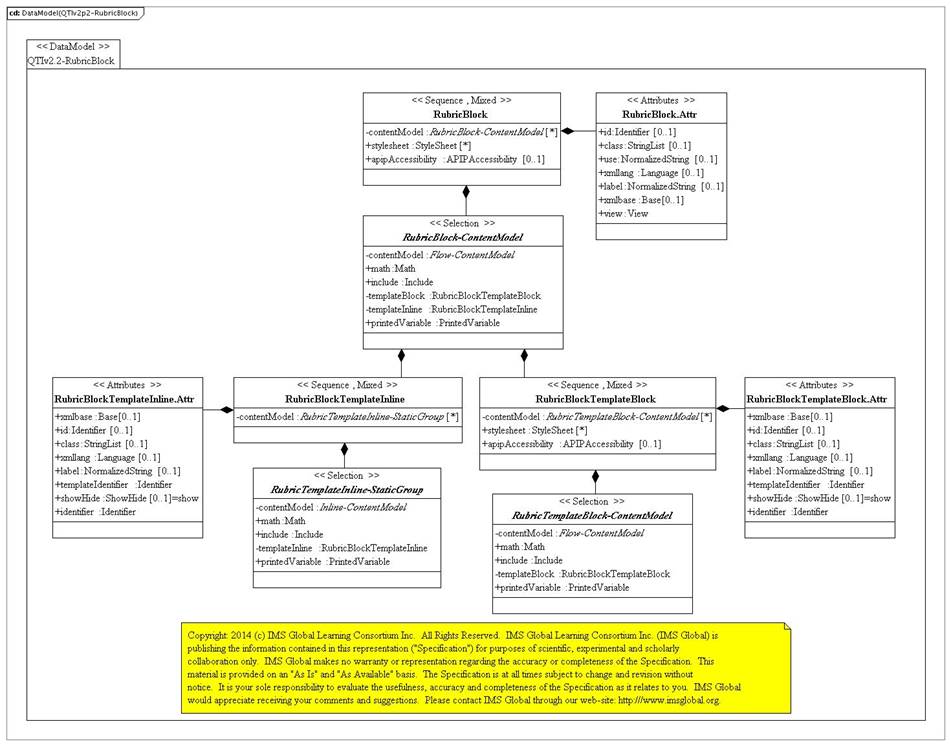
Figure B1.25 QTI rubric block PSM.
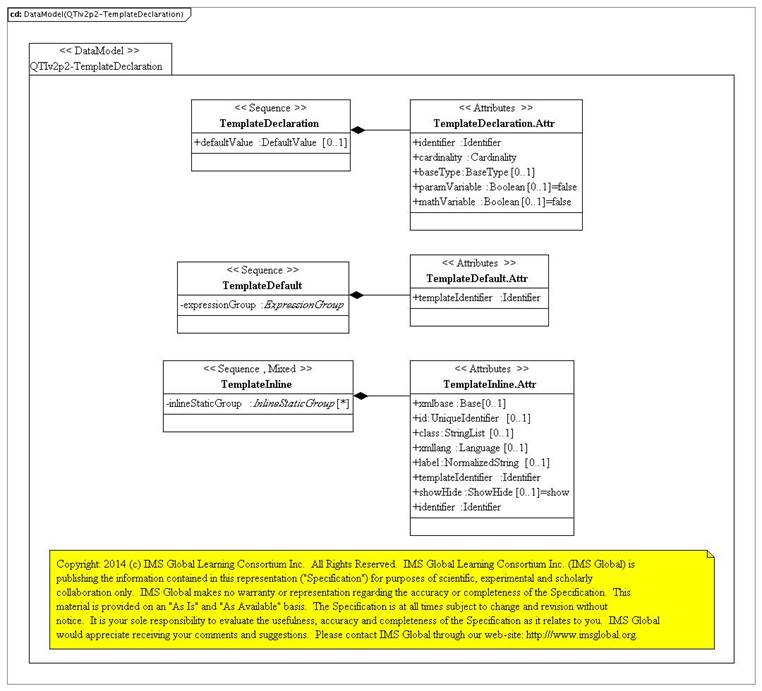
Figure B1.26 QTI template declaration PSM.
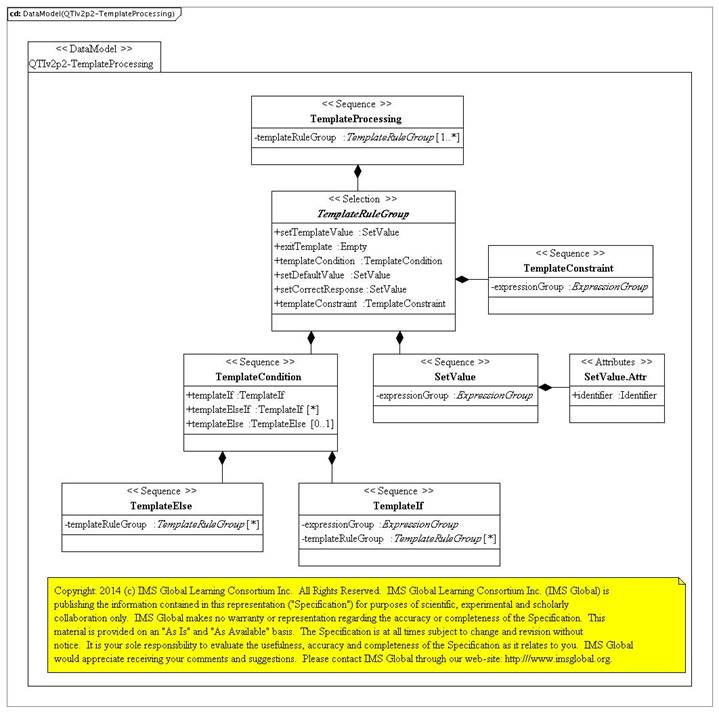
Figure B1.27 QTI template processing PSM.
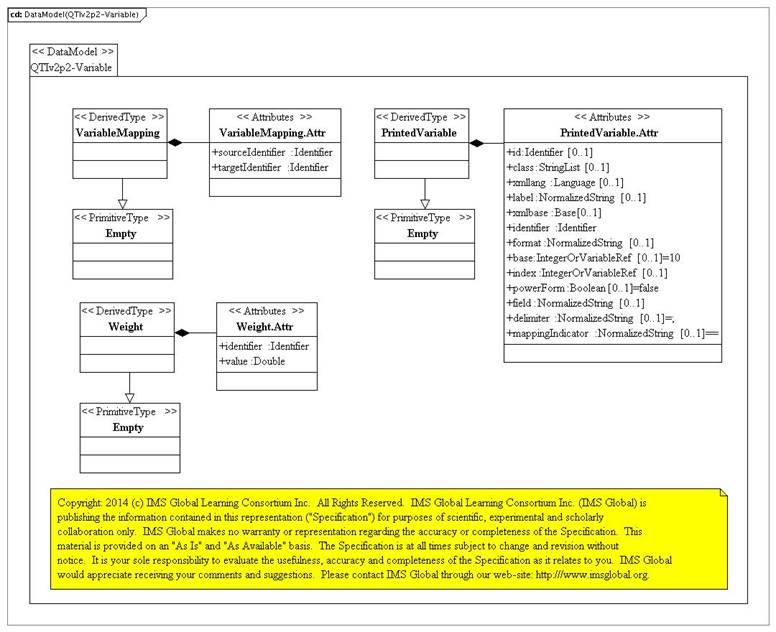
Figure B1.28 QTI variable PSM.

Figure B1.29a QTI interaction (choice) PSM.
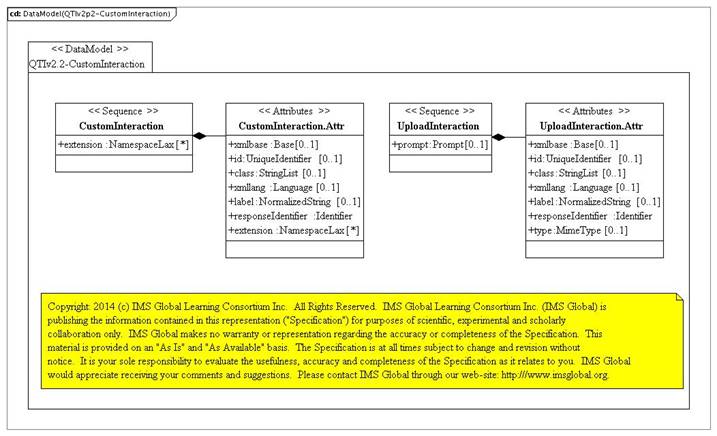
Figure B1.29b QTI interaction (custom and upload) PSM.
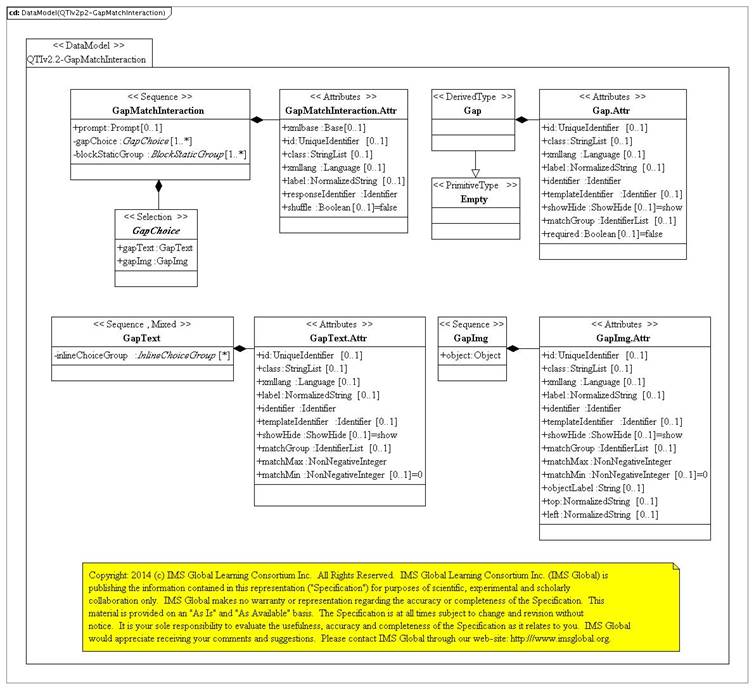
Figure B1.29c QTI interaction (gap text and gap match) PSM.

Figure B1.29d QTI interaction (graphic-based) PSM.

Figure B1.29e QTI interaction (hotspot) PSM.
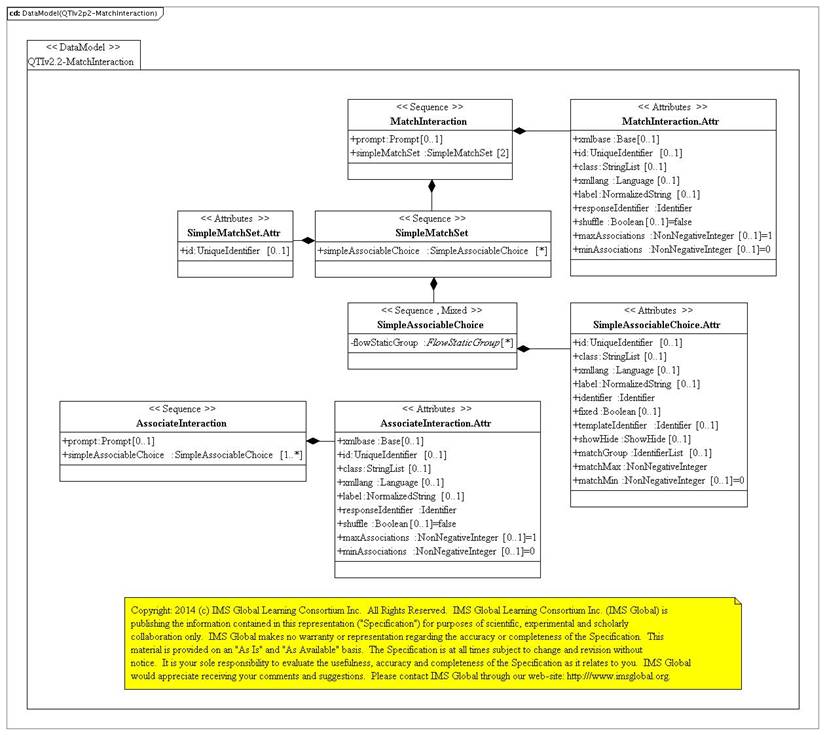
Figure B1.29f QTI interaction (match) PSM.
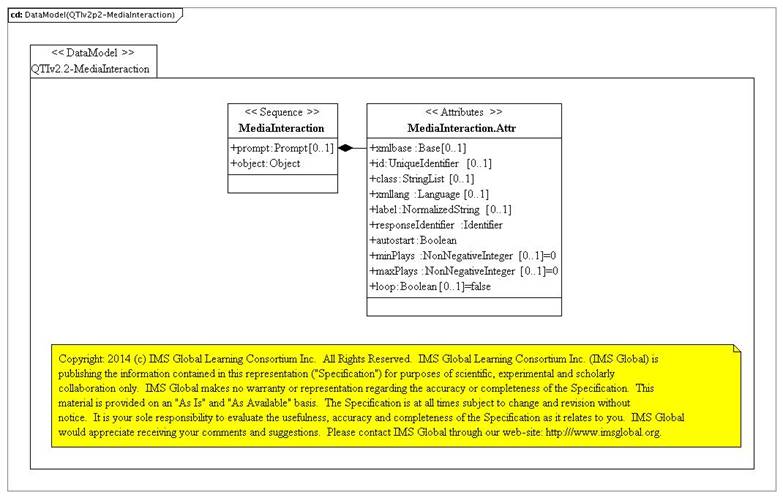
Figure B1.29g QTI interaction (media) PSM.
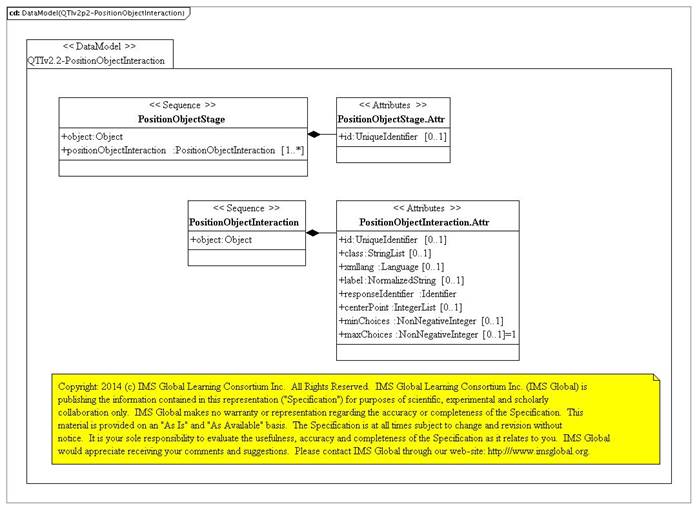
Figure B1.29h QTI interaction (position object) PSM.
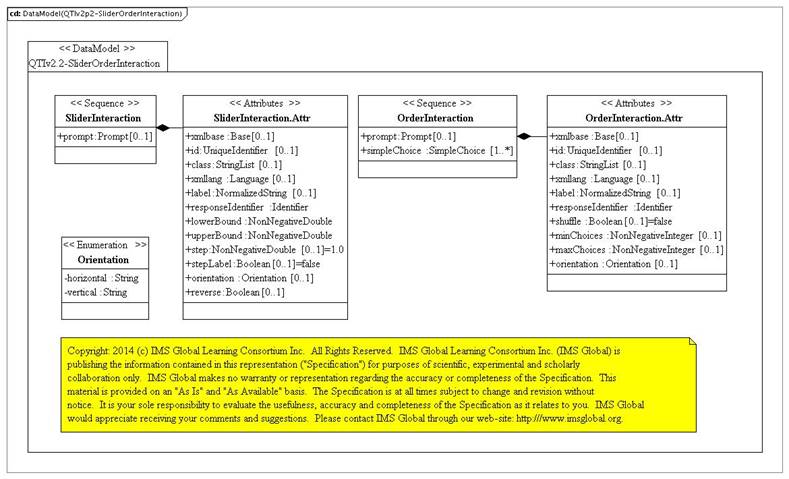
Figure B1.29i QTI interaction (slider and order) PSM.
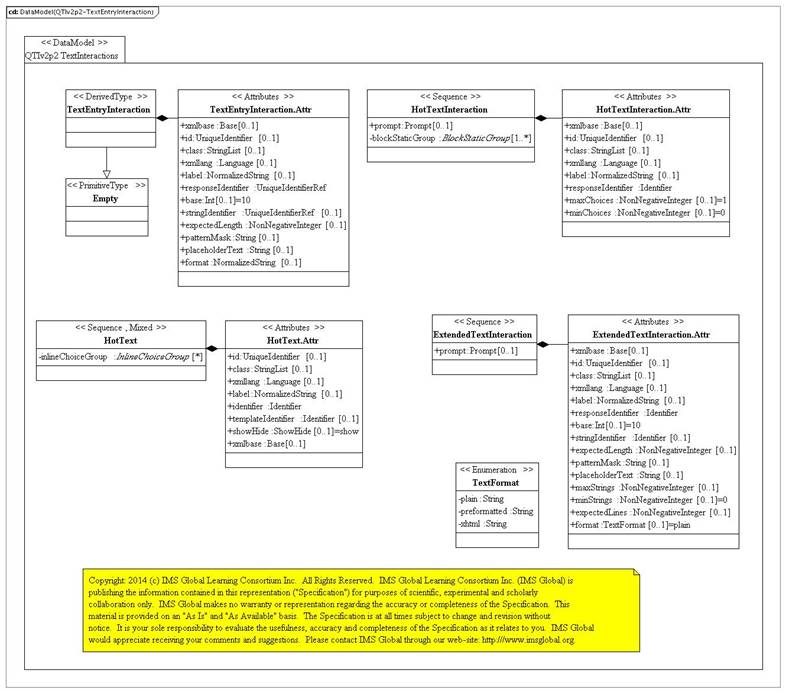
Figure B1.29j QTI interaction (text) PSM.
B1.4 Outcomes Declaration Profile PSM
The PSMs used to support the definition of the QTI Outcomes Declaration profile classes are shown in Figures B1.30a, B1.30b and B1.30c.
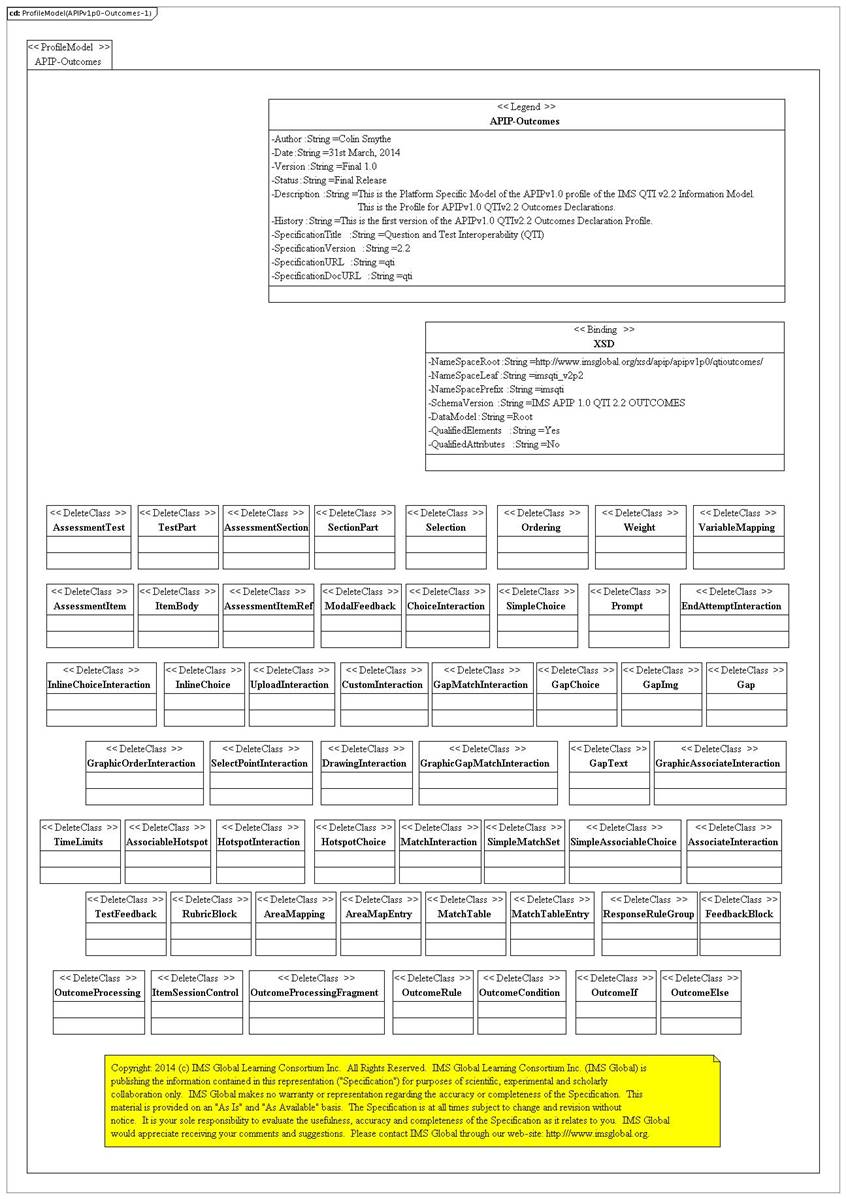
Figure B1.30a QTI outcomes declaration profile PSM.
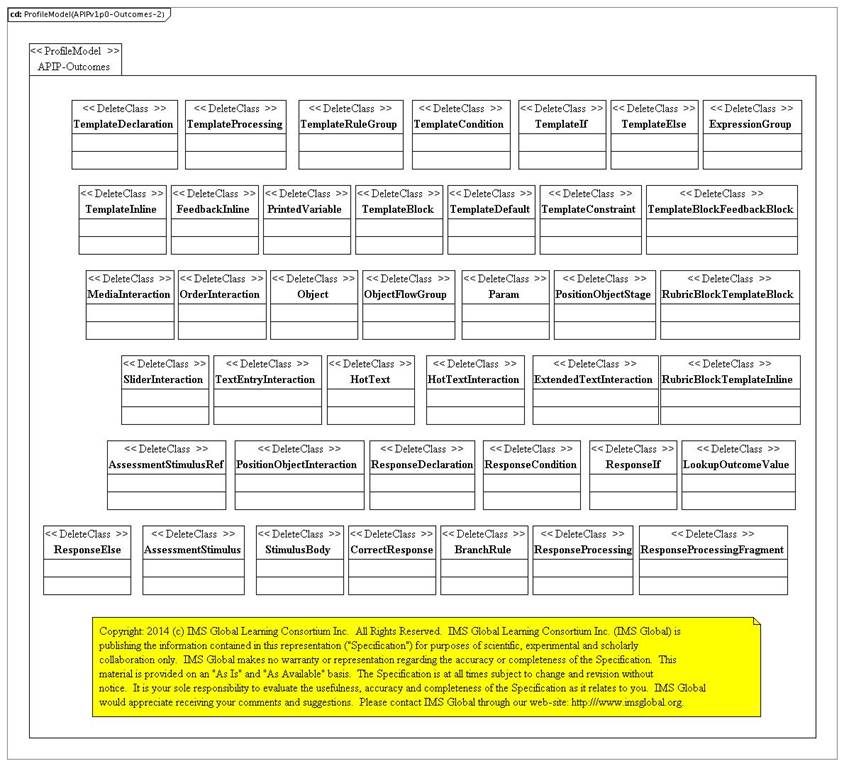
Figure B1.30b QTI outcomes declaration profile PSM.

Figure B1.30c QTI outcomes declaration profile PSM.
B1.5 Template-based Response Processing Profile PSM
The PSMs used to support the definition of the QTI Response Processing profile classes are shown in Figures B1.31a, B1.31b and B1.31c.
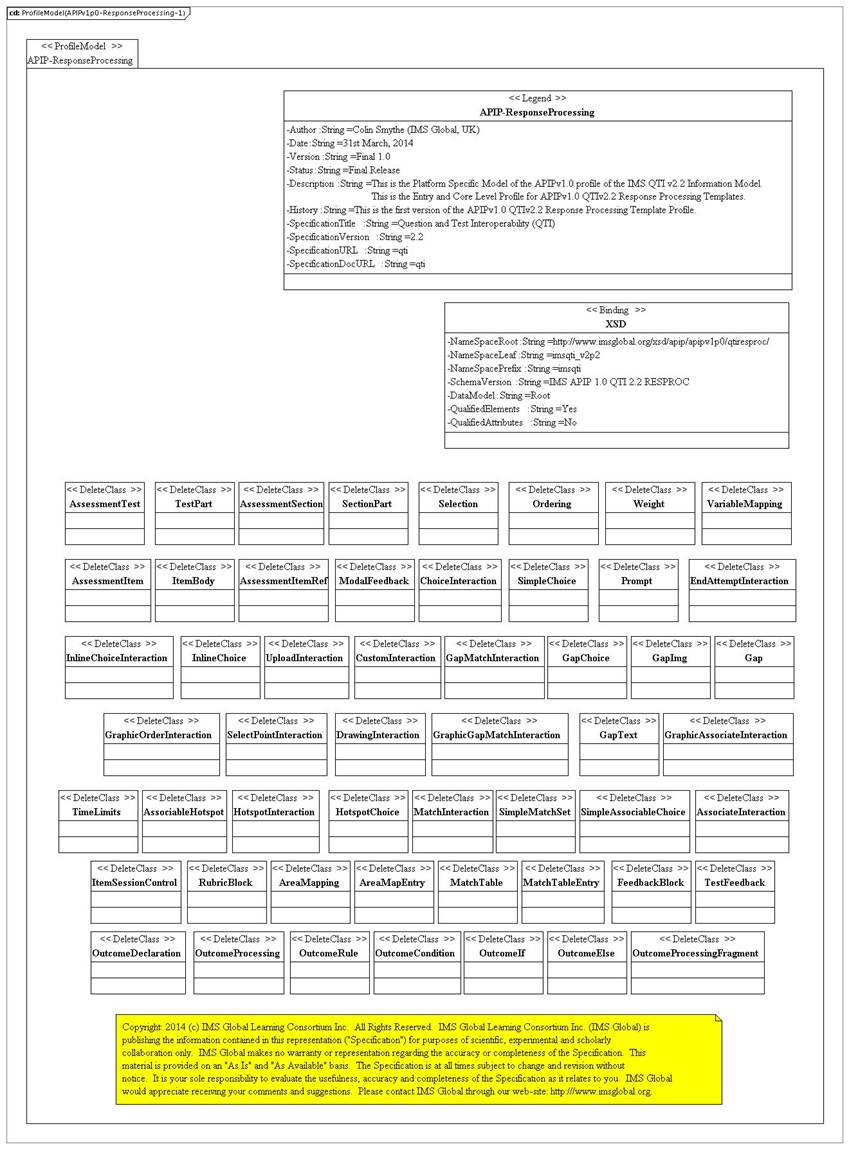
Figure B1.31a QTI response processing profile PSM.
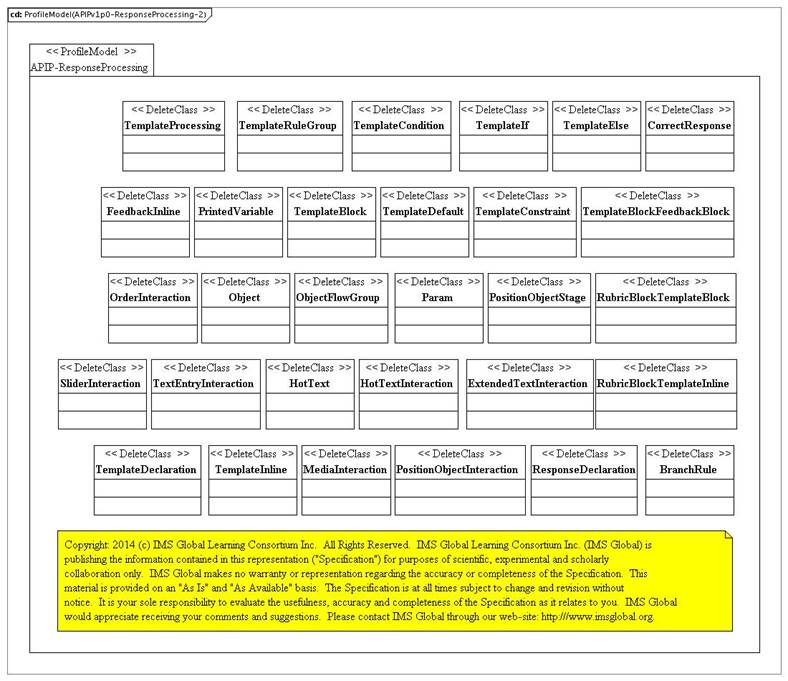
Figure B1.31b QTI response processing profile PSM.
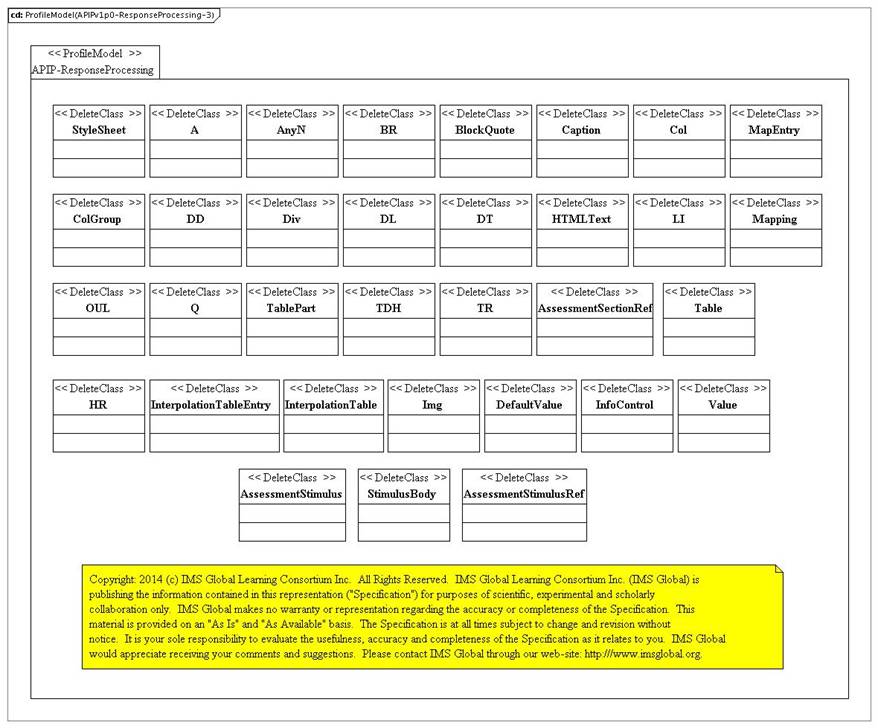
Figure B1.31c QTI response processing profile PSM.
B1.6 Metadata PSM
The PSMs used to support the definition of the QTI Metadata classes are shown in Figures B1.32, B1.33 and B1.34.

Figure B1.32 QTI metadata root PSM.

Figure B1.33 QTI metadata PSM.
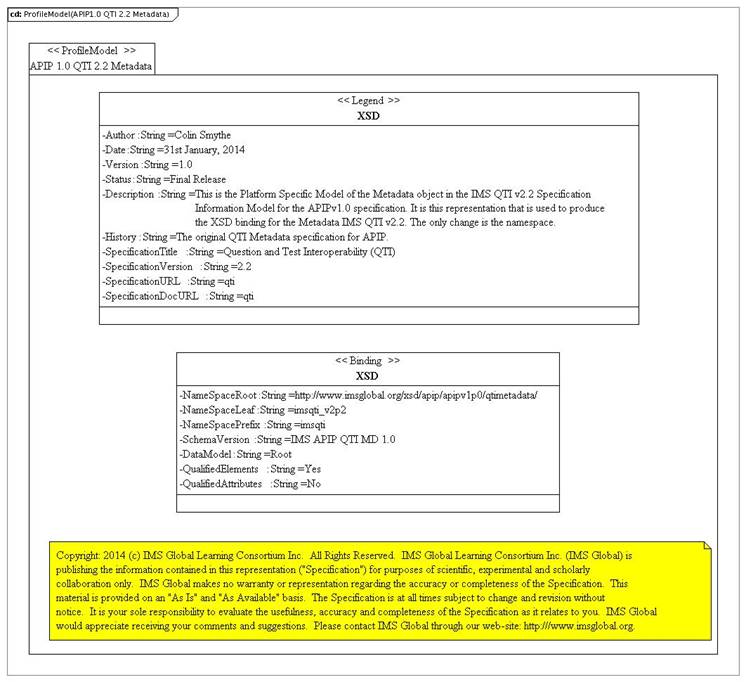
Figure B1.34 QTI metadata APIP profile PSM.
B2 QTI v2.2 Accessibility Information PSM
The PSMs for the QTI accessibility information are shown in Figures B2.1, B2.1, B2.3, B2.4, B2.5, B2.6, B2.7 and B2.8.
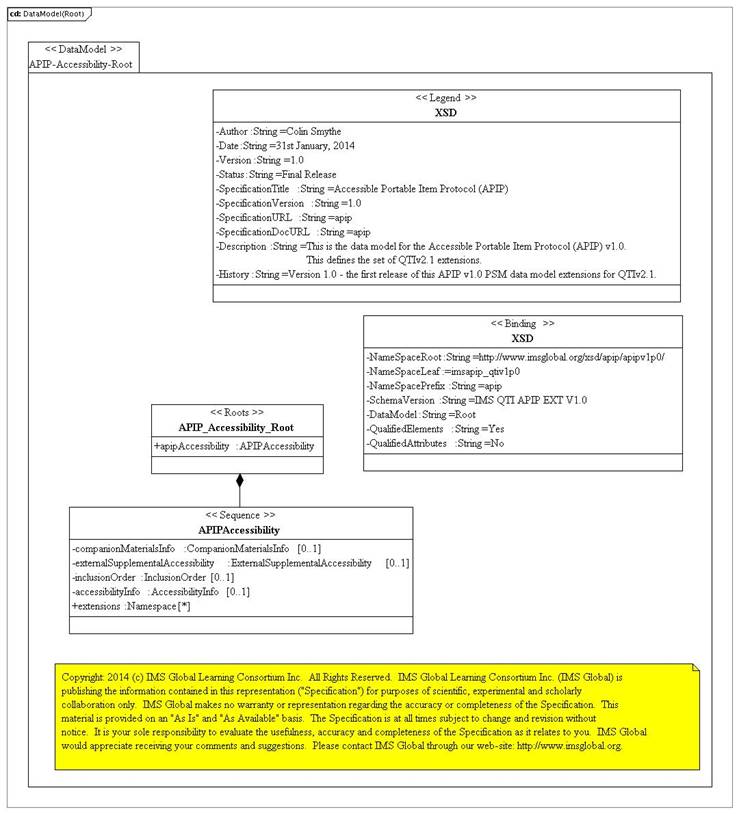
Figure B2.1 QTI accessibility root PSM.

Figure B2.2 QTI accessibility inclusion order PSM.
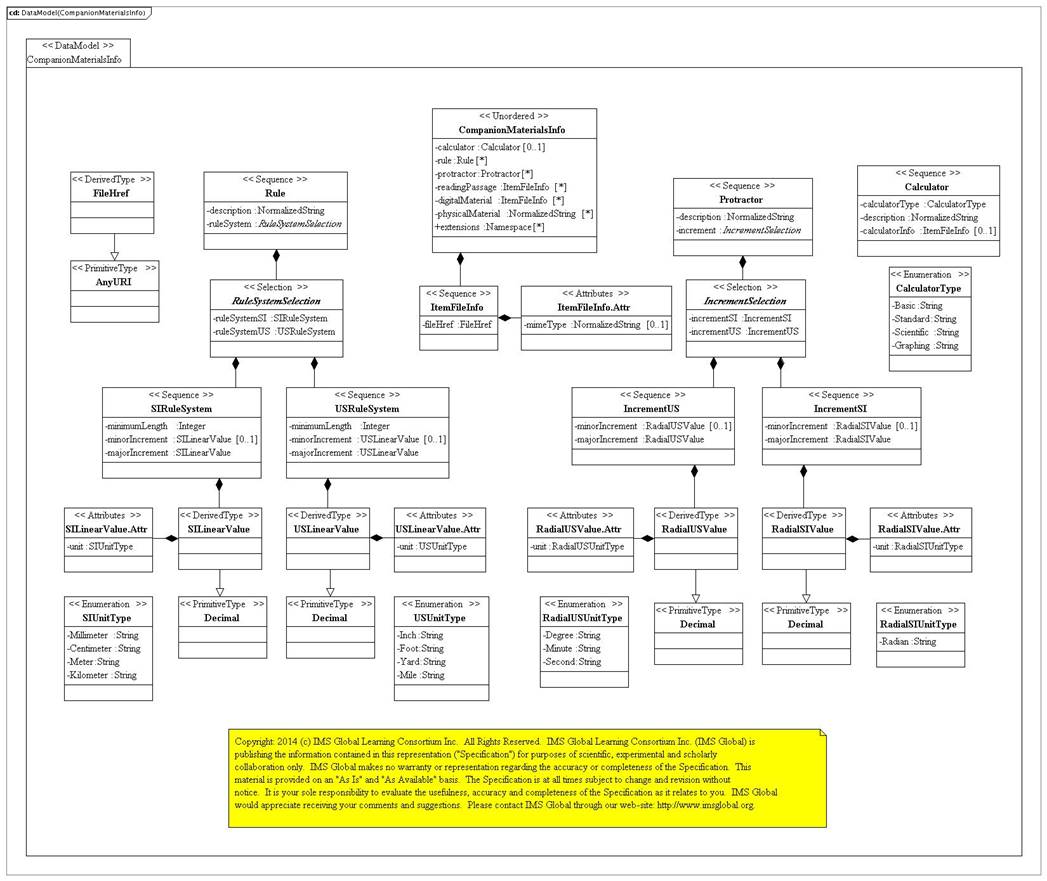
Figure B2.3 QTI accessibility companion materials PSM.

Figure B2.4 External supplemental accessibility PSM.
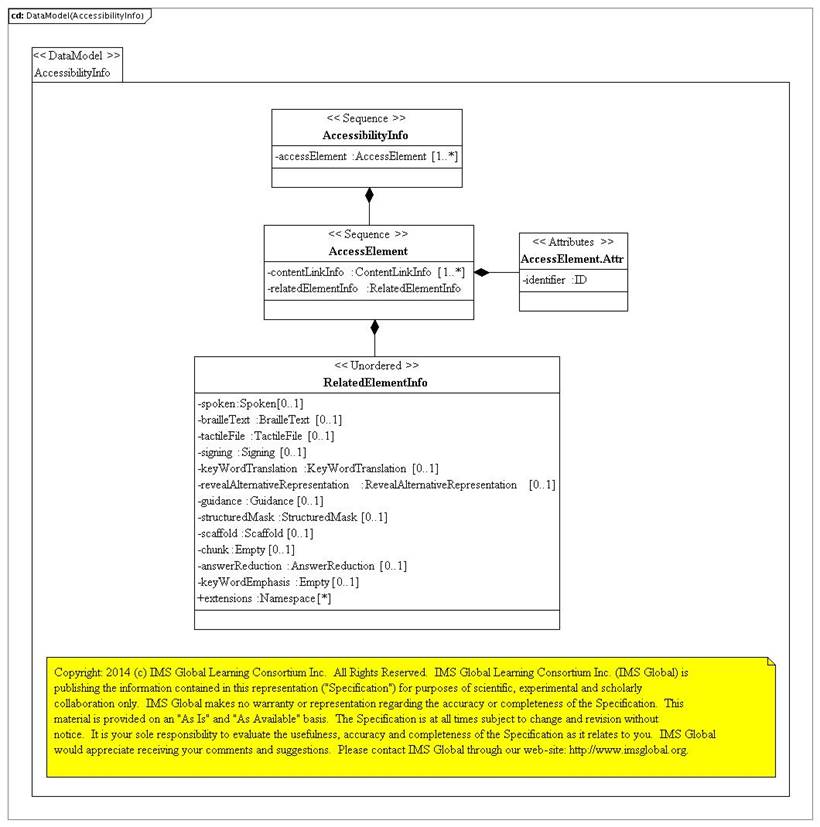
Figure B2.5 QTI accessibility information PSM.
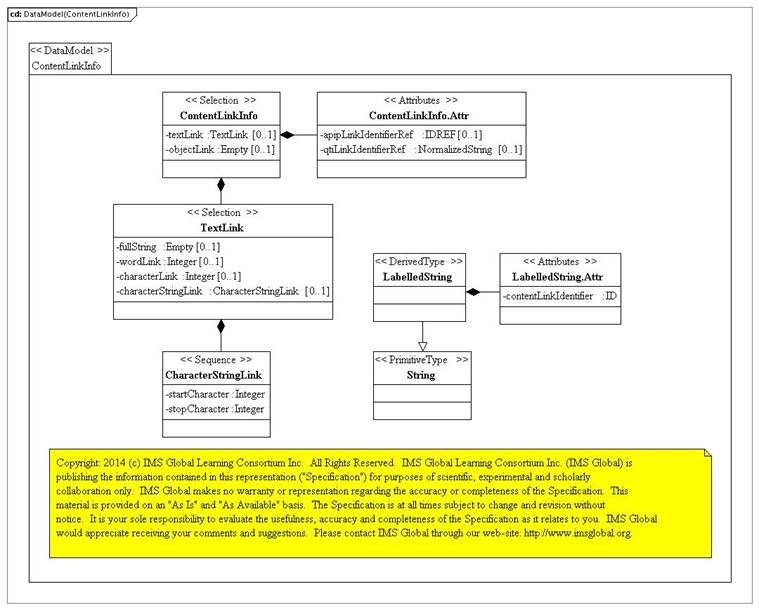
Figure B2.6 QTI accessibility content link PSM.

Figure B2.7 QTI accessibility audio-based content PSM.

Figure B2.8 QTI accessibility non-audio-based content PSM.
B3 Profiled CP v1.2 PSM
The PSMs for the profiled IEEE LOM are shown in Figures B3.1, B3.2, B3.3, B3.4, B3.5 and B3.6.

Figure B3.1 Content packaging root PSM.

Figure B3.2 Content packaging organizations PSM.
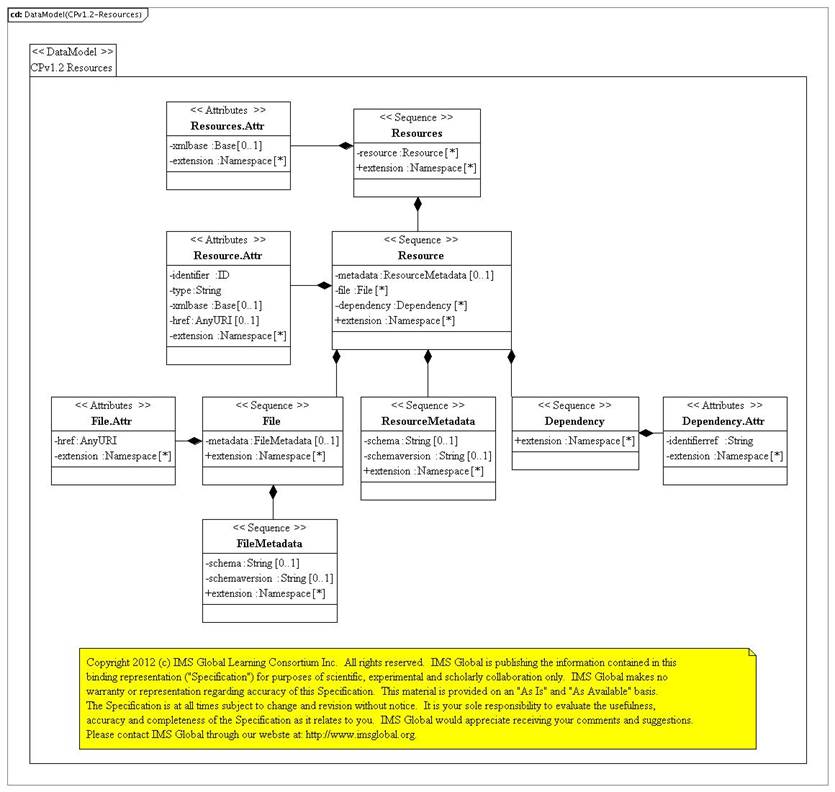
Figure B3.3 Content packaging resources PSM.
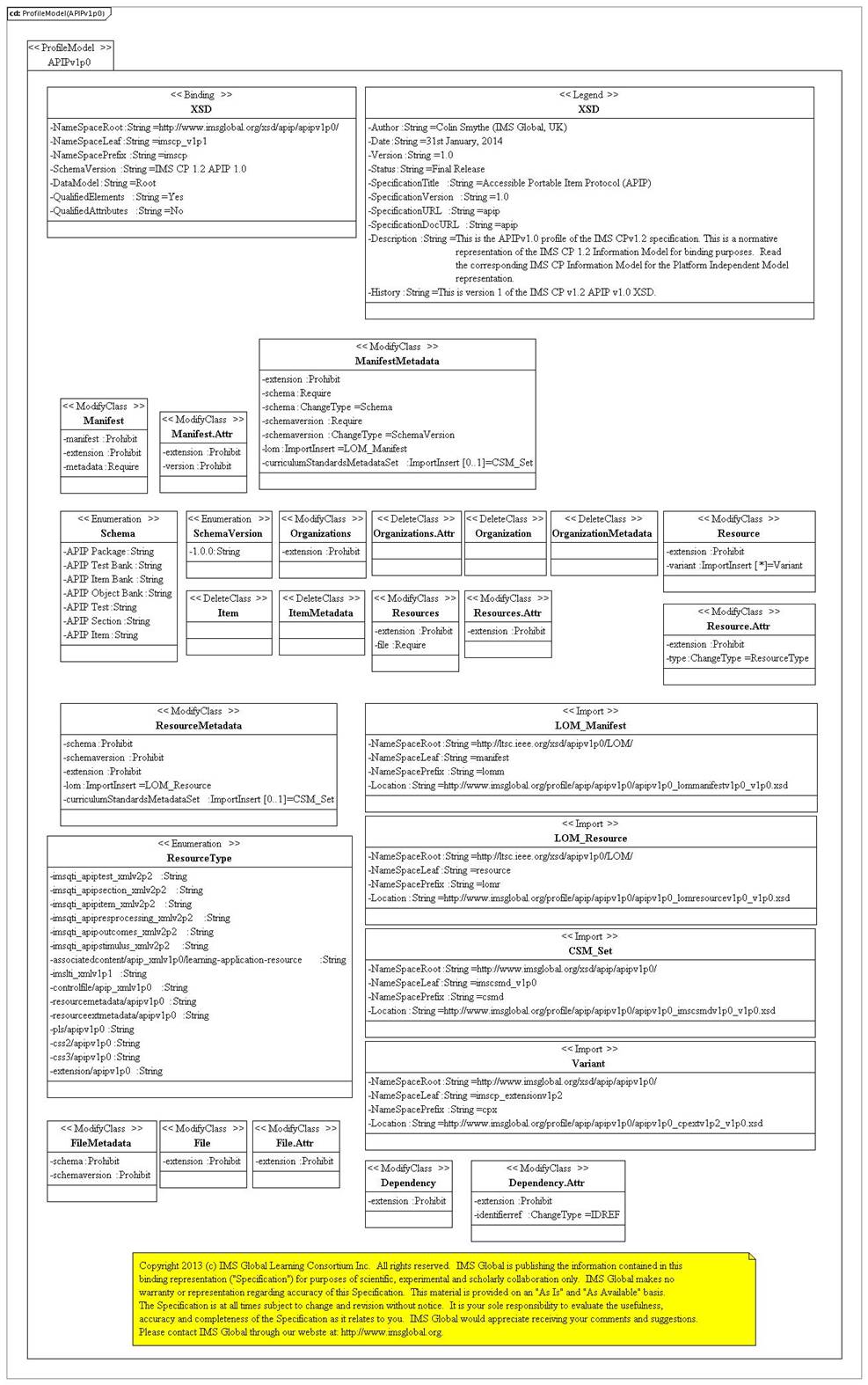
Figure B3.4 Content packaging APIP profile PSM.
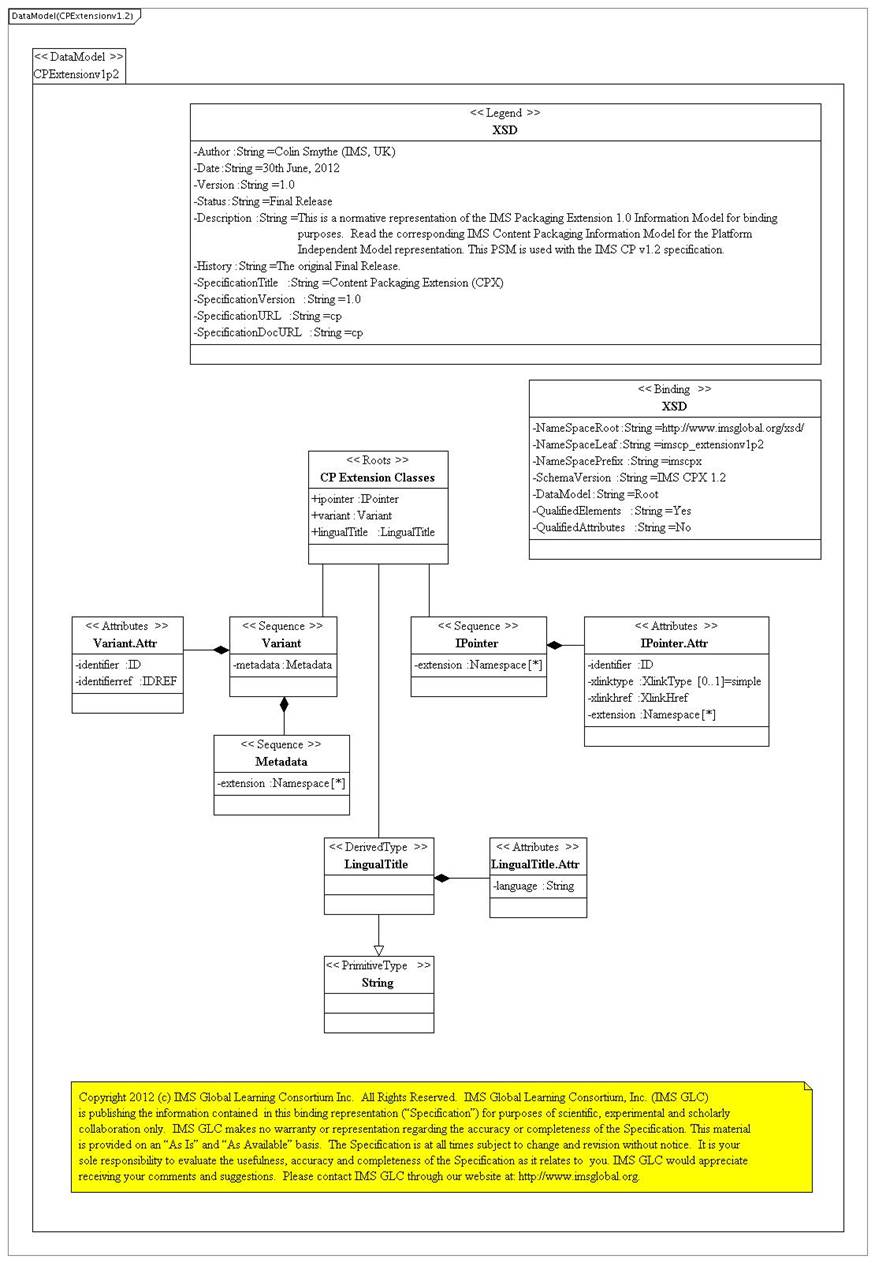
Figure B3.5 Content packaging extension PSM.
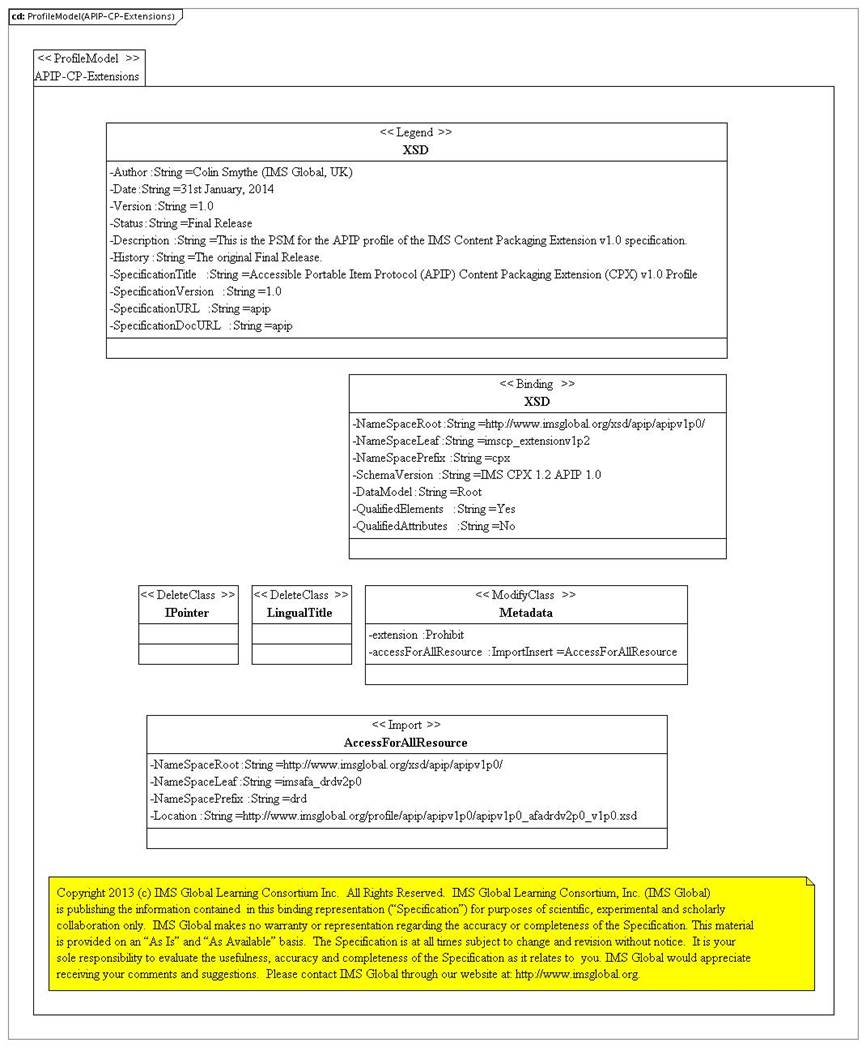
Figure B3.6 Content packaging extension APIP profile PSM.
B4 Profiled LOM v1.0 PSM
The PSMs for the profiled IEEE LOM are shown in Figures B4.1, B4.2, B4.3, B4.4, B4.5, B4.6, B4.7, B4.8, B4.9, B4.710, B4.11, B4.712 and B4.13.
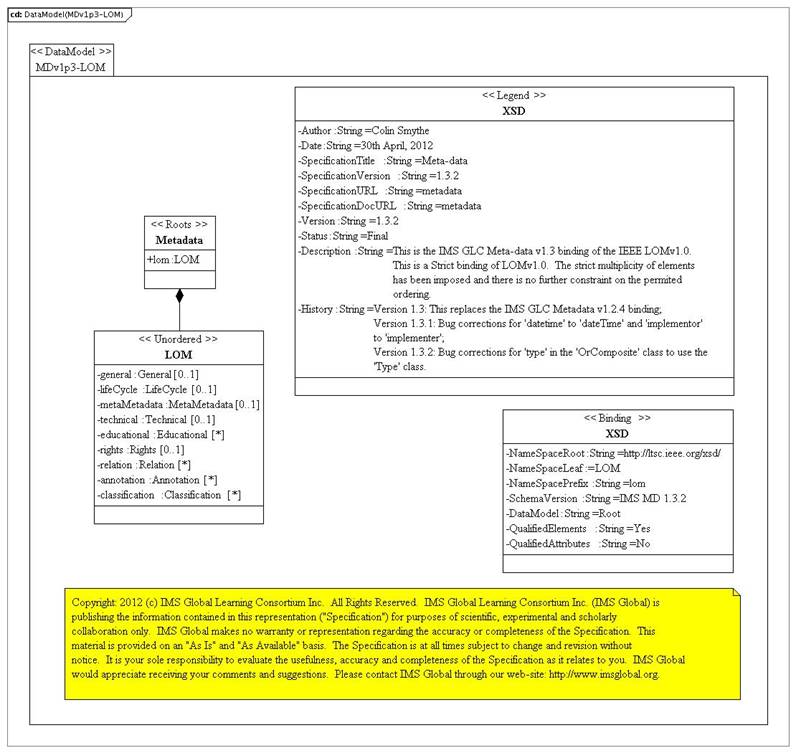
Figure B4.1 LOM root PSM.

Figure B4.2 LOM general PSM.
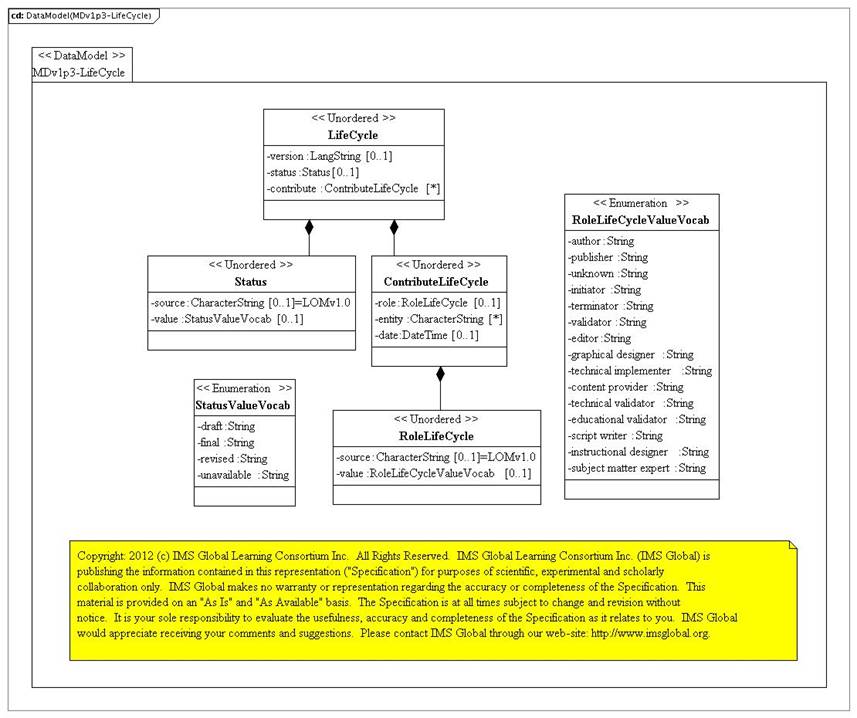
Figure B4.3 LOM lifecycle PSM.
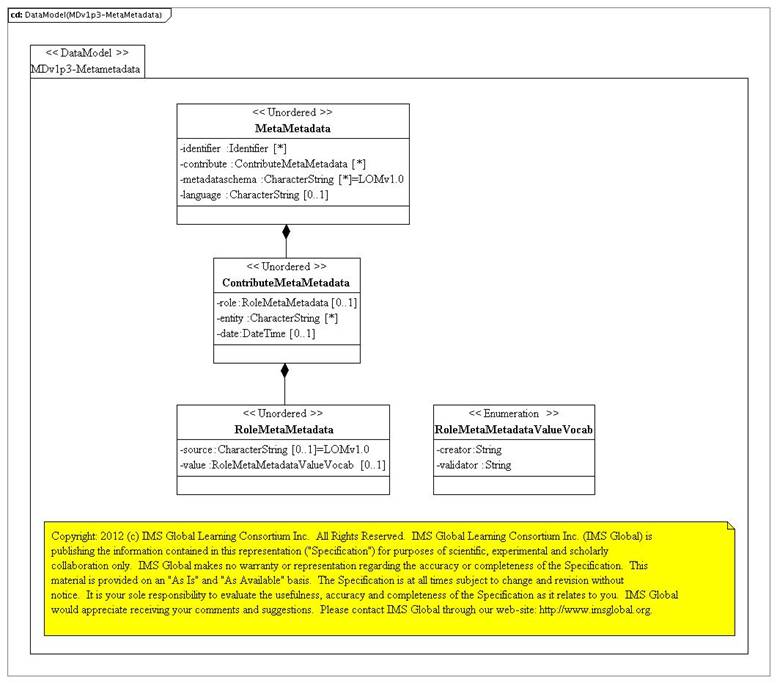
Figure B4.4 LOM meta-metadata PSM.
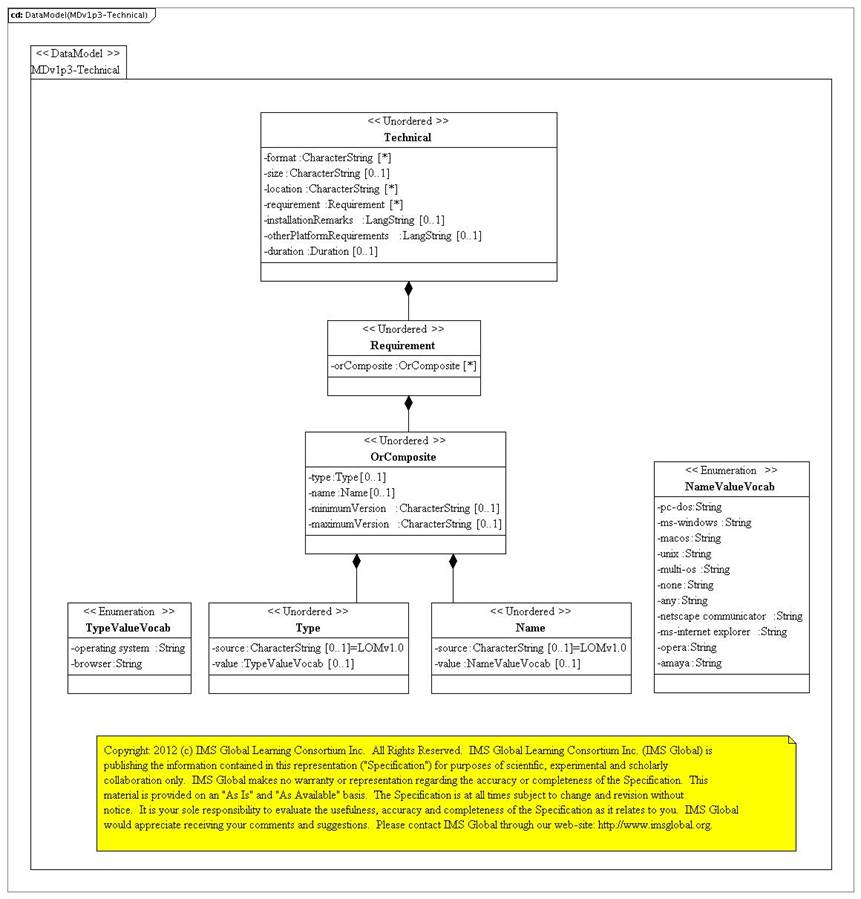
Figure B4.5 LOM technical PSM.
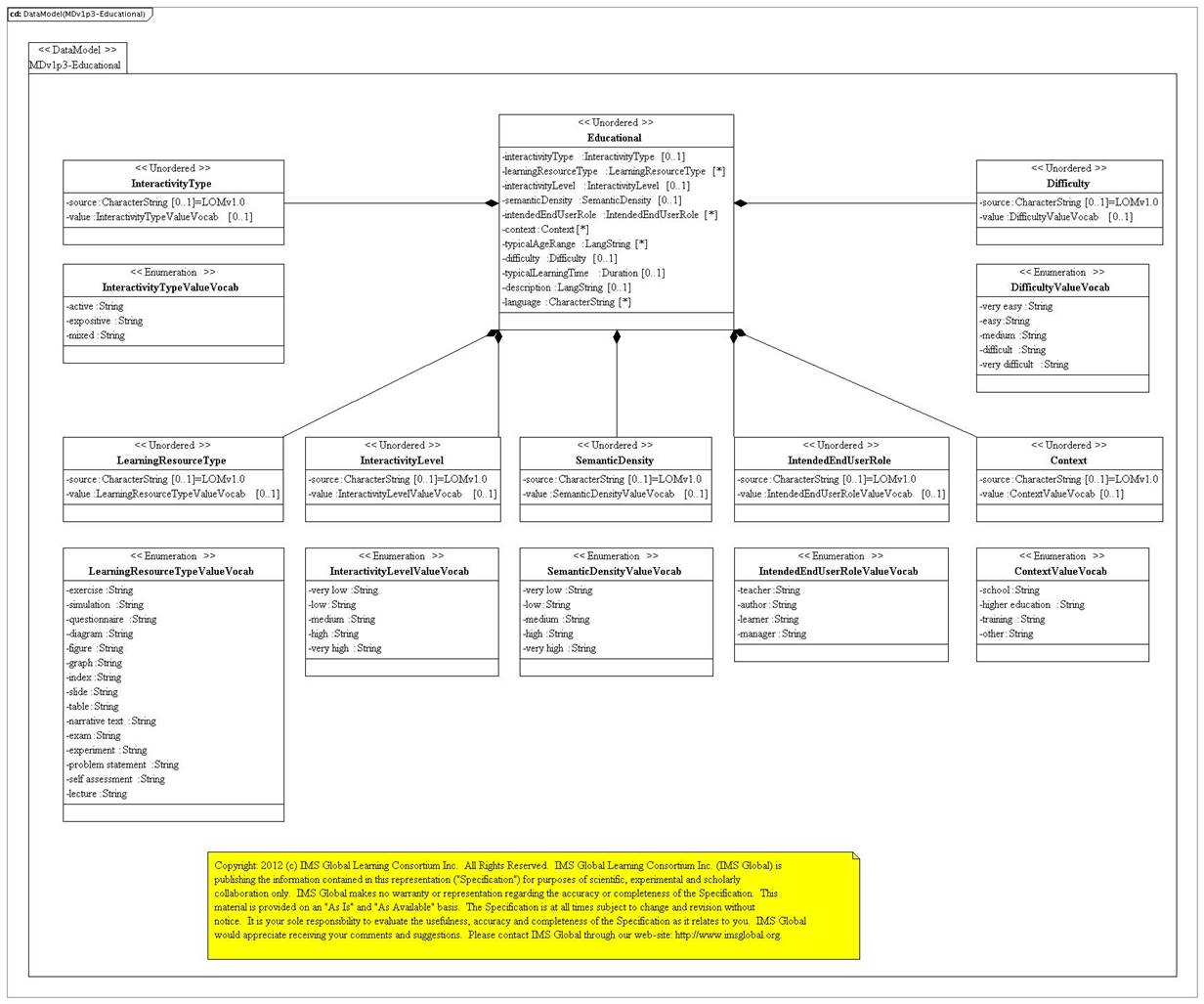
Figure B4.6 LOM educational PSM.
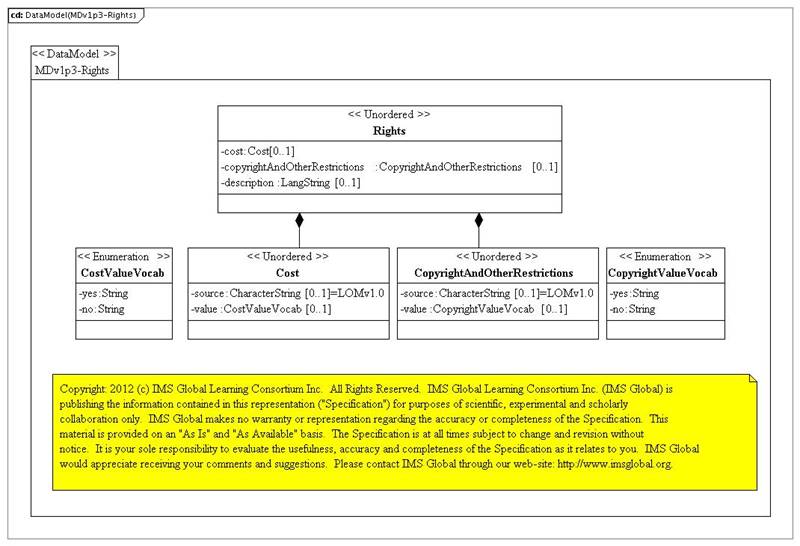
Figure B4.7 LOM rights PSM.
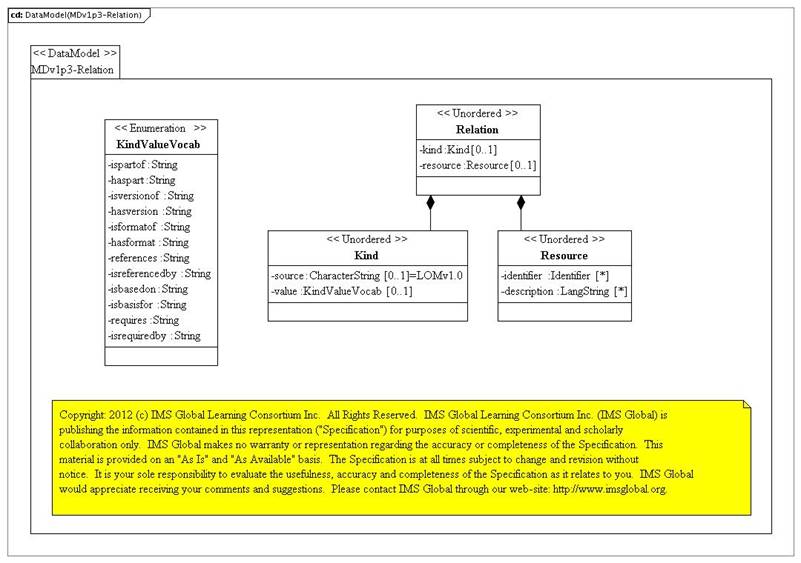
Figure B4.8 LOM relation PSM.
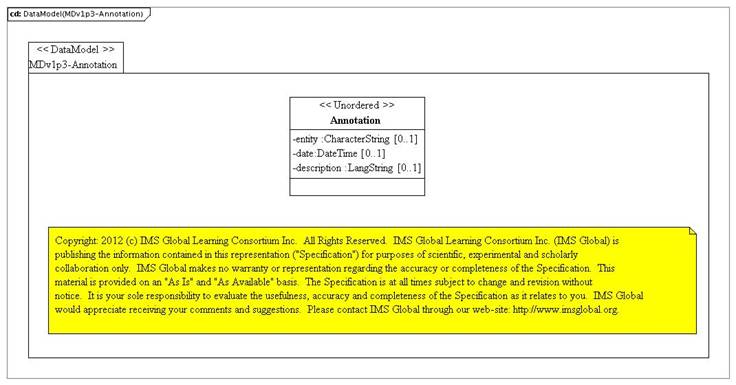
Figure B4.9 LOM annotation PSM.

Figure B4.10 LOM classification PSM.
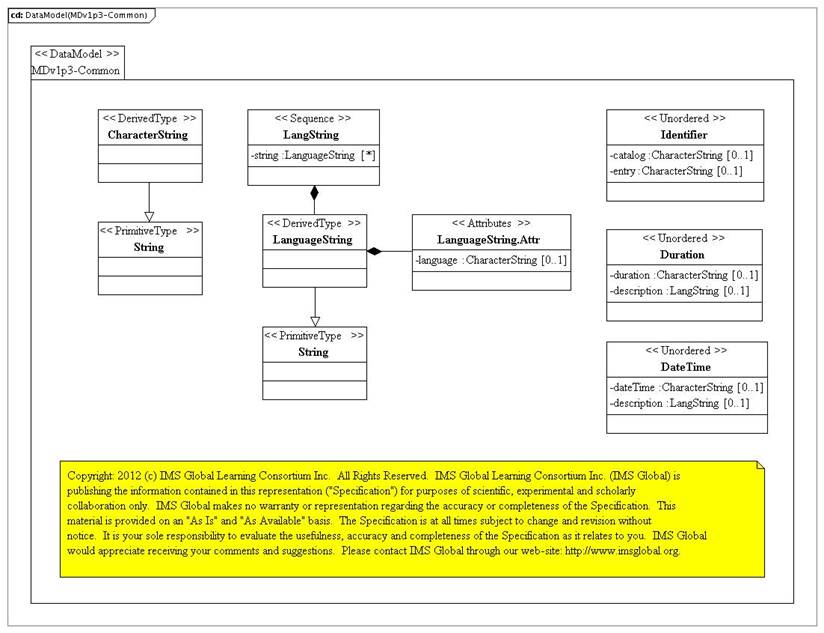
Figure B4.11 LOM common PSM.
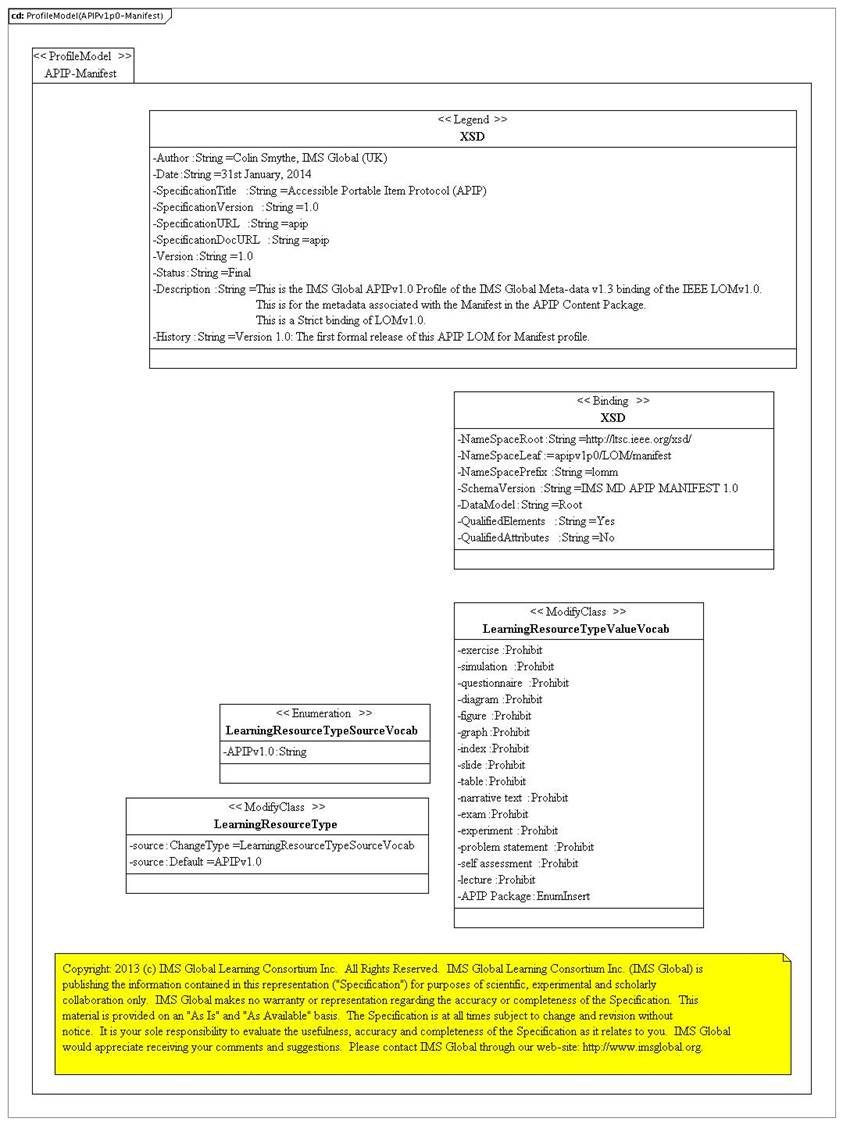
Figure B4.12 LOM APIP manifest profile PSM.
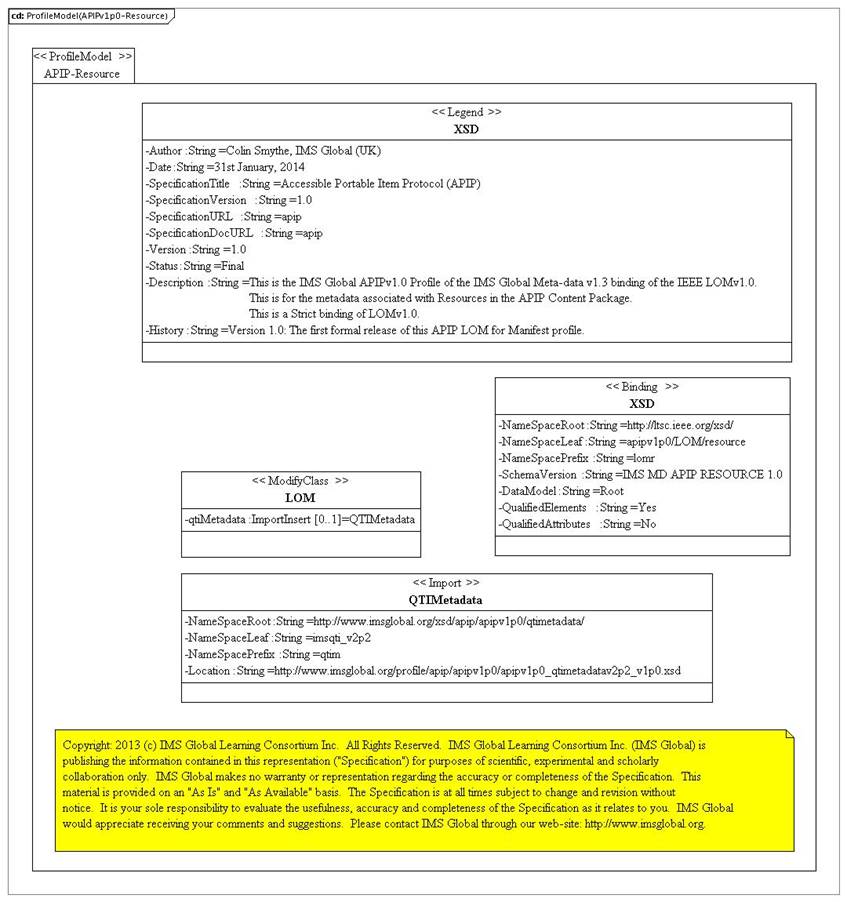
Figure B4.13 LOM resource profile PSM.
B5 Curriculum Standards Metadata v1.0 PSM
The PSM for the Curriculum Standards Metadata is shown in Figures B5.1 and B5.2.
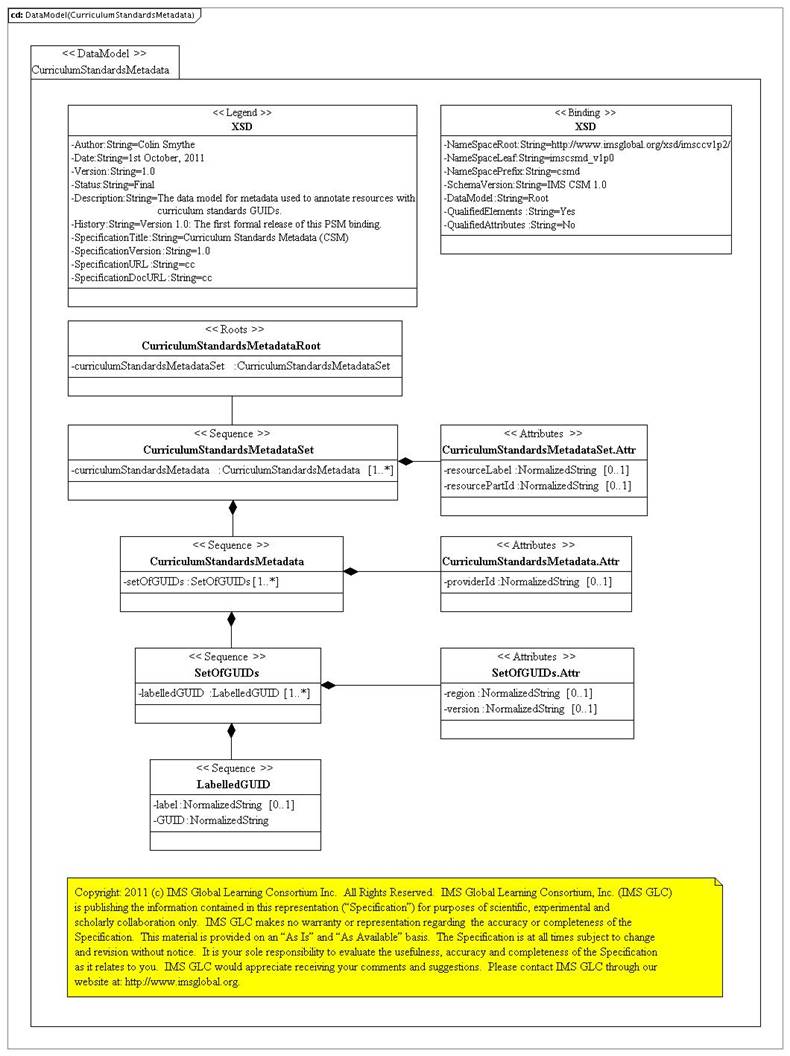
Figure B5.1 Curriculum standards metadata PSM.

Figure B5.1 CSM APIP profle PSM.
B6 AfA DRD v2.0 PSM
The PSMs for the profiled AfA DRD are shown in Figures B8.1 and B8.2.
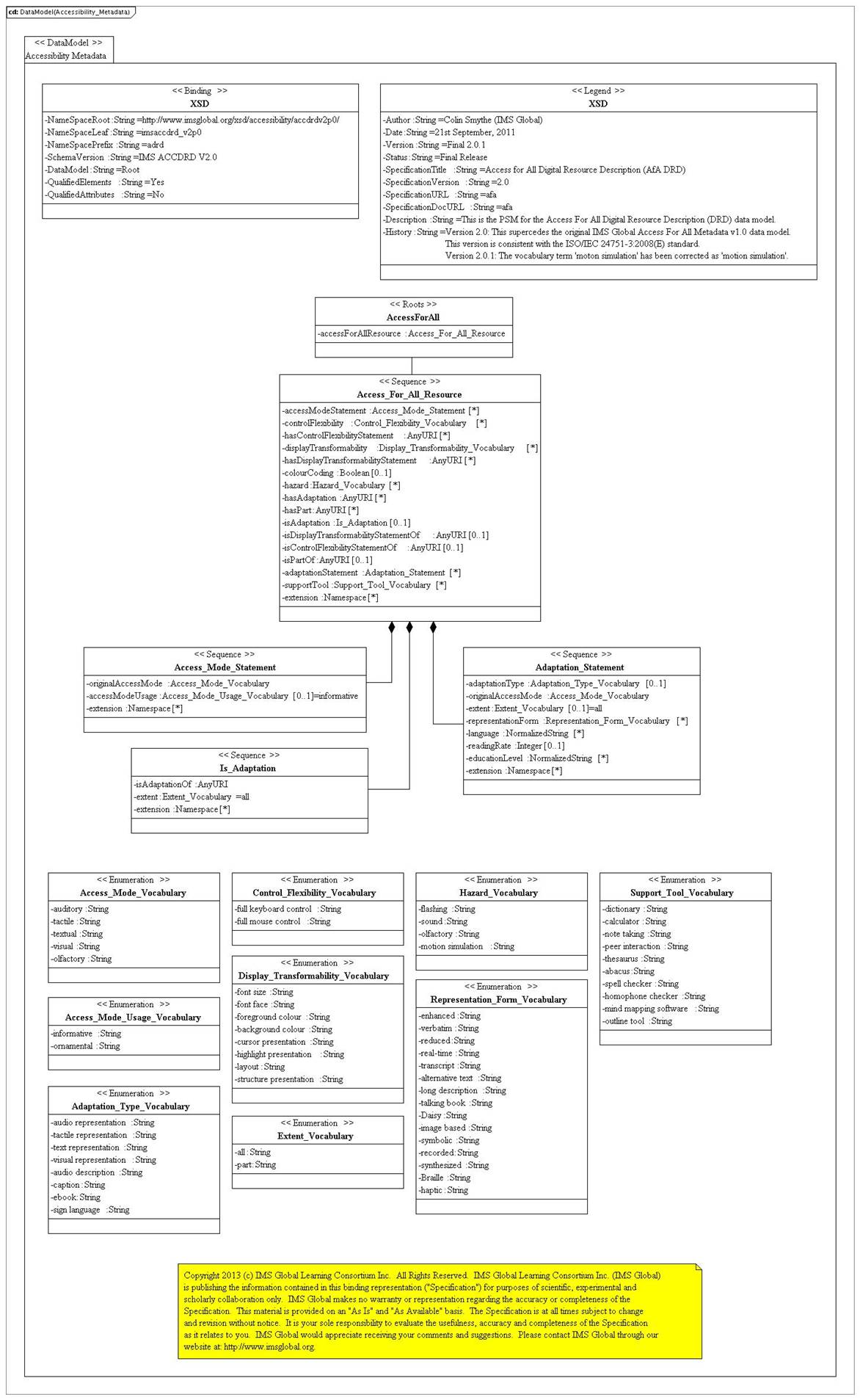
Figure B6.1 Profiled AfA DRD v2.0 PSM.
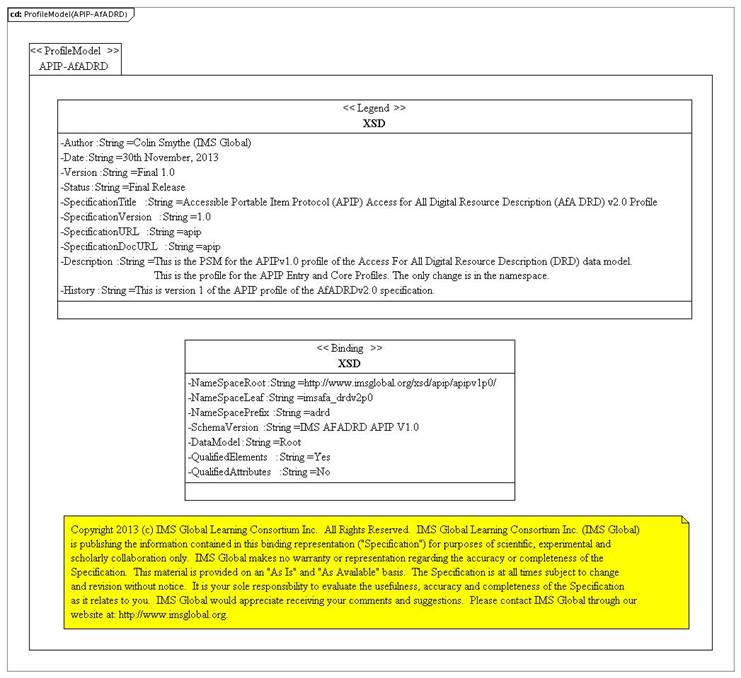
Figure B6.2 AfA DRD v2.0 APIP profile PSM.
B7 Learning Tools Interoperability v1.1 PSM
The PSMs used to support the definition of the LTI classes are shown in Figures B7.1 to B7.7.
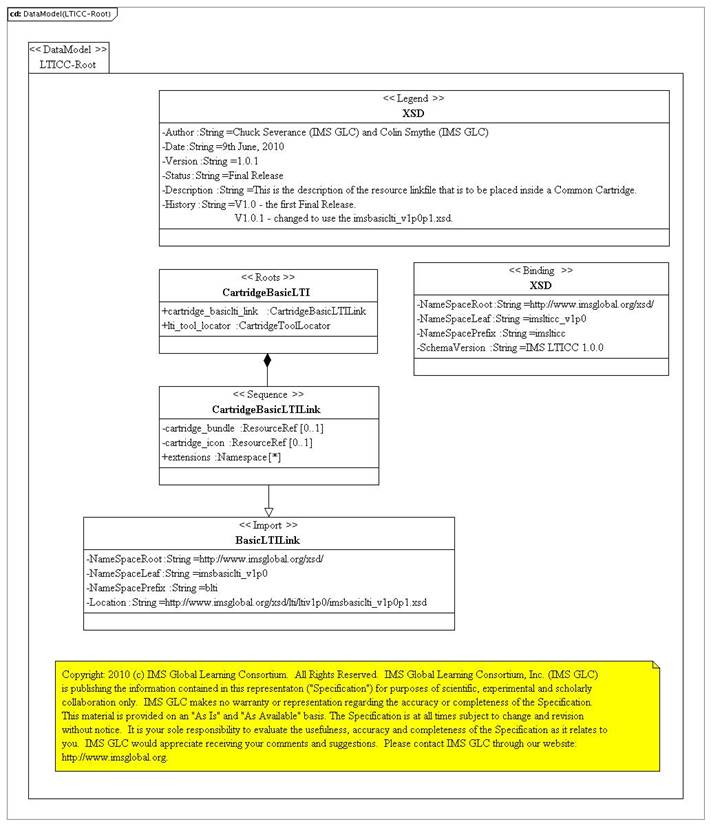
Figure B7.1 LTI common cartridge root PSM.

Figure B7.2 LTI link root PSM.

Figure B7.3 LTI link PSM.
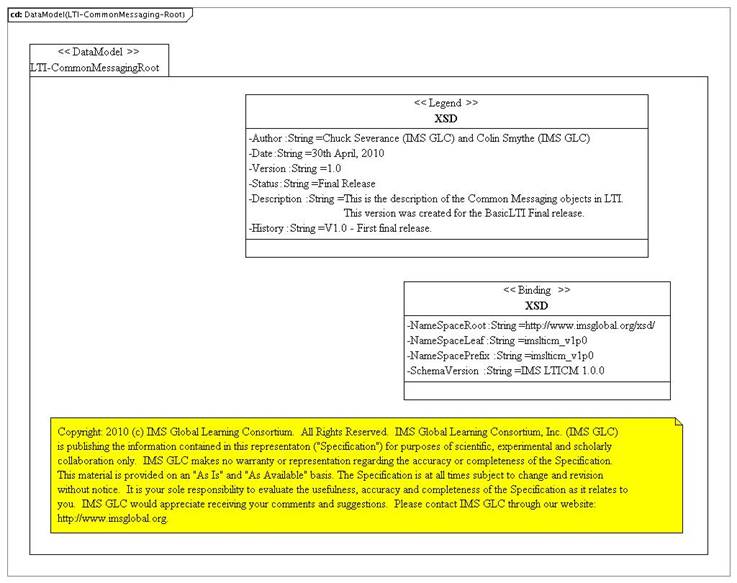
Figure B7.4 LTI property root PSM.
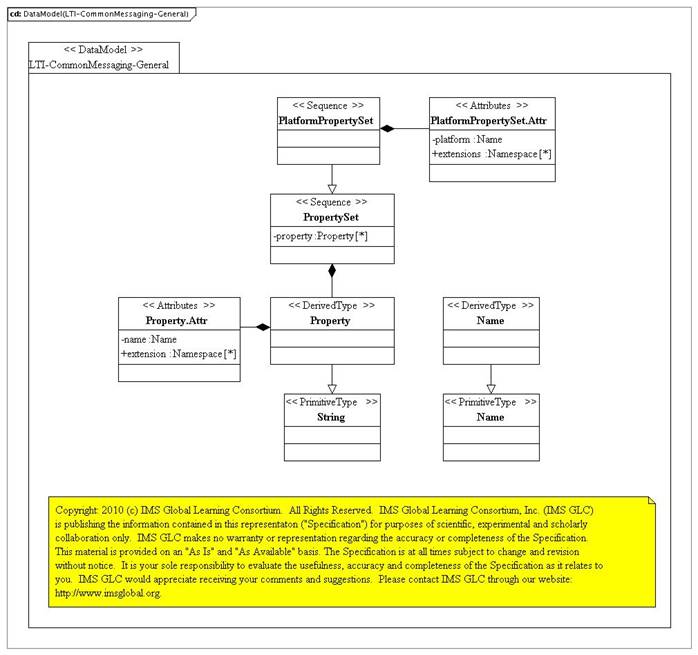
Figure B7.5 LTI property PSM.
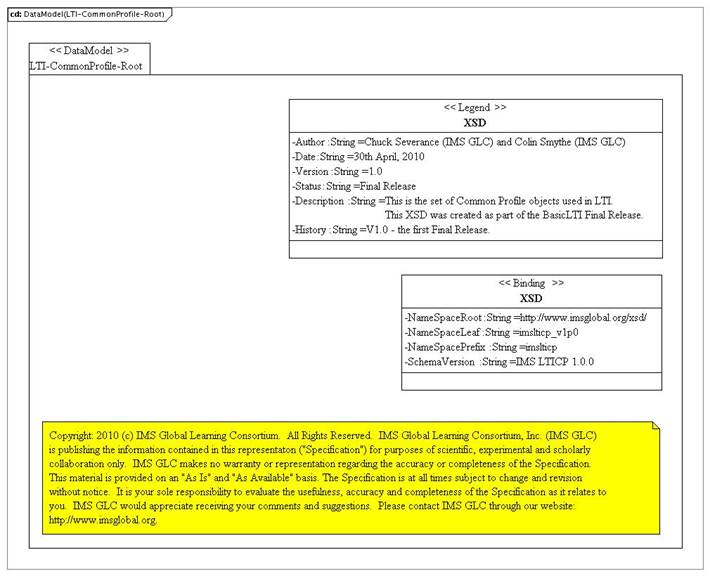
Figure B7.6 LTI common root PSM.
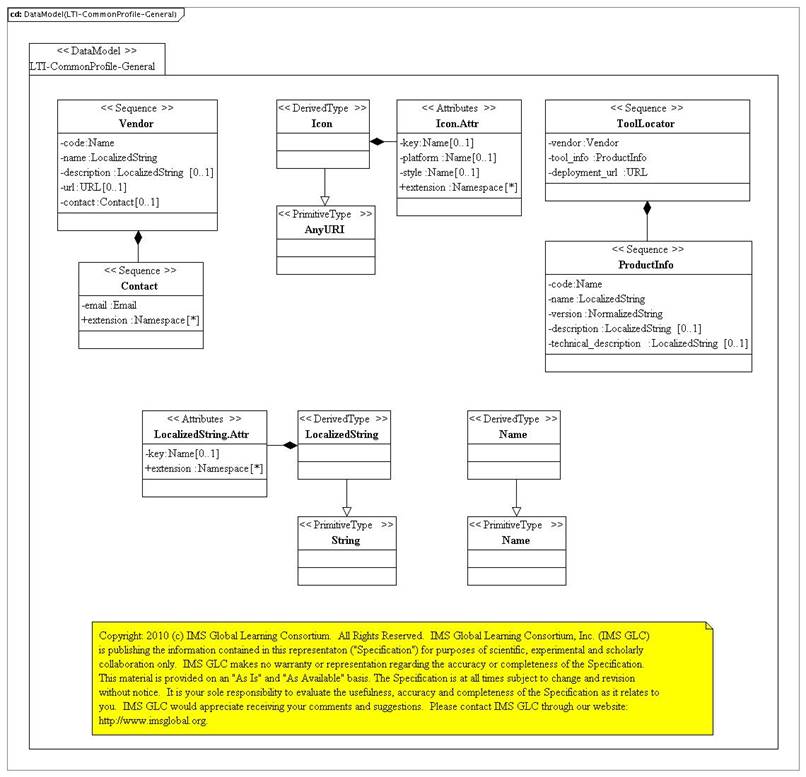
Figure B7.7 LTI common PSM.
B8 Profiled AfA PNP v2.0 PSM
The PSMs for the profiled AfA PNP are shown in Figures B8.1, B8.2, B8.3, B8.4, B8.5, B8.6a, B8.6b and B8.7.

Figure B8.1 Profiled AfA PNP v2.0 root PSM.
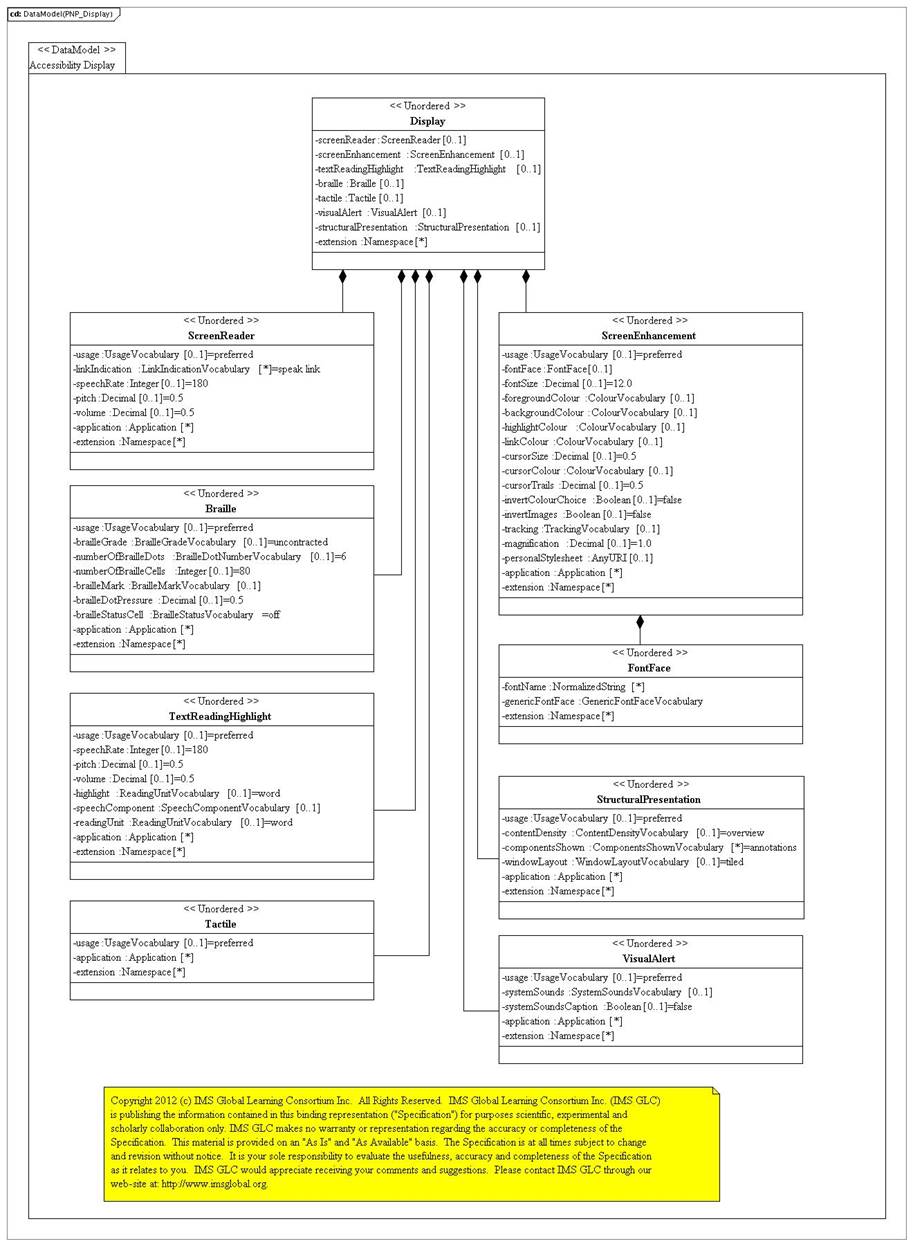
Figure B8.2 Profiled AfA PNP v2.0 display PSM.

Figure B8.3 Profiled AfA PNP v2.0 control PSM.
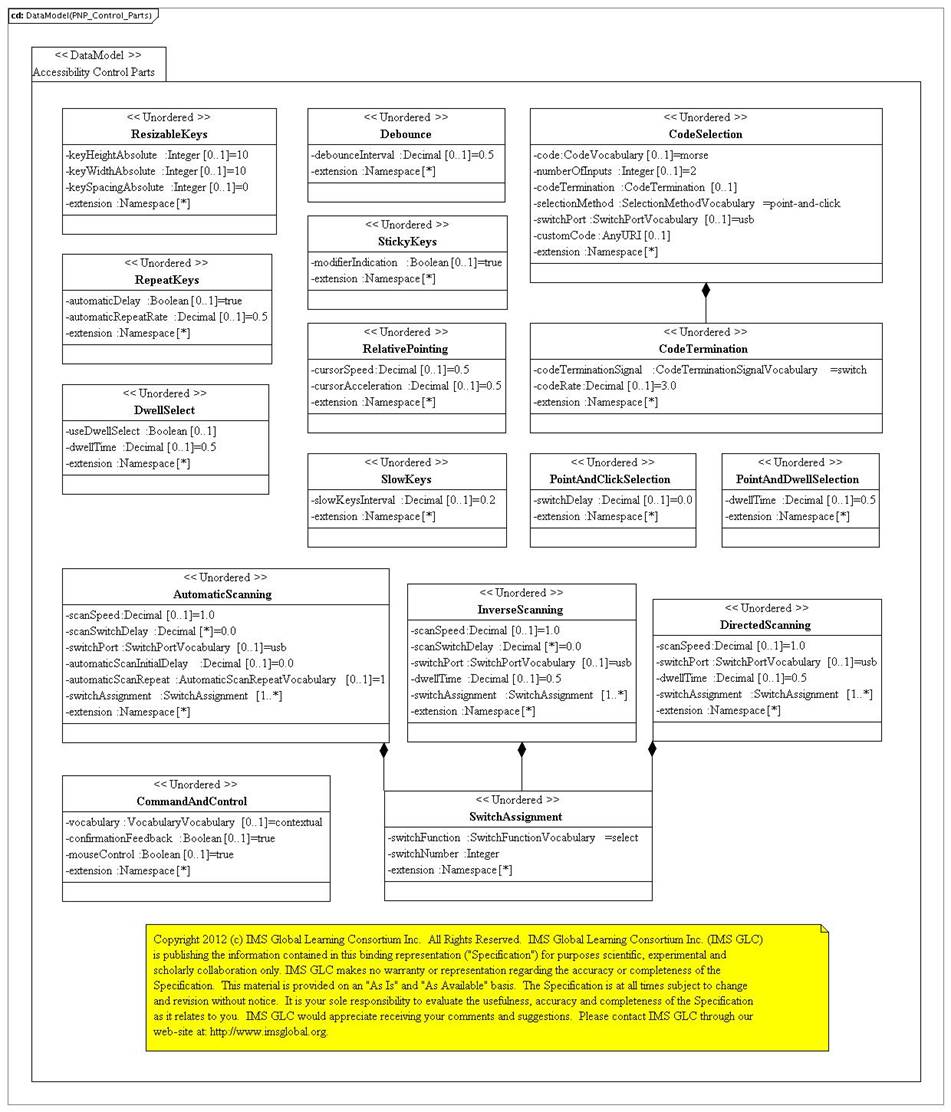
Figure B8.4 Profiled AfA PNP v2.0 control parts PSM.
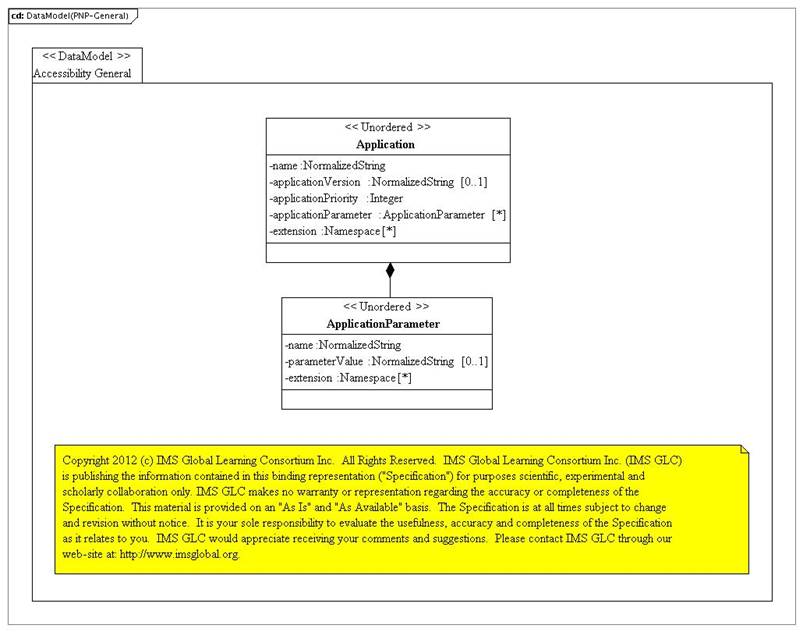
Figure B8.5 Profiled AfA PNP v2.0 general PSM.
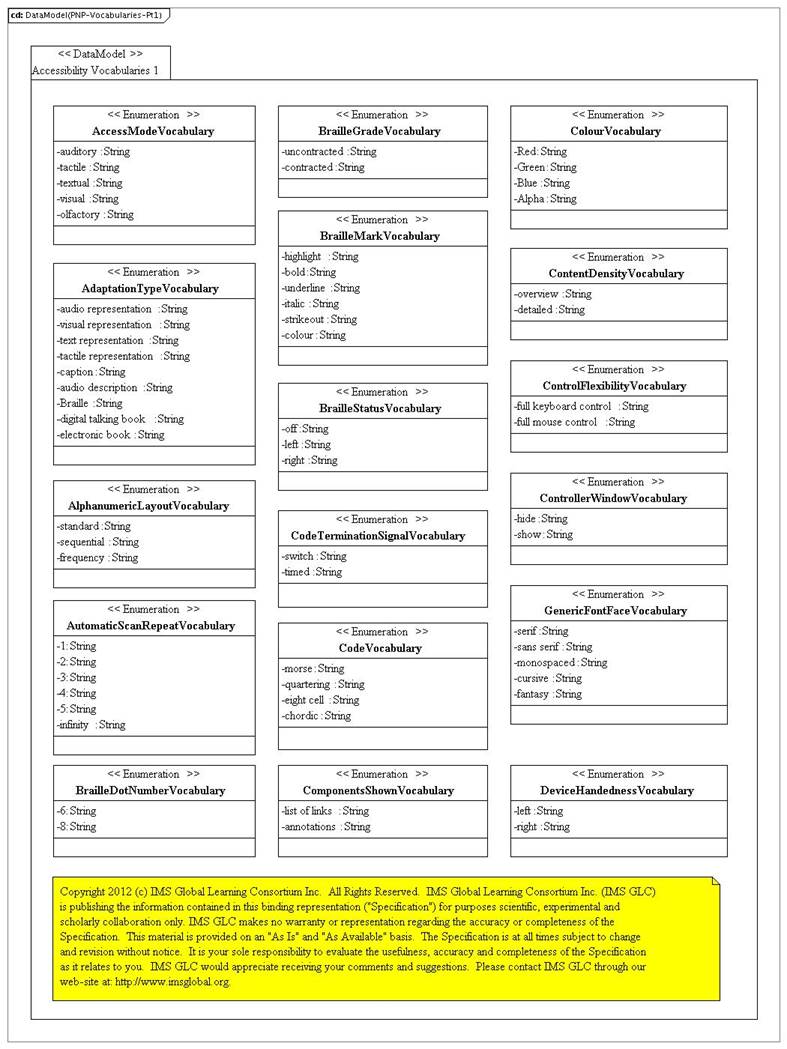
Figure B8.6a Profiled AfA PNP v2.0 vocabularies PSM.
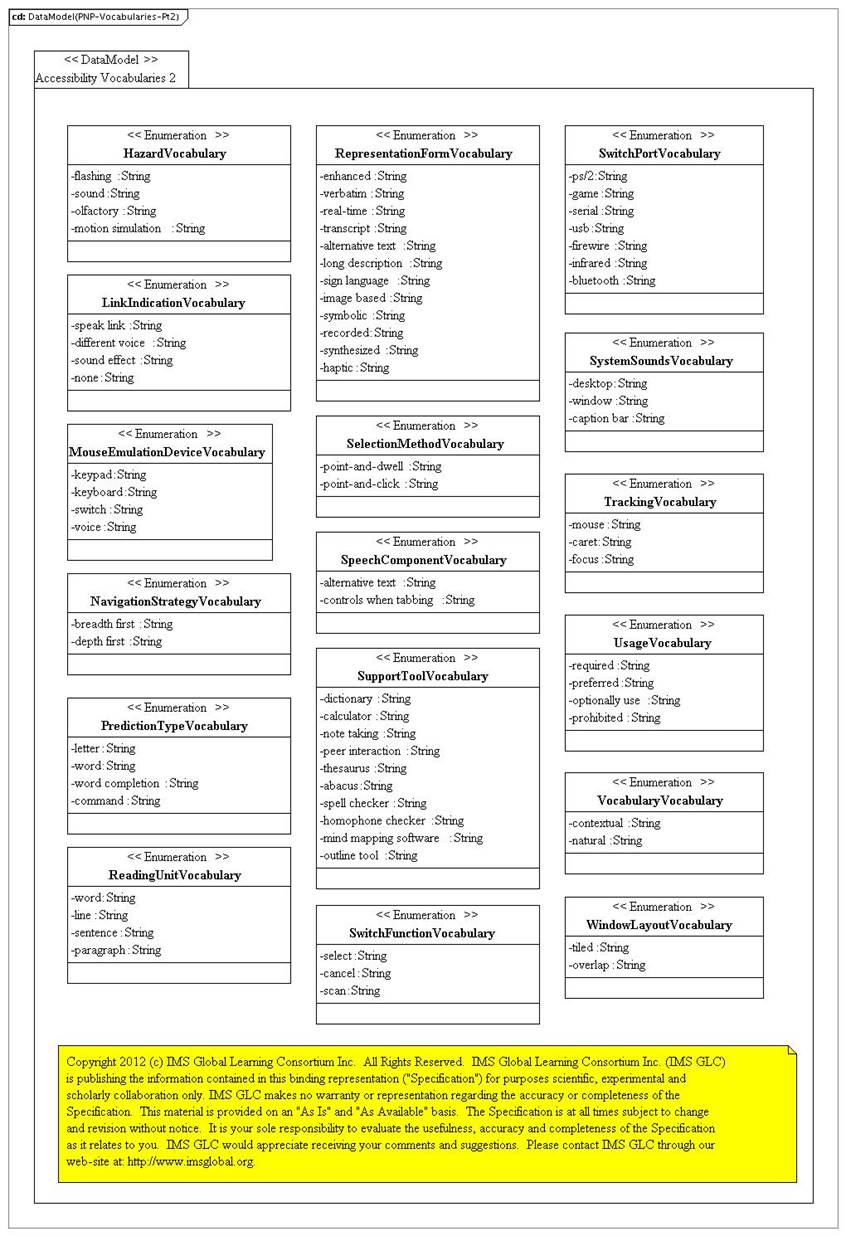
Figure B8.6b Profiled AfA PNP v2.0 vocabularies PSM.
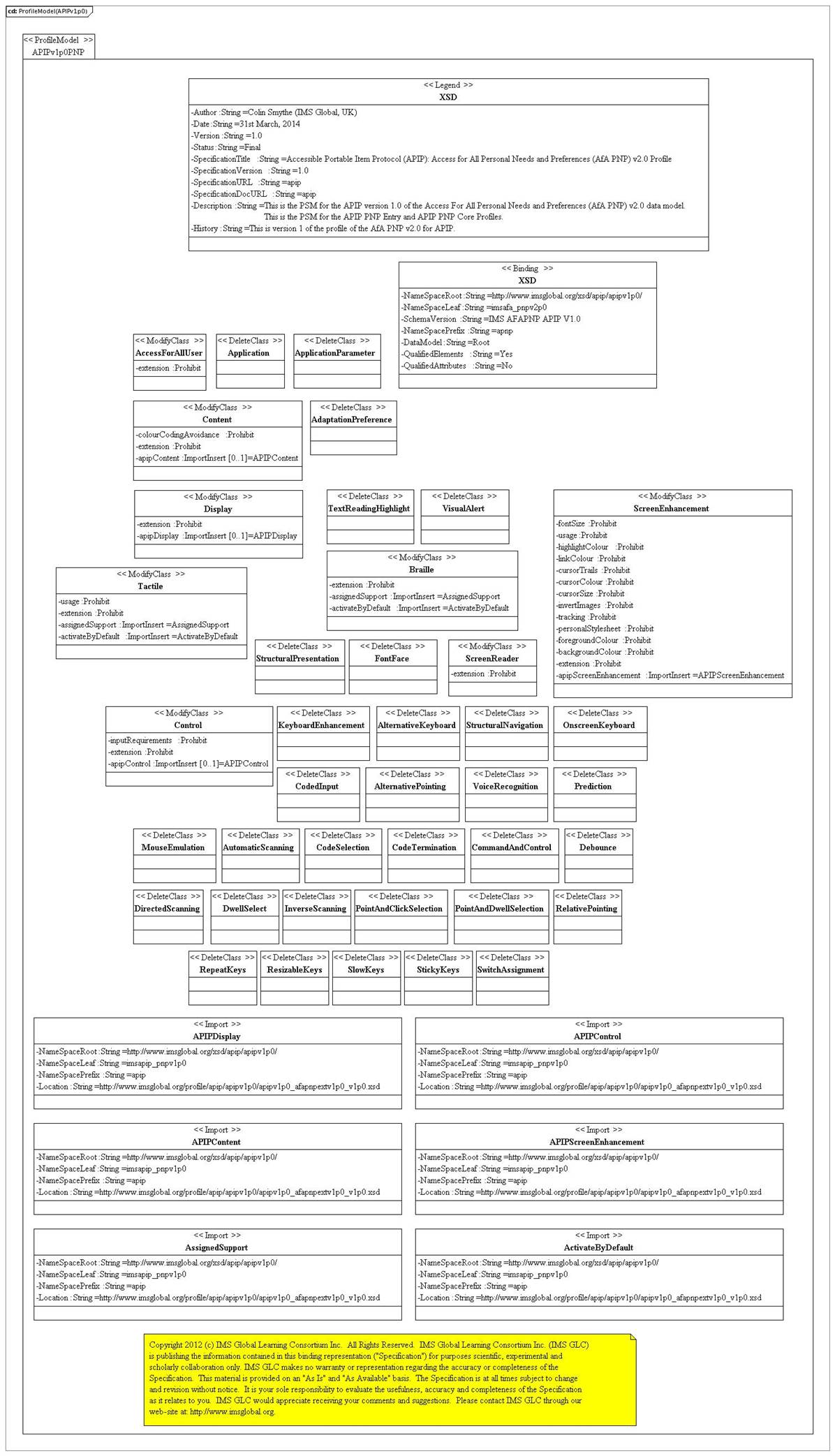
Figure B8.7 Profiled AfA PNP v2.0 APIP profile PSM.
B9 AfA PNP v2.0 APIP Extensions PSM
The PSMs for the AfA PNP accessibility extension information are shown in Figures B9.1, B9.1, B9.3, B9.4, B9.5, B9.6, B9.7 and B2.8.
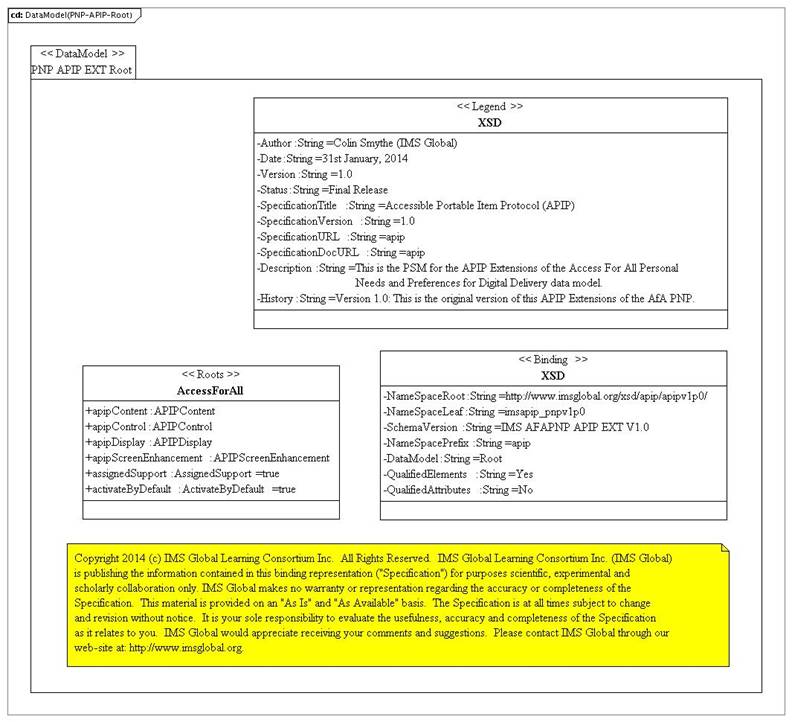
Figure B9.1 AfA PNP extension root PSM.
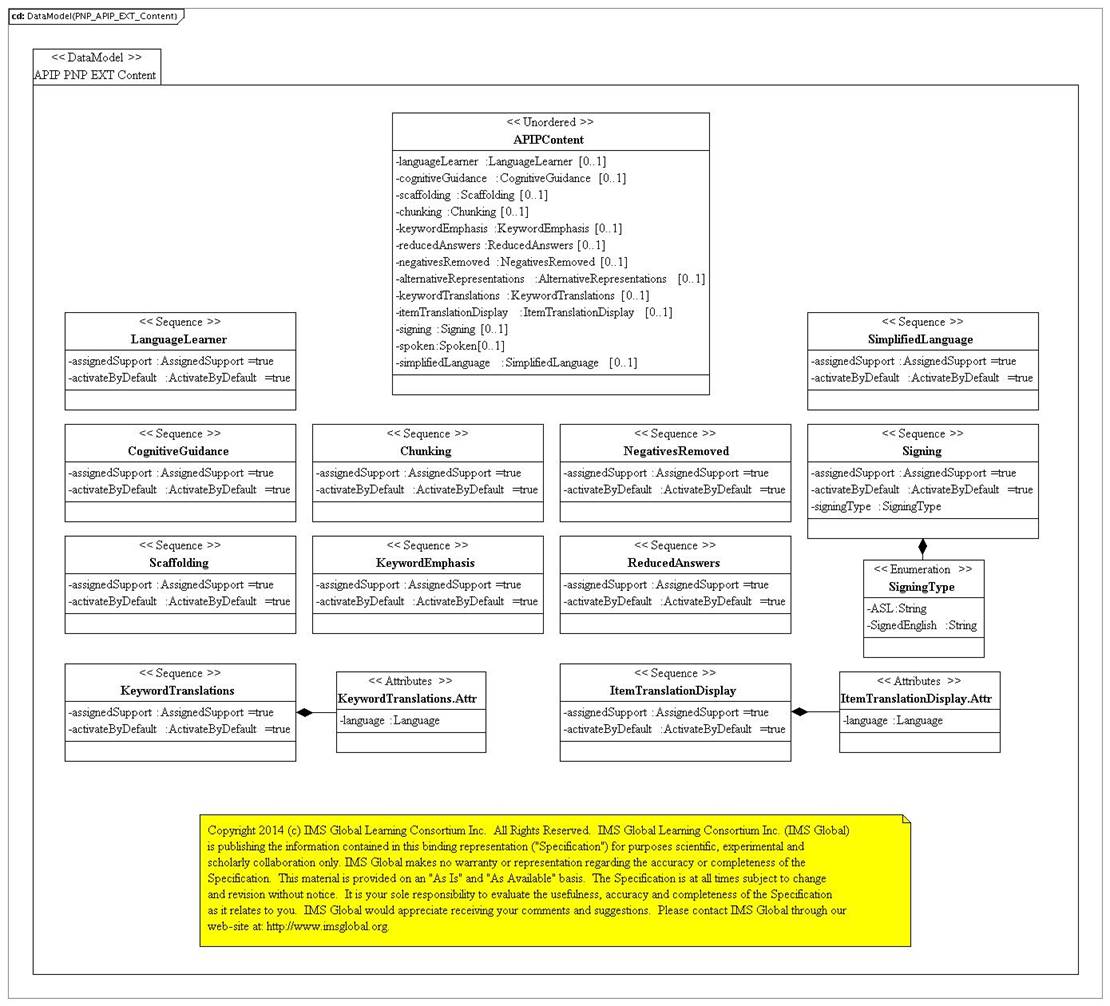
Figure B9.2 AfA PNP extension content PSM.
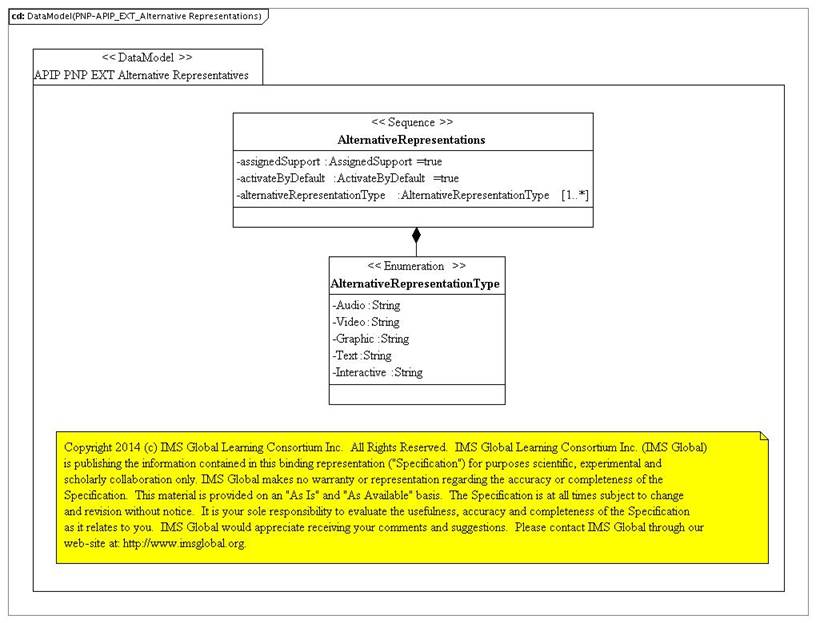
Figure B9.3 AfA PNP extension alternative representation PSM.
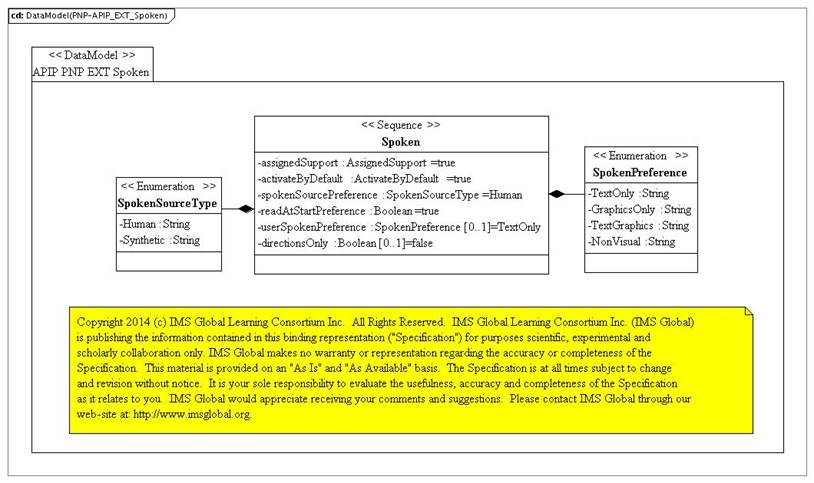
Figure B9.4 AfA PNP extension spoken PSM.
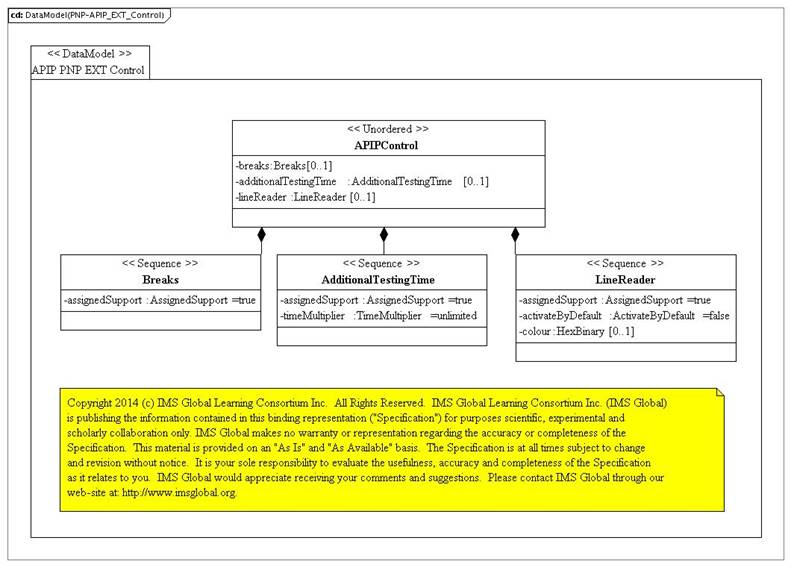
Figure B9.5 AfA PNP extension control PSM.
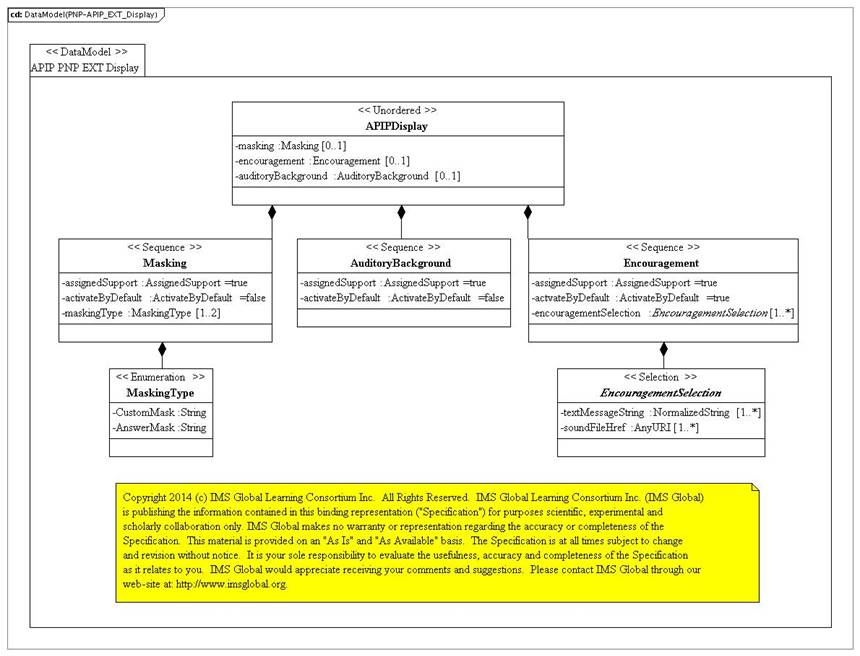
Figure B9.6 AfA PNP extension display PSM.

Figure B9.7 AfA PNP extension screen enhancement PSM.
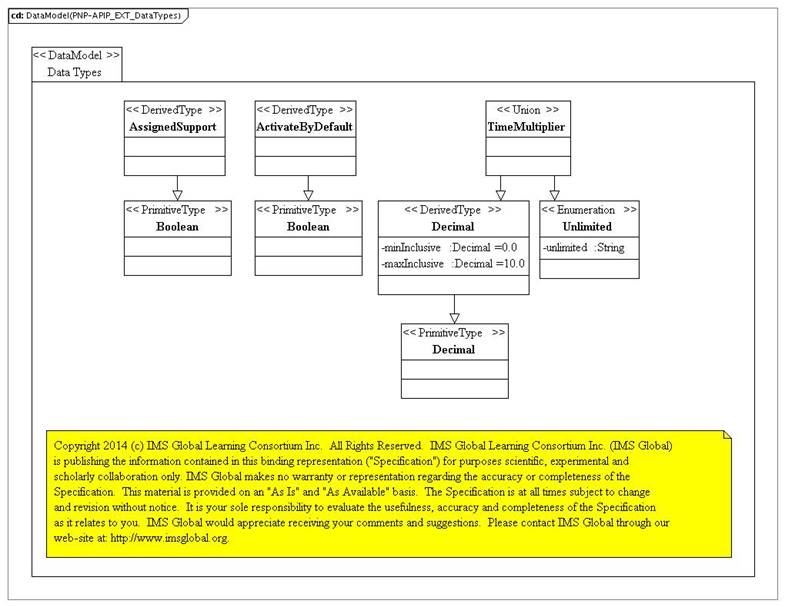
Figure B9.8 AfA PNP extension data types PSM.
B10 APIP AfA PNP Records PSM
The PSMs for the APIP AfA PNP Records information are shown in Figures B10.1 and B10.2.
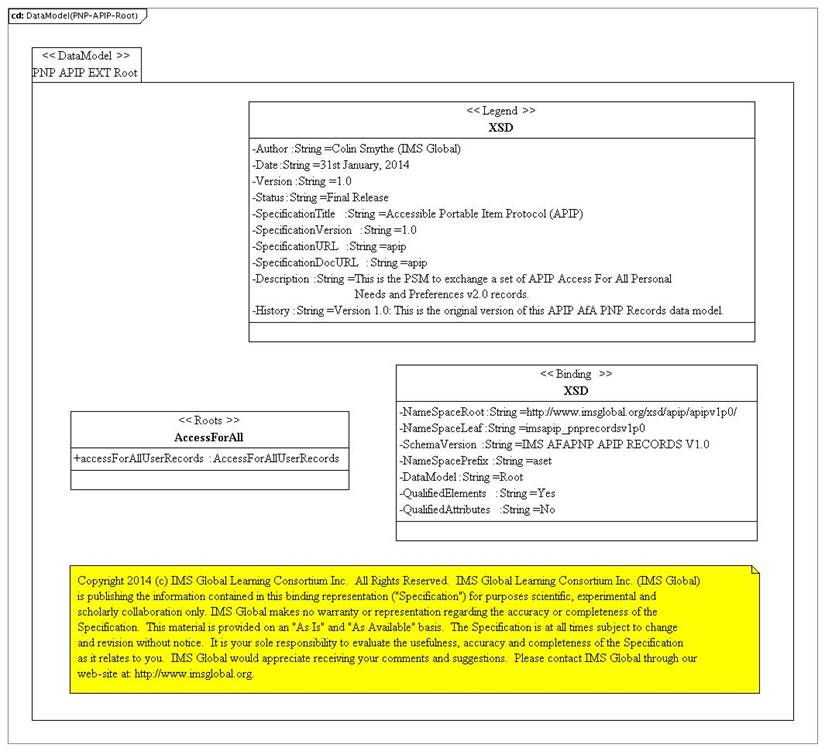
Figure B10.1 APIP AfA PNP records root PSM.

Figure B10.2 APIP AfA PNP records PSM.
Appendix C XSD Binding for the Profile
C1 Namespace Summary
The summary for the set of APIP namespaces is given in Table C1.1.
Table C1.1 Namespace summary.
|
Namespace |
Usage |
|
http://www.imsglobal.org/xsd/apip/apipv1p0/imscp_v1p1 |
APIP Manifest file. |
|
http://www.imsglobal.org/xsd/apip/apipv1p0/imscp_extensionv1p2 |
APIP Manifest file. |
|
http://www.imsglobal.org/xsd/apip/apipv1p0/qtiitem/imsqti_v2p2 |
AIP Item file. |
|
http://www.imsglobal.org/xsd/apip/apipv1p0/qtisection/imsqti_v2p2 |
APIP Section file. |
|
http://www.imsglobal.org/xsd/apip/apipv1p0/qtitest/imsqti_v2p2 |
APIP Test file. |
|
http://www.imsglobal.org/xsd/apip/apipv1p0/qtiresproc/imsqti_v2p2 |
APIP Response Processing Template file. |
|
http://www.imsglobal.org/xsd/apip/apipv1p0/qtioutcomes/imsqti_v2p2 |
APIP Outcomes Declaration file. |
|
http://www.imsglobal.org/xsd/apip/apipv1p0/qtistimulus/imsqti_v2p2 |
APIP Shared Stimulus file. |
|
http://www.imsglobal.org/xsd/apip/apipv1p0/imsapip_qtiv1p0 |
APIP QTI extensions features in Item, Section and Test files. |
|
http://ltsc.ieee.org/xsd/apipv1p0/LOM/manifest |
Manifest Metadata in the APIP Manifest file. |
|
http://ltsc.ieee.org/xsd/apipv1p0/LOM/resource |
Resource Metadata in the APIP Manifest file. |
|
http://www.imsglobal.org/xsd/apip/apipv1p0/qtimetadata/imsqti_v2p2 |
QTI Metadata in Resource Metadata in APIP Manifest file. |
|
http://www.imsglobal.org/xsd/apip/apipv1p0/imscsmd_v1p0 |
Curriculum Standards Metadata in the APIP Manifest file. |
|
http://www.imsglobal.org/xsd/apip/apipv1p0/imsafa_pnpv2p0 |
APIP AfA PNP file. |
|
http://www.imsglobal.org/xsd/apip/apipv1p0/imsapip_pnpv1p0 |
APIP AfA PNP extension features in APIP AfA PNP files. |
|
http://www.imsglobal.org/xsd/apip/apipv1p0/imsapip_pnprecordsv1p0 |
Bulk APIP AfA PNP records file. |
|
http://www.imsglobal.org/xsd/imsbasiclti_v1p0 |
LTI Description in the APIP Manifest file. |
|
http://www.imsglobal.org/xsd/imslticc_v1p0 |
LTI Description in the APIP Manifest file. |
|
http://www.imsglobal.org/xsd/imslticp_v1p0 |
LTI Description in the APIP Manifest file. |
|
http://www.imsglobal.org/xsd/imslticm_v1p0 |
LTI Description in the APIP Manifest file. |
|
http://www.imsglobal.org/services/ltiv1p1/xsd/imsoms_v1p0 |
Outcomes POX service message. |
C2 Profiled XSD Details
The set of XSDs created for this Profile are listed below.
C2.1 Profiled CPv1.2 XSD Details
|
File Name: |
apipv1p0_imscpv1p2_v1p0.xsd |
|
Schema Location: |
http://www.imsglobal.org/profile/apip/apipv1p0/apipv1p0_imscpv1p2_v1p0.xsd |
|
Name-space: |
http://www.imsglobal.org/xsd/apip/apipv1p0/imscp_v1p1 |
|
Description: |
The profile of the original CP v1.2 specification to reflect support for QTI Items and the APIP v1.0 requirements, and to include support for the new APIP features. |
C2.2 Profiled CPv1.2 Extensions XSD Details
|
File Name: |
apipv1p0_cpextv1p2_v1p0.xsd |
|
Schema Location: |
http://www.imsglobal.org/profile/apip/apipv1p0/apipv1p0_cpextv1p2_v1p0.xsd |
|
Name-space: |
http://www.imsglobal.org/xsd/apip/apipv1p0/imscp_extensionv1p2 |
|
Description: |
The profile of the CP v1.2 specification extensions to reflect support for APIP v1.0 requirements. |
C2.3 Profiled QTI v2.2 Item XSD Details
|
File Name: |
apipv1p0_qtiitemv2p2_v1p0.xsd |
|
Schema Location: |
http://www.imsglobal.org/profile/apip/apipv1p0/apipv1p0_qtiitemv2p2_v1p0.xsd |
|
Name-space: |
http://www.imsglobal.org/xsd/apip/apipv1p0/qtiitem/imsqti_v2p2 |
|
Description: |
The profile of the original QTI v2.2 specification to reflect the APIP v1.0 requirements and to include support for the APIP QTI extensions for Items. |
C2.4 Profiled QTI v2.2 Section XSD Details
|
File Name: |
apipv1p0_qtisectionv2p2_v1p0.xsd |
|
Schema Location: |
http://www.imsglobal.org/profile/apip/apipv1p0/apipv1p0_qtisectionv2p2_v1p0.xsd |
|
Name-space: |
http://www.imsglobal.org/xsd/apip/apipv1p0/qtisection/imsqti_v2p2 |
|
Description: |
The profile of the original QTI v2.2 specification to reflect the APIP v1.0 requirements and to include support for the APIP QTI extensions for Sections. |
C2.5 Profiled QTI v2.2 Test XSD Details
|
File Name: |
apipv1p0_qtitestv2p2_v1p0.xsd |
|
Schema Location: |
http://www.imsglobal.org/profile/apip/apipv1p0/apipv1p0_qtitestv2p2_v1p0.xsd |
|
Name-space: |
http://www.imsglobal.org/xsd/apip/apipv1p0/qtitest/imsqti_v2p2 |
|
Description: |
The profile of the original QTI v2.2 specification to reflect the APIP v1.0 requirements and to include support for the APIP QTI extensions for Tests. |
C2.6 Profiled QTI v2.2 Response Processing XSD Details
|
File Name: |
apipv1p0_qtiresprocessingv2p2_v1p0.xsd |
|
Schema Location: |
http://www.imsglobal.org/profile/apip/apipv1p0/apipv1p0_qtiresprocessingv2p2_v1p0.xsd |
|
Name-space: |
http://www.imsglobal.org/xsd/apip/apipv1p0/qtiresproc/imsqti_v2p2 |
|
Description: |
The profile of the original QTI v2.2 specification to reflect the APIP v1.0 requirements for the use of response processing templates. |
C2.7 Profiled QTI v2.2 Outcome Declaration XSD Details
|
File Name: |
apipv1p0_qtioutcomesv2p2_v1p0.xsd |
|
Schema Location: |
http://www.imsglobal.org/profile/apip/apipv1p0/apipv1p0_qtioutcomesv2p2_v1p0.xsd |
|
Name-space: |
http://www.imsglobal.org/xsd/apip/apipv1p0/qtioutcomes/imsqti_v2p2 |
|
Description: |
The profile of the original QTI v2.2 specification to reflect the APIP v1.0 requirements for linking outcomes with curriculum standards. |
C2.8 Profiled QTI v2.2 Shared Stimulus Declaration XSD Details
|
File Name: |
apipv1p0_qtistimulusv2p2_v1p0.xsd |
|
Schema Location: |
http://www.imsglobal.org/profile/apip/apipv1p0/apipv1p0_qtistimulusv2p2_v1p0.xsd |
|
Name-space: |
http://www.imsglobal.org/xsd/apip/apipv1p0/qtistimulus/imsqti_v2p2 |
|
Description: |
The profile of the original QTI v2.2 specification to reflect the APIP v1.0 requirements for exchanging shared stimulus content. |
C2.9 APIP QTI Extensions (Full) XSD Details
|
File Name: |
apipv1p0_qtiextv2p2_v1p0.xsd |
|
Schema Location: |
http://www.imsglobal.org/profile/apip/apipv1p0/apipv1p0_qtiextv2p2_v1p0.xsd |
|
Name Space: |
http://www.imsglobal.org/xsd/apip/apipv1p0/imsapip_qtiv1p0 |
|
Description: |
The full set of extensions to the QTIv2.2 specification that were created for APIPv1.0. |
C2.10 Profiled Manifest Metadata (LOM) XSD Details
|
File Name: |
apipv1p0_lommanifestv1p0_v1p0.xsd |
|
Schema Location: |
http://www.imsglobal.org/profile/apip/apipv1p0/apipv1p0_lommanifestv1p0_v1p0.xsd |
|
Name Space: |
http://ltsc.ieee.org/xsd/apipv1p0/LOM/manifest |
|
Description: |
The profile of the LOMv1.0 for the APIPv1.0 CP manifest. |
C2.11 Profiled Resource Metadata (LOM) XSD Details
|
File Name: |
apipv1p0_lomresourcev1p0_v1p0.xsd |
|
Schema Location: |
http://www.imsglobal.org/profile/apip/apipv1p0/apipv1p0_lomresourcev1p0_v1p0.xsd |
|
Name Space: |
http://ltsc.ieee.org/xsd/apipv1p0/LOM/resource |
|
Description: |
The profile of the LOMv1.0 for resources contained within the APIPv1.0 CP manifest. |
C2.12 Profiled QTI v2.2 Metadata XSD Details
|
File Name: |
apipv1p0_qtimetadatav2p2_v1p0.xsd |
|
Schema Location: |
http://www.imsglobal.org/profile/apip/apipv1p0/apipv1p0_qtimetadatav2p2_v1p0.xsd |
|
Name-space: |
http://www.imsglobal.org/xsd/apip/apipv1p0/qtimetadata/imsqti_v2p2 |
|
Description: |
The profile of the original QTI v2.2 specification to reflect the APIP v1.0 QTI metadata requirements. |
C2.13 Curriculum Standards Metadata v1.0 XSD Details
|
File Name: |
apipv1p0_imscsmdv1p0_v1p0.xsd |
|
Schema Location: |
http://www.imsglobal.org/profile/apip/apipv1p0/apipv1p0_imscsmdv1p0_v1p0.xsd |
|
Name-space: |
http://www.imsglobal.org/xsd/apip/apipv1p0/imscsmd_v1p0 |
|
Description: |
The original CSM specification to reflect the APIP v1.0 curriculum standards metadata annotations. |
C2.14 AfA DRD v2.0 XSD Details
|
File Name: |
apipv1p0_afadrdv2p0_v1p0.xsd |
|
Schema Location: |
http://www.imsglobal.org/profile/apip/apipv1p0/apipv1p0_afadrdv2p0_v1p0.xsd |
|
Name-space: |
http://www.imsglobal.org/xsd/apip/apipv1p0/imsafa_drd_v2p0 |
|
Description: |
The original AfA DRD v2.0 specification to reflect the APIP v1.0 variant metadata annotations. |
C2.15 Profiled AfA PNP v2.0 XSD Details
|
File Name: |
apipv1p0_afapnpv2p0_v1p0.xsd |
|
Schema Location: |
http://www.imsglobal.org/profile/apip/apipv1p0/apipv1p0_afapnpv2p0_v1p0.xsd |
|
Name Space: |
http://www.imsglobal.org/xsd/apip/apipv1p0/imsafa_pnpv2p0 |
|
Description: |
The profile of the original AfA PNP v2.0 specification to reflect the APIP v1.0 requirements and to include support for the APIP PNP extensions. |
C2.16 APIP AfA PNP v2.0 Extensions (Full) XSD Details
|
File Name: |
apipv1p0_afapnpextv1p0_v1p0.xsd |
|
Schema Location: |
http://www.imsglobal.org/profile/apip/apipv1p0/apipv1p0_afapnpextv1p0_v1p0.xsd |
|
Name Space: |
http://www.imsglobal.org/xsd/apip/apipv1p0/imsapip_pnpv1p0 |
|
Description: |
The set of extensions to the AfAPNP v2.0 specification that were created for APIP. |
C2.17 Bulk APIP AfA PNP v2.0 XSD Details
|
File Name: |
apipv1p0_afapnpv2p0records_v1p0.xsd |
|
Schema Location: |
http://www.imsglobal.org/profile/apip/apipv1p0/apipv1p0_afapnpv2p0records_v1p0.xsd |
|
Name Space: |
http://www.imsglobal.org/xsd/apip/apipv1p0/imsapip_pnprecordsv1p0 |
|
Description: |
A new XSD defined for the exchange of a set of PNP records in a single bulk PNP XM instance file. |
C2.18 LTI v1.1 XSD Details
|
File Name: |
imsbasiclti_v1p0p1.xsd |
|
Schema Location: |
http://www.imsglobal.org/xsd/lti/ltiv1p0/imsbasiclti_v1p0p1.xsd |
|
Name Space: |
http://www.imsglobal.org/xsd/imsbasiclti_v1p0 |
|
Description: |
From the original LTI v1.1 specification. |
|
|
|
|
File Name: |
imslticc_v1p0p1.xsd |
|
Schema Location: |
http://www.imsglobal.org/xsd/lti/ltiv1p0/imslticc_v1p0p1.xsd |
|
Name Space: |
http://www.imsglobal.org/xsd/imslticc_v1p0 |
|
Description: |
From the original LTI v1.1 specification. |
|
File Name: |
imslticp_v1p0.xsd |
|
Schema Location: |
|
|
Name Space: |
http://www.imsglobal.org/xsd/imslticp_v1p0 |
|
Description: |
From the original LTI v1.1 specification. |
|
|
|
File Name: |
imslticm_v1p0.xsd |
|
Schema Location: |
|
|
Name Space: |
http://www.imsglobal.org/xsd/imslticm_v1p0 |
|
Description: |
From the original LTI v1.1 specification. |
|
|
|
File Name: |
OMSv1p0_LTIv1p1Profile_SyncXSD_v1p0.xsd |
|
Schema Location: |
http://www.imsglobal.org/xsd/lti/ltiv1p0/OMSv1p0_LTIv1p1Profile_SyncXSD_v1p0.xsd |
|
Name Space: |
http://www.imsglobal.org/services/ltiv1p1/xsd/imsoms_v1p0 |
|
Description: |
From the original LTI v1.1 specification. This is used to support the LTI grade reporting service. |
|
|
|
About the Document
Title: 1EdTech Accessible Portable Item Protocol (APIP): Technical Specification
Editors: Colin Smythe (1EdTech), Mark McKell (1EdTech) and Mike Russell (Measured Progress)
Co-chairs: Gary Driscoll (ETS), Tom Hoffmann (Measured Progress) and Wayne Ostler (Pearson)
Version: 1.0
Version Date: 31 March 2014
Status: Final Specification
Summary: The aim of the APIP Project is to use well established e-learning interoperability standards to enable the exchange of accessible assessment content between computer-based assessment systems, tools and applications. Users of systems, tools and applications that adopt the APIP are able to use their accessible assessment content on a wide range of systems. This document contains the definition of the APIP in terms of its component base specifications and their corresponding profiles.
Purpose: This document is made available for adoption by the public community at large.
Document Location: http://www.imsglobal.org/apip/
List of Contributors
The following individuals contributed to the development of this document:
|
Rob Abel, 1EdTech (USA) |
Justin Marks, NWEA (USA) |
|
Michael Aumock, Pacific Metrics (USA) |
Mark McKell, 1EdTech (USA) |
|
Marty Christensen, ACT (USA) |
Sue Milne, JISC (UK) |
|
Jason Craft, Pearson (USA) |
Wayne Ostler, Pearson (USA) |
|
Gary Driscoll, ETS (USA) |
Zack Pierce, Measured Progress (USA) |
|
Eric Hansen, ETS (USA) |
Michelle Richard, Pearson (USA) |
|
Regina Hoag, ETS (USA) |
Mike Russell, Measured Progress (USA) |
|
Thomas Hoffmann, Measured Progress (USA) |
Farhat Siddiqui, ETS (USA) |
|
Wilbert Kraan, JISC (UK) |
Colin Smythe, 1EdTech (UK) |
|
Devin Loftis, McGraw-Hill/CTB (USA) |
Wyatt VanderStucken, ETS (USA) |
Revision History
|
Version No. |
Release Date |
Comments |
|
Final Specification v1.0 |
31 March 2014 |
The Final Specification version of this document. |
|
|
|
|
1EdTech Consortium, Inc. ("1EdTech") is publishing the information contained in this document ("Specification") for purposes of scientific, experimental, and scholarly collaboration only.
1EdTech makes no warranty or representation regarding the accuracy or completeness of the Specification.
This material is provided on an "As Is" and "As Available" basis.
The Specification is at all times subject to change and revision without notice.
It is your sole responsibility to evaluate the usefulness, accuracy, and completeness of the Specification as it relates to you.
1EdTech would appreciate receiving your comments and suggestions.
Please contact 1EdTech through our website at http://www.imsglobal.org.
Please refer to Document Name: 1EdTech APIP Technical Specification Final Specification v1.0
Date: 31 March 2014
[1] In most cases the Preferences Server will also contain PNP information other than that required by APIP.
[2] The directory/folder structure suggested for the APIP package is not mandated but it is considered best practice (the approach is taken from the recommendations in the 1EdTech Common Cartridge specification [CC, 11].
[3] CSS 3.0 is now available and later releases of the QTIv2.1 specification will address its usage. APIP compliant systems are recommended to support CSS 3.0.


